
- Yucatan Peninsula
- Central Mexico
- Pacific Coast
- Northern Mexico
- Mexican Culture
- Trip Planning

22 Easy Basic Spanish Phrases for Travel in Mexico

When traveling to Mexico, understanding the language is important for getting around. As a Spanish speaking country, it’s not always guaranteed that locals will know how to speak your country’s language. That’s why knowing a few basic Spanish phrases for travel can go a long way toward helping you have a fun and stress-free vacation, especially if you're traveling with kids.
Our family has traveled extensively throughout Mexico, visiting eleven states in the country. And having an understanding of essential Spanish phrases has tremendously helped make our experiences in Mexico memorable and positive.
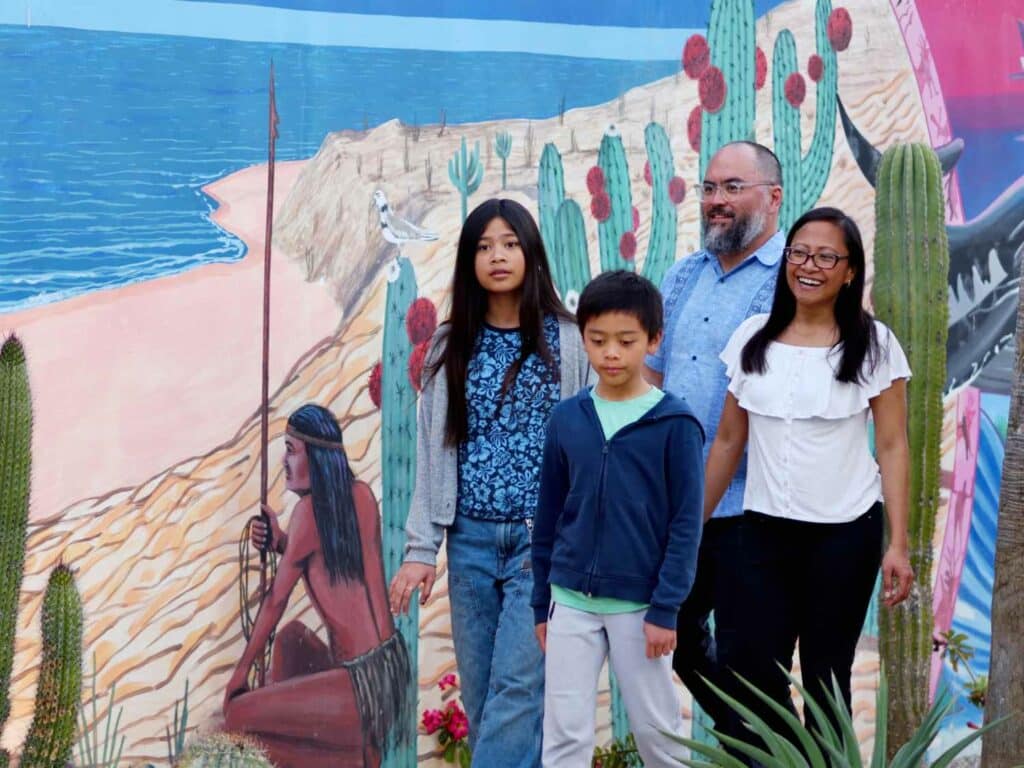
Spanish is spoken all throughout Mexico. And while some people at hotels, tour companies, and restaurants do speak English, it’s not always a given that you’ll have an English-speaker at your disposal, or any other language like French or Chinese.
You may find yourself having to ask for directions, make reservations at a hotel, or needing to order food in Spanish. Learning some Spanish before embarking on your family trip Mexico adventure will be extremely helpful.
This article was originally published on June 10, 2021.
This post may contain affiliate links. That means this blog will receive a small commission if you click on the link and purchase something. However, this will not result in any extra costs to you.
Table of Contents
Top tips for learning Spanish
Want some quick tips for learning Spanish? Here are my top 3 recommendations for learning basic Spanish for travel in Mexico.
- Learn Spanish through movies and TV with Lingopie
- Grab a copy of the Easy Spanish Phrasebook
- Download my Basic Spanish Travel Phrases free pdf guide
Apps for language learning
If you're looking for an app to get started, the Duolingo app is helpful in introducing basic Spanish phrases for travel. Other apps you can download, such as Busuu and Lyrics Training , are also helpful for training your ear to hear Spanish words.
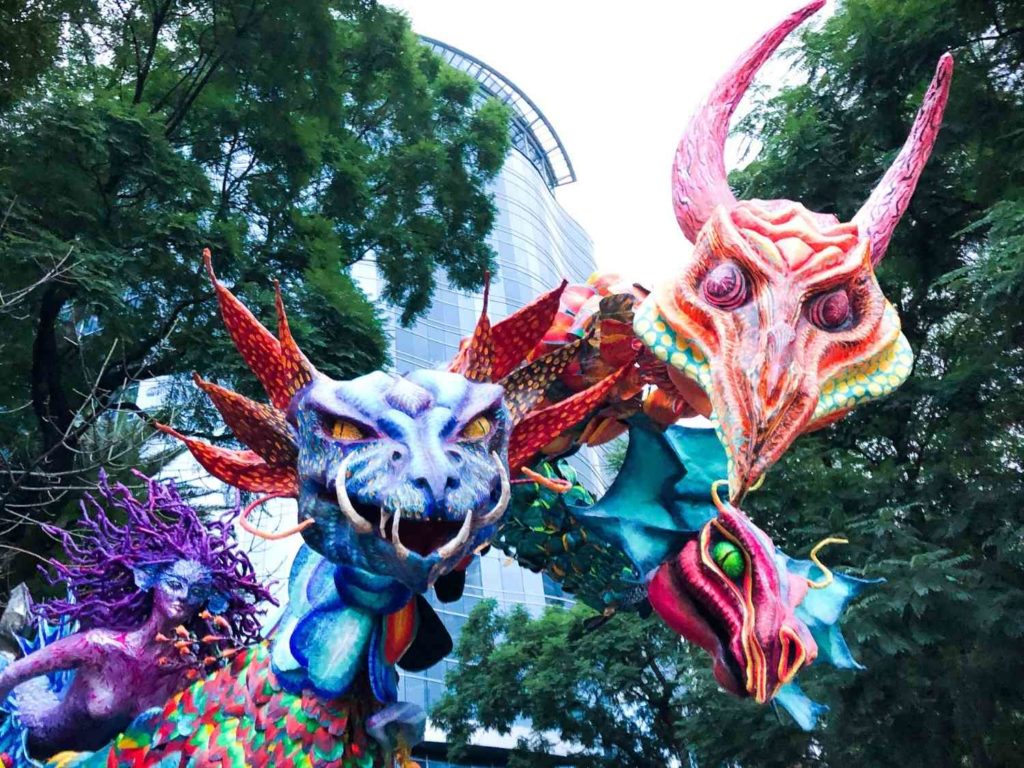
Duolingo and Lyrics Training are free, though they may require an email address to sign up. But you can pay for the premium account to access more tools. Busuu is a paid subscription, and offers opportunities to test out of a certain language level.
Another helpful app is Lingopie , which offers Spanish language tv shows and movies to help you learn Spanish through immersion. The app requires a paid subscription, but is packed with useful tools. Vocabulary words and transcripts accompany the video, and there are basic level videos geared towards kids too!

Read books to get familiar with basic Spanish phrases for travel
Reading is also a great way to learn a language. Pick up a Spanish language newspaper or a magazine, and read an article out loud. Translate words you don’t know. And then try to figure out the meaning of the article.

The Mexican government distributes their Mexican school textbooks for kids online. You can download a textbook and practice your Spanish that way.
Or better yet, buy a Mexican Spanish phrase book and read the phrases out loud. Reading aloud also helps you practice your pronunciation. Take a look at these Spanish phrase books and flash cards for helpful phrases for ordering food in Mexico.
Over 700 Phrases for Everyday Use by Dr. Pablo Garcia Loaeza
The 2000 Most Common Spanish Phrases by Fluency Faster
Lonely Planet Spanish Phrasebook by Cecilia and Rafael Carmona
Spanish Words and Phrases You Need to Know by Theodore Kendris Ph.D.
Practice your basic Spanish phrases for travel on this 10 day Mexico itinerary .
The most useful basic Spanish phrases for travel
If you’re new to the Spanish language, don’t expect to be perfect at the language right away. Language learning takes time. However, you can start with the following essential phrases to help you get by on your travels in Mexico.
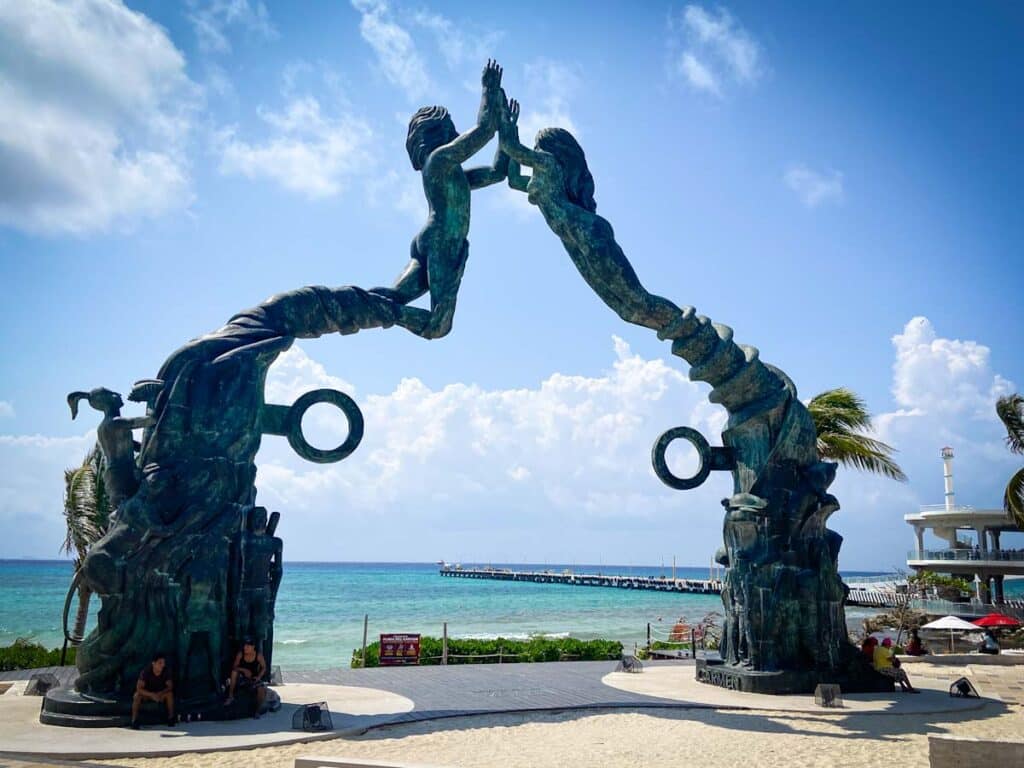
Whether you're traveling to the city of Guadalajara in Jalisco, the town of San Miguel de Allende in Central Mexico, or the island of Cozumel in the Yucatán peninsula, having a basic understanding of Spanish will be extremely useful.
Basic Spanish phrases for travel: greetings
The following Spanish travel phrases are helpful for starting conversations with people.
1. Hola (hello) and hasta luego (see you later)
“Hello” and “see you later” are useful basic Spanish phrases for travel. You’ll use them every time you meet someone new. Hola is the standard greeting for “hello.”
Hasta luego is the more common way to say good-bye. But if you’re not planning to see the person again, you can simply say adios as you leave.
2. Buenos días, buenas tardes, buenas noches (Good morning, good afternoon, evening)
When you learn Spanish, one of the first things you learn is how to say “good morning,” “good afternoon,” or “good evening.” Mexicans will usually say “good afternoon” starting at noon and all the way until sunset.
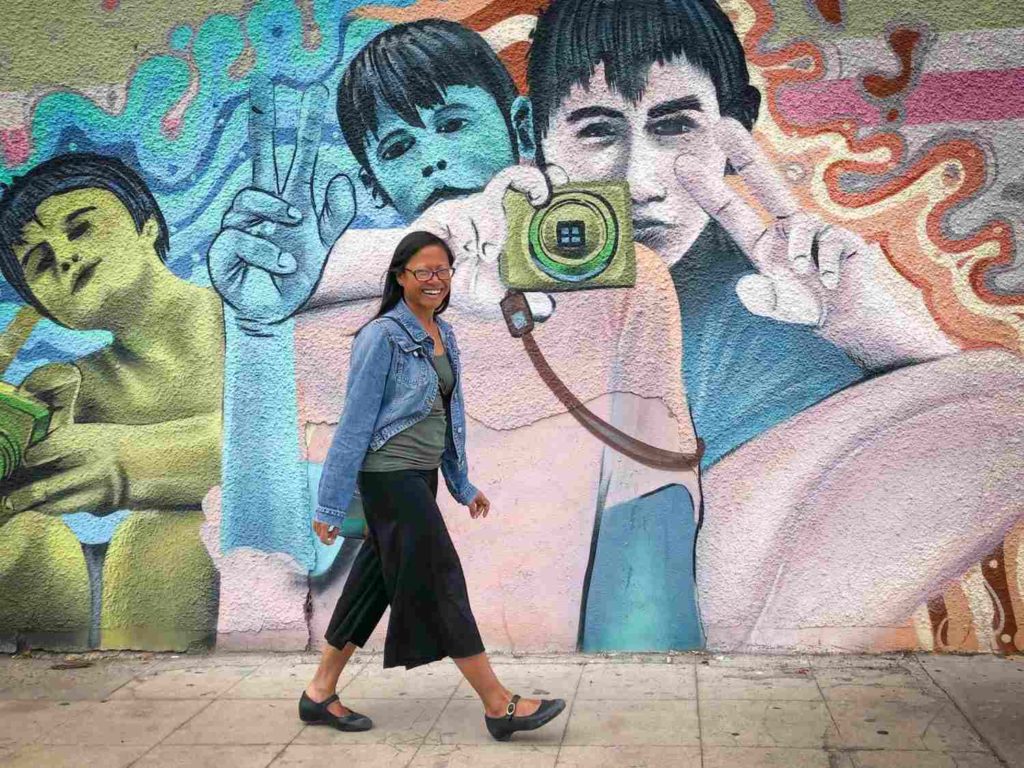
As a way to say good-bye, you can also add buen día (good day) during the day time or buena noche (good night) during the night time
Basic Spanish phrases for travel: words referring to people
The following words and phrases will be helpful to use when you’re referring to people in conversations.
3. Adultos/adultas (Adults) and niños/niñas (children)
At museums or attractions, you’ll often see different prices for adults and children. Knowing the words for “adults” and “children” will come in handy when buying tickets.
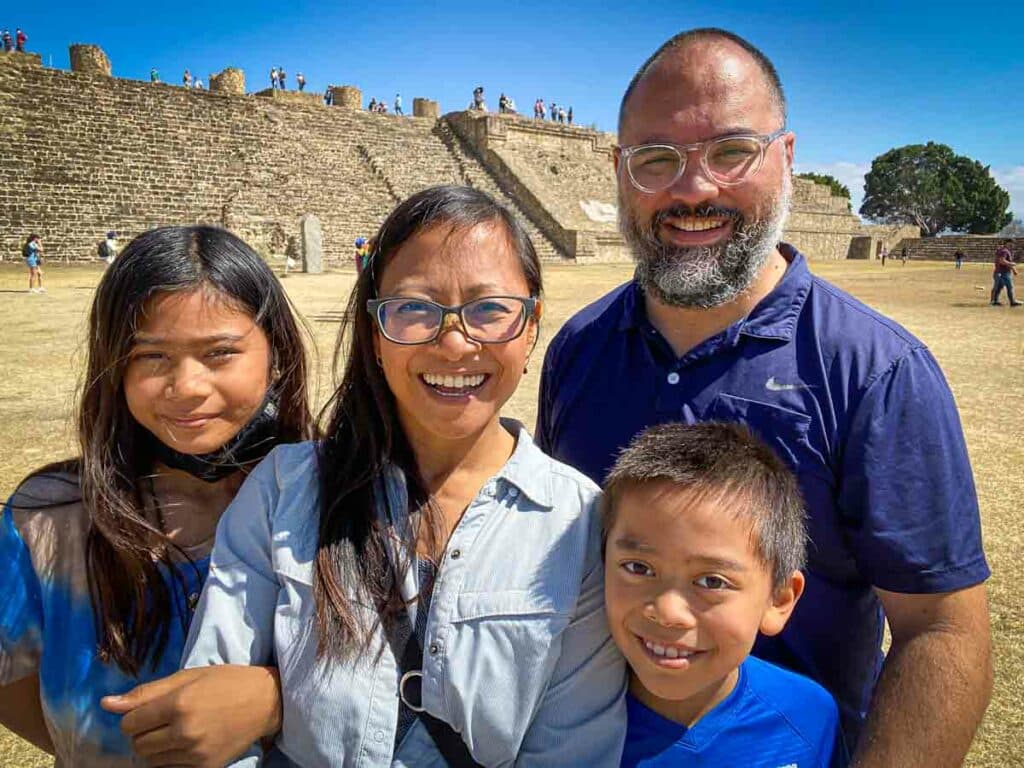
Note, in Spanish grammar, the gender of a person does make a difference in the word that is used. Men are adultos and women are adultas . But a mix of men and women are adultos .
The same goes for kids. if your children are all boys, then use niño or niños . If you have a mix of boys and girls, you also use niños . But if you only have girls, use niña or niñas .
4. Señor (Mr.), señora (Mrs.), and señorita (Miss)
When learning basic Spanish phrases for travel, knowing how to address people is helpful. Men are always addressed as señor. But there are differences in how women are addressed.
Married women are addressed as señora . Unmarried women are addressed as señorita. If you’re an unmarried older woman, or just an older woman traveling without a man, you will usually be addressed as señora.
5. Yo (I), tu (you), el/ella (he/she) ellos/ellas (they), nosotros/nosotras (we)
Pronouns influence the spelling of verbs, particularly the ending of the verb (this is known as conjugation). Most regular verbs will end with either - ar , - er , or - ir .

For simple present tense, when using the yo (I) pronoun, the ending will change to - o . For the tu (you) pronoun, change the ending to - as for - ar verbs, and - es for - er and - ir verbs. El (he) and ella (she) pronouns will change an - ar verb to - a , and will change - er and - ir verbs to - e .
For plural pronouns, such as ellos or ellas (both meaning they), the ending for - ar verbs will change to - an and the ending for - er and - ir verbs will change to - en . When using nosotros / nosotras , change the ending to -amos for -ar verbs, -emos for -er verbs, and -imos for -ir verbs.
If you want to deep dive into verbs and Spanish grammar, buy these useful books.
Baron’s 501 Spanish Verbs
Practice Makes Perfect Spanish workbooks .
Get a FREE Mexico packing list!
Sign up for the Mexico Travel Tuesday newsletter and instantly get a FREE packing checklist for your Mexico vacation.
Basic Spanish phrases for travel: being polite
It’s always good to be polite, wherever you are. These words will be useful in helping you have polite and respectful conversations.
6. Por favor (please)
Por favor is undoubtedly one of the most important basic Spanish phrases for travel that you should know. Say this when getting seated at a restaurant, ordering food, asking for things, or making reservations at a hotel.

7. Gracias (thank you) and no, gracias (no thank you)
Two other basic Spanish phrases for travel to know are “thank you” and “no thank you.” When you say, “thank you” to someone, they will usually reply with de nada , which means “you’re welcome.” Sometimes they may respond with a usted , which roughly translates to "same to you."
Being able to say “no thank you” comes in handy when you’re trying to fend off pushy taxi drivers at the airport, or vendors on the beaches.
8. Lo siento (I’m sorry) and disculpe (excuse me)
One of the most helpful basic Spanish phrases for travel to know is how to say “I’m sorry” or “excuse me”. You can say lo siento when you bump into people, knock things over, or just a general way of saying “I’m sorry.”
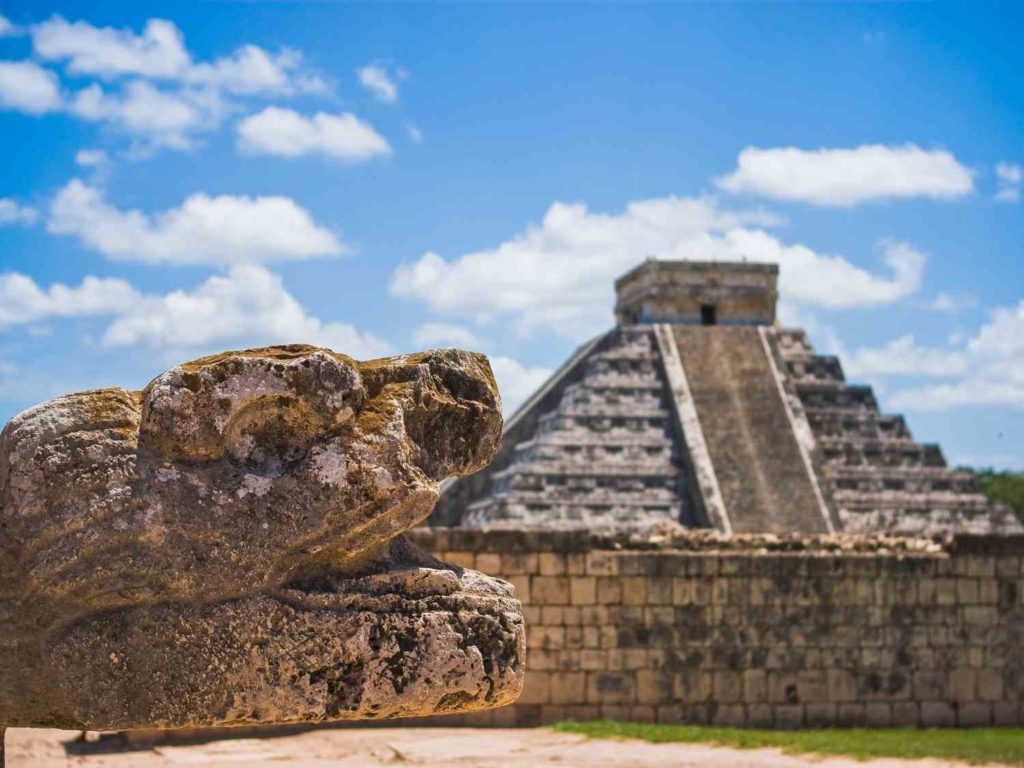
Disculpe can be used when you’re trying to get someone’s attention. However, if you’re squeezing by someone in a crowded room or street, you can also use con permiso .
Basic Spanish phrases for travel: common Spanish phrases
The following are a few other simple and helpful common Spanish phrases for travel to Mexico.
9. Si (Yes) and no (no)
The Spanish word for “yes” is si . And like English, the Spanish word for “no” is no .
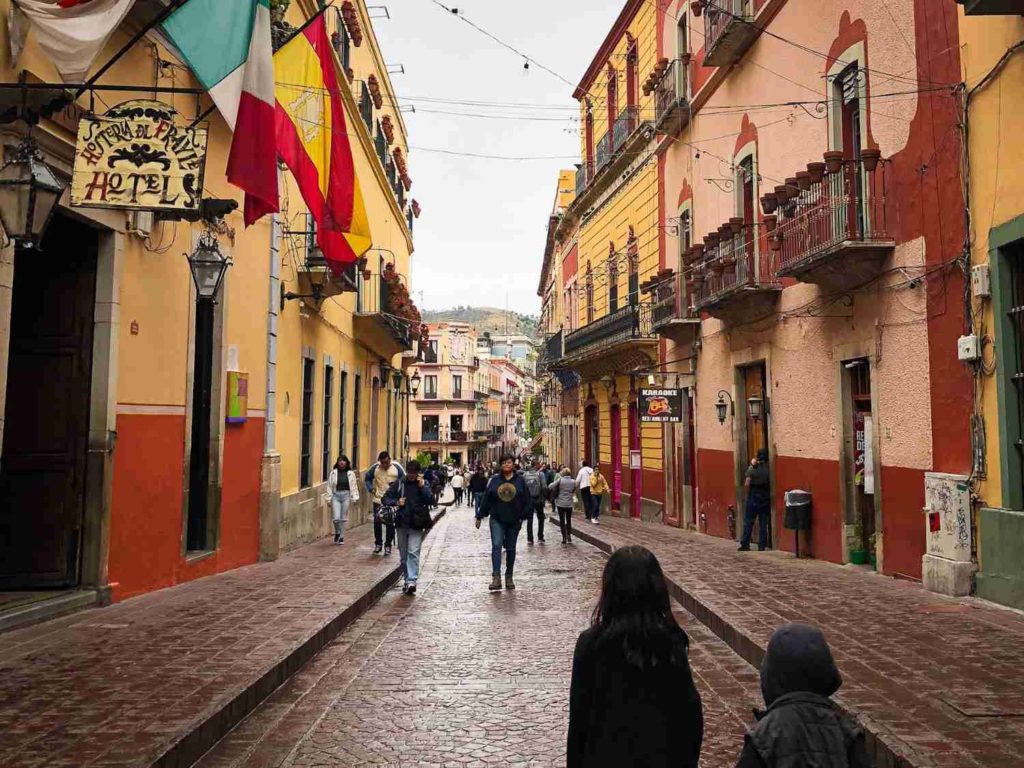
Additionally, if you’re negating a sentence, you can usually use no by putting it in front of a verb. Examples of this would be no entiendo (I don’t understand), no se (I don’t know), and no hablo espanol (I don’t speak Spanish).
10. Y (and) and o (or)
Knowing how to say "and" or "or" is extremely helpful as you're learning basic Spanish phrases for travel. You can use y when ordering multiple things at a restaurant: queremos ocho tacos y cuatro aguas de jamaica, por favor (we want eight tacos and four jamaica drinks, please).
An example of when to use o is when you're asking if a store or restaurant is open or closed: ¿ Está abierto o cerrado ?
11. No entiendo (I don’t understand) and ¿ habla Inglés ? (can you speak English?)
Another useful Spanish phrase to know, especially when you’re still starting to learn Spanish, is “I don’t understand.”
You can follow this up by asking, “can you speak English?” If the person you’re talking to doesn’t know how to speak English, they will most likely try to find someone who does.
12. Aquí/acá (here) and allí / allá (there)
“Here” and “there” are two basic Spanish phrases for travel that will come in handy at restaurants (when you want to pick a table to sit) or when giving directions to a taxi driver.
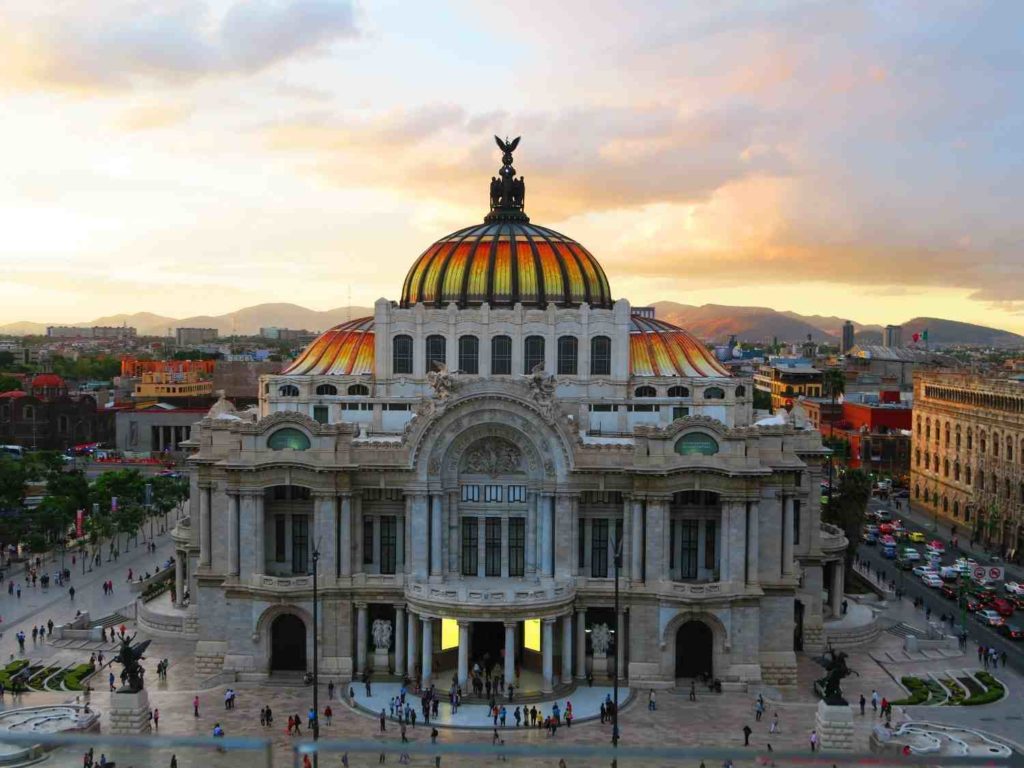
A quick note about aquí versus acá . While both words mean “here,” aquí refers to the immediate “here,” while acá refers to the vicinity of “here.” It’s similar for allí and allá . Allí refers to a place far from the speaker but still has a specific location, while allá refers to a far place with no specific location.
13. Cómo está ? (How are you?) Estoy bien (I’m fine)
Some more useful basic Spanish phrases for travel are “how are you” and “I’m fine.” These Spanish phrases for small talk are great to know, as you’ll most likely say this to taxi drivers, store owners, waiters, and basically anyone that you interact with.
14. Uno, dos, tres, cuatro, cinco, seis, siete, ocho, nueve, diez (1, 2, 3, 4, 5, 6, 7, 8, 9, 10)
Understanding simple numbers will come in handy when ordering food, purchasing tickets, or even telling time. If you want to learn more numbers, these Spanish numbers flashcards are really helpful in teaching you the numbers from 1-100.
Basic Spanish phrases for travel: asking questions
Another aspect of being able to communicate basic Spanish phrases for travel is knowing how to ask questions. The following Spanish travel phrases are useful questions to have in your language bank.
15. ¿ Puedo … ? (Can I …?) and ¿ puede … ? (can you…?)
Questions are sometimes expressed by intonation. A phrase like puedo can mean “I can”. But if you raise the inflection of the ending, the meaning changes to “can I?” The same goes for when you are saying “can you?”
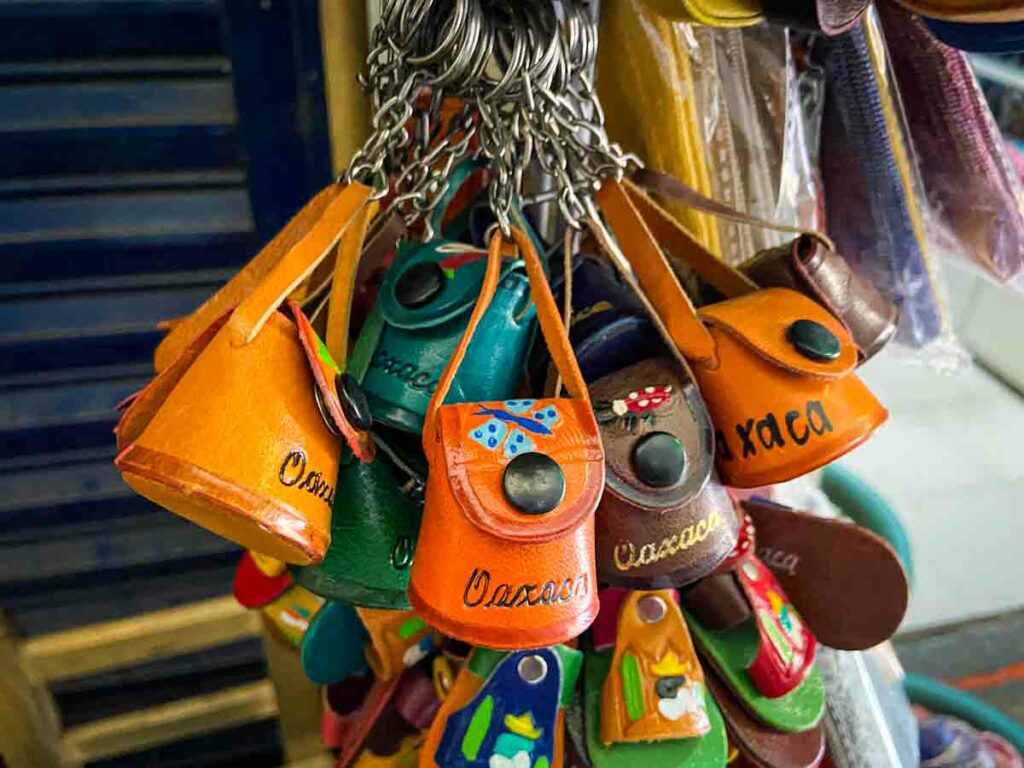
Some helpful verbs to know to ask questions include the following:
- p edir (order)
- pagar (pay)
- traer (bring)
- sentarme (sit)
- tomar un foto (take a photo)
16. ¿Qué es esto (What is this?) and ¿ qué es eso? (what is that?)
You can ask “what is this” or “what is that” to ask what something is when you’re at a restaurant, at the market, or even when you’re shopping at a store.
Here’s a note about masculine and feminine words. In Spanish, nouns are assigned a masculine or feminine gender.
Pronouns like this or that have their own masculine and feminine forms too: esto (masculine) versus esta (feminine), and eso (masculine) versus esa (feminine). Personally, if I don’t know the gender of a noun, I default to masculine.
17. ¿ Cuánto cuesta ? (how much does this cost?)
Additionally, you can ask “how much does this cost” when you want to know the price of something. Mexico uses the peso as currency. While the current exchange rate will fluctuate, you can generally calculate 20 pesos for $1 USD.
18. ¿ Dónde está ? (Where is …?)
If you’re asking for directions, start with dónde está , and then add the location that you’re wanting to go. For example, if you’re asking “where is the airport?” you would ask, ¿ dónde está el aeropuerto ?
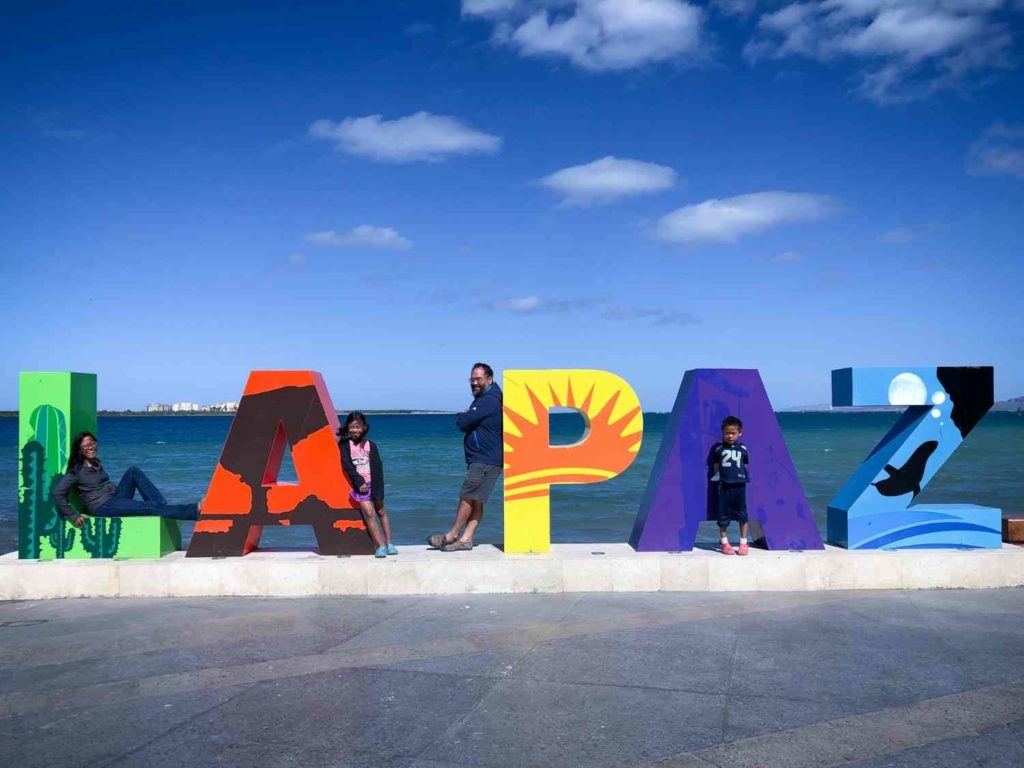
Alternatively, if you’re asking where an object is, such as a book, a pencil, or a phone, you can also use dónde está followed by the object.
Basic Spanish phrases for travel: phrases for the restaurant
As travelers, you'll likely spend a lot of your time at restaurants eating meals. Understanding a few Mexican food phrases will be very helpful in this case. These following basic Spanish phrases for travel will be especially useful for when you are at a restaurant.
19. Quiero … (I want …) and no quiero … (I don’t want …)
If you’re still beginning to learn basic Spanish phrases for travel, knowing how to say “I want XYZ thing” or “I don’t want XYZ thing” is extremely helpful. You can use “I want” when you’re ordering food, or when you’re looking for something at the store.
20. ¿ Tiene …? (Do you have …?)
Alternatively, you can also ask “do you have XYZ thing?” at restaurants and at stores. If the person answers in the affirmative, then you can follow up with “I want …”
21. Para aquí (for here) and para llevar (to go)
At restaurants, waiters may ask whether you want the food “for here” or “to go”. It’s not unusual for Mexicans to order food to go.
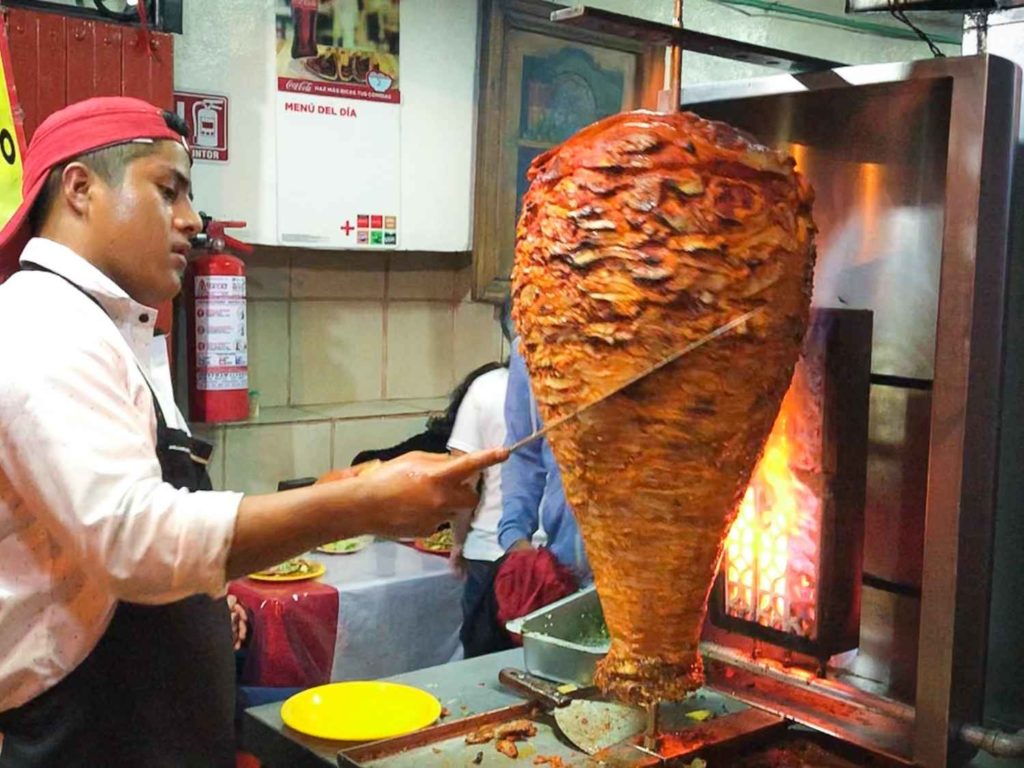
If you or your kids are sharing a plate, you would say para compartir (to share).
22. Riquisimo (it’s very tasty) and delicioso (it’s delicious)
After you’ve eaten a good meal, you can say either “it’s tasty” or “it’s delicious”. Your server will be more than delighted to hear you say either of those two phrases.
The best ways to learn basic Spanish phrases for travel
Some of the best ways to learn Spanish for travel is to just jump right in. Don’t be afraid of making mistakes or sounding like a two year old. It’s all part of the process of learning Spanish.
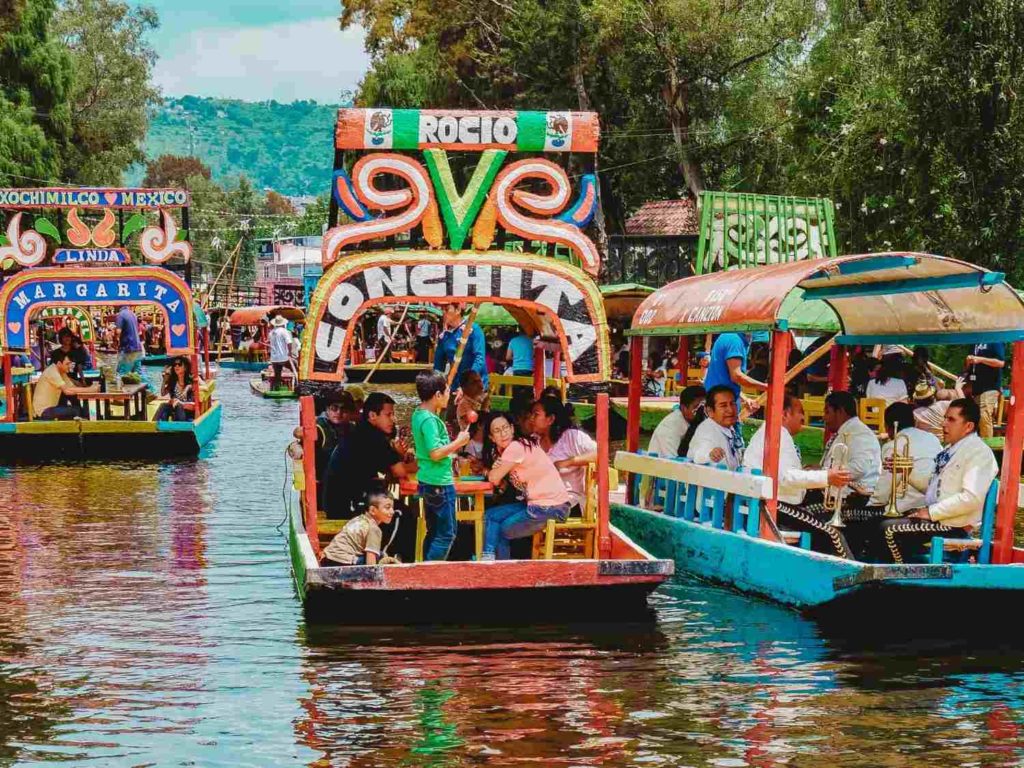
This approach is the best way to learn about Mexican culture as well. And it will help open doors to visiting other Spanish speaking countries as well. For your kids, you can have them read some bilingual kids books about Mexico to get used to the language.
Spending time listening and practicing Spanish
Overall, the best way to learn Spanish phrases for traveling is to practice, practice, practice before your trip! There is data that suggests that it takes 575-600 classroom hours to master conversational Spanish. And while you certainly don’t have to aim for full fluency, mastering just these basic Spanish phrases for travel can help you go a long way with communicating with people in Mexico.
Another way to develop your Spanish vocabulary and language skills before traveling to Mexico is to listen to music from Mexico, Spain, or other Latin America countries. Reading the lyrics (and their translation) in conjunction with listening to the songs will help you get familiar with current Spanish slang and basic Spanish phrases for travel.
Spanish language learning classes
If you’re planning on traveling to Mexico for an extended length of time, another way to learn basic Spanish phrases for travel is to take Spanish language classes. This is a great way to build your foundational Spanish grammar skills as well, especially if you are just a beginner.
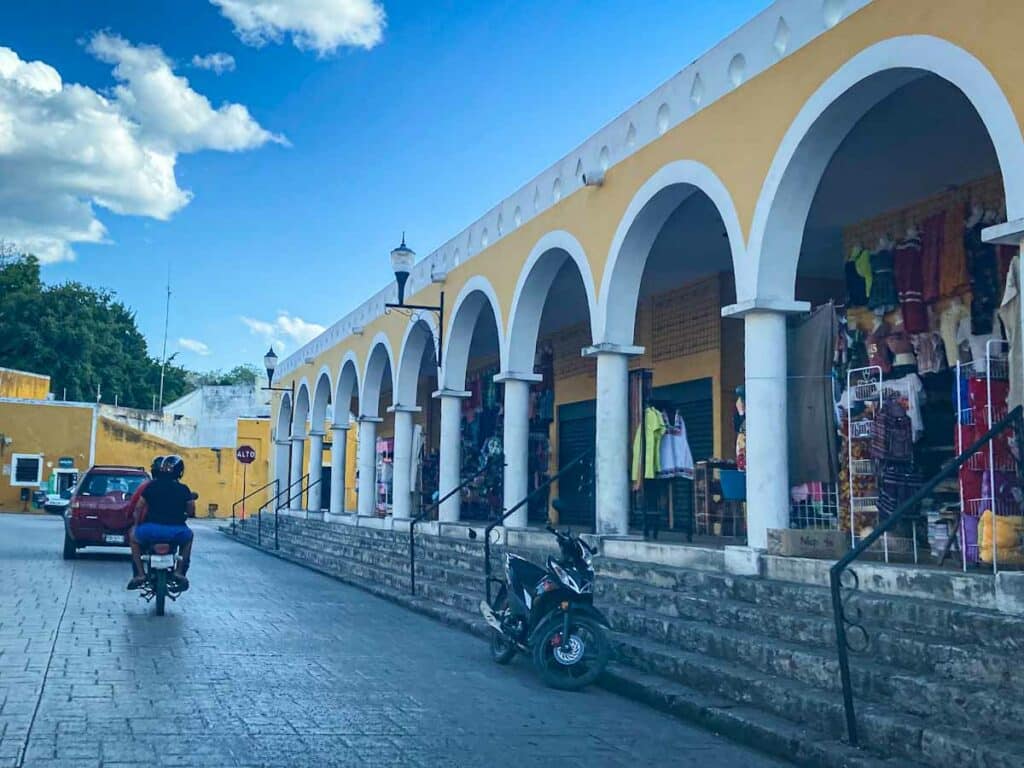
Examples of Spanish language schools include El Nopal in La Paz, La Calle Spanish School in Mérida, Oasis Spanish and Surf School in Puerto Escondido, and Agora Language Center in Playa del Carmen. You may need to check each school’s policy on private classes or short term courses.
Helping your kids get comfortable with the Spanish language
The best way to help your kids get comfortable with the Spanish language is to start introducing them to Spanish words before your trip. Reading bilingual children’s books is a great way to have your kids start hearing Spanish words.
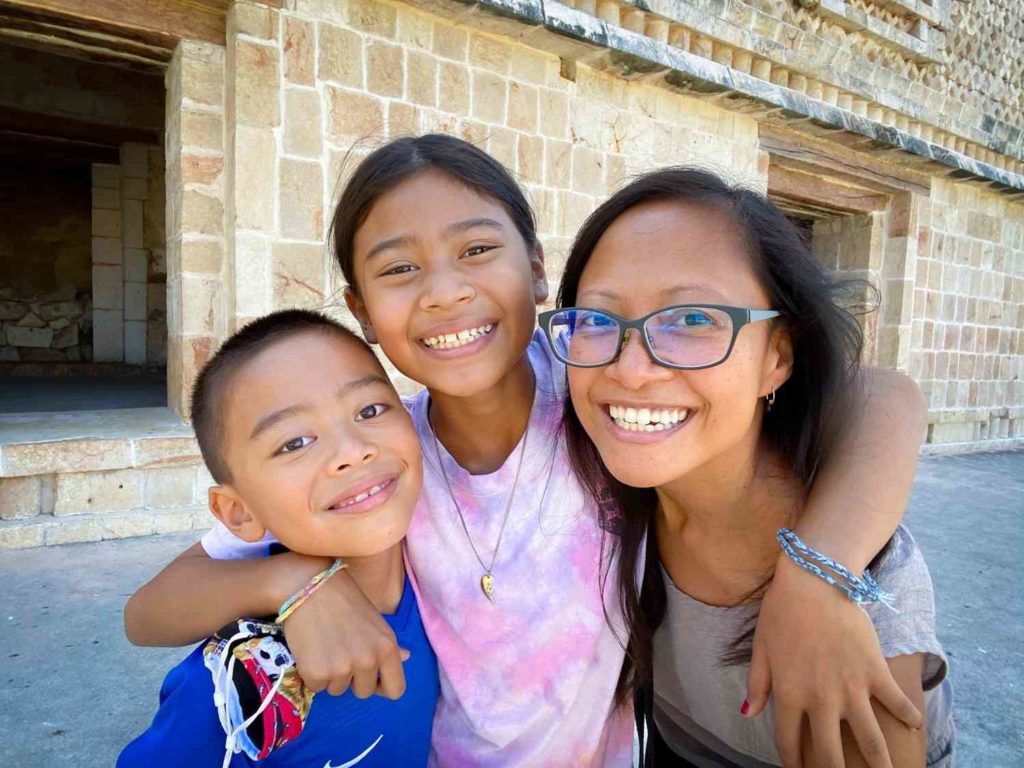
Classic stories like The Gingerbread Man and Jack and the Beanstalk have all been translated to bilingual books. These bilingual books can help your kids get used to the sound of Spanish before they travel to a Spanish speaking country.
Having patience while learning basic Spanish phrases for travel
Language acquisition is a long process. There’s no one perfect method to learn these basic Spanish phrases for travel. In actuality, it’s mostly trial and error.
Seeking out cultural activities to participate in, such as Dia de Muertos , can sometimes help. At the very least, it can help you understand the culture of Mexico a little better.
Even if you only know a few words in Spanish, try and use them to have a conversation with someone. Have patience, and don’t give up. Who knows. With practice you might become an expert at traveling and conversing with locals in Spanish-speaking countries!
Do you have any tips on learning basic Spanish phrases for traveling Mexico? Drop a comment on our Facebook page with your favorite Spanish phrase.
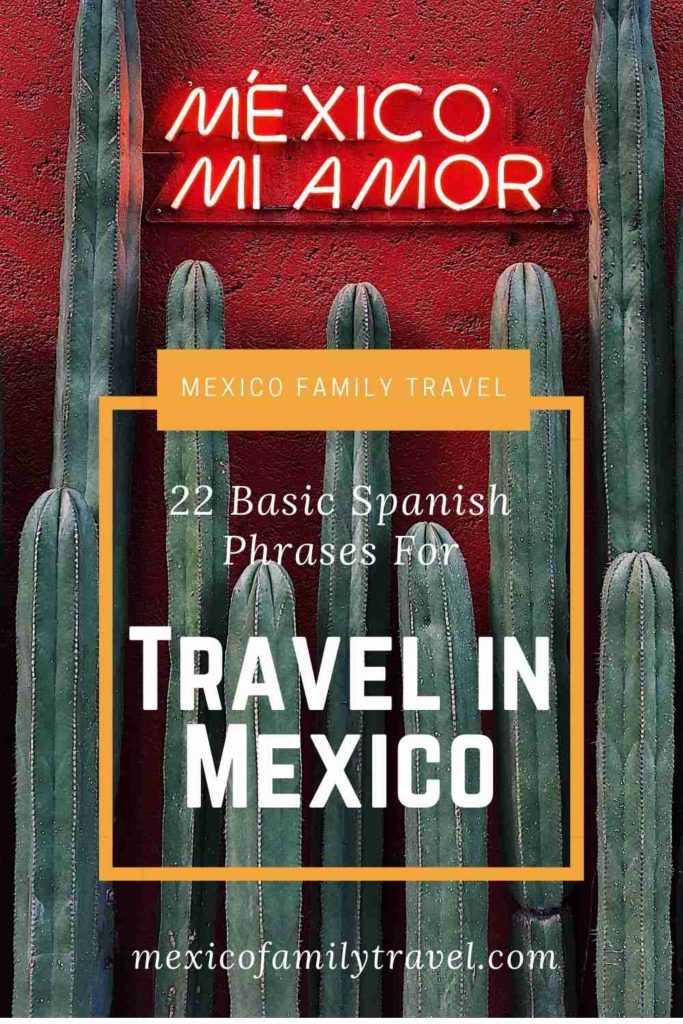
Ready to start planning your Mexico family trip? Take a look at these tips for putting together a Mexico travel budget .
Sharing is caring!
Related Mexico Posts

Sign up to get Mexico travel tips in your inbox!
Which Language Do You Want to Learn?
- Inside Babbel
- Babbel Bytes
ARTICLES ABOUT
Mexican vacation cheat sheet: 20 spanish phrases to know.

Americans love traveling to Mexico for its stunning beaches, cultural cities, delicious food and, of course, its proximity to the United States. Approximately 22 million Americans visited Mexico in 2021 — still nowhere near pre-pandemic levels, but those numbers are trending back up again. Do you have a Mexican vacation coming up, maybe to Mexico City or somewhere beachy? You’ll want to brush up on your Spanish before you go, and Babbel has a course designed especially for you.
The Spanish editors on Babbel’s team of language experts created a Mexican vacation course in our app, which covers all the topics you’ll need to know for your trip and even throws in some Mexican slang you might hear when you’re there. The lessons focus specifically on Mexican Spanish, rather than Castilian Spanish, which is the standard form spoken in Spain.
Here’s a sneak preview of the words and phrases you’ll need most. Start with these, and then download the Babbel app to access the other gems in the Mexican vacation course. You can also access it directly through your browser with your Babbel account.
Mexican Vacation Must-Know Expressions

Meeting New People
One of the best parts of visiting other countries is making new friends with cultures and worldviews that are different from yours. Knowing how to introduce yourself in Spanish will make meeting people in Mexico way easier. Here are some phrases to learn:
Me llamo ______ [Leonardo]. — My name is ______ [Leonardo].
¡Mucho gusto! — Nice to meet you!
¿Cómo estás? — How are you?
Estoy bien, gracias. — I’m fine, thank you.
Going Out For Drinks
Sampling the local cuisine is another highlight of any trip abroad. But you don’t want to get caught in a tourist trap. Speaking the language will help you find authentic restaurant and bar experiences that will be much more memorable. Start by learning some key Spanish phrases, like how to order and ask for the check.
Voy a pedir una chela. — I’m going to order a beer.
¿Se puede tomar agua de la llave? — Is it ok to drink the tap water?
¿Puedo pagar con tarjeta? — Can I pay with (a credit) card?
La cuenta, por favor. — Check, please.
Asking For Directions
Attempting to navigate a new city can be overwhelming, especially when you don’t have cell phone data and can’t just rely on Google Maps like you usually do. Picking up some navigation phrases can help prevent nerve-racking situations.
Estoy perdido/a. — I am lost.
¿Cómo llego a ______ [Hotel Milenio]? — How do I get to ______ [Hotel Milenio]?
Gira a la izquierda/derecha. — Turn left/right.
Vamos en camión. — Let’s take the bus.

Getting Medical Attention
No one wants to get sick or have a medical emergency when they’re on vacation (or ever, for that matter), but things happen, and it’s best to be prepared for them. Learn how to ask for help and to discuss your condition before you travel.
Busco una farmacia. — I’m looking for a pharmacy.
Estoy enfermo/a. — I am sick.
Me duele la cabeza. — My head hurts.
¿Me puede ayudar? — Can you help me?
Understanding Mexican Slang
Slang is an important part of local language and culture. It can also throw you for a loop if you only learned the standard form of the language. Want to make the Mexican youth think you’re hip? Here’s some common slang you might hear on your trip to Mexico.
¿Qué onda? — What’s up?
¡Está muy chido! — This is very cool!
¡Órale, qué bien! — Wow, that’s good!
¡No manches! — No way!
- Search Please fill out this field.
- Newsletters
- Destinations
- More to Explore
Spanish Phrases to Learn Before You Go to Mexico
If you don't speak any Spanish at all, it's a good idea to at least learn a few phrases before you travel to Mexico. Many tourism industry workers in Mexico speak English, especially in popular vacation destinations , however, if you venture off the main tourist trail, it's really helpful to speak some Spanish. If you don't speak any at all, buy a good phrase book (or an app for your phone) and refer to it often! You'll probably find plenty of people along the way who are willing to make the effort to understand what you need. However, no matter your destination or if the people around you speak English, making an effort to speak at least some Spanish will go a long way towards creating a rapport between you and the Mexicans you meet.
"Hello." Mexicans tend to be quite formal when it comes to greetings. You may come across as rude if you neglect to greet people properly in Mexico. Greet your taxi driver before saying where you want to go. Greet the attendant at the information counter before you launch into your questions. A simple "hola" is fine among friends, but in other situations, you should change the form you use depending on the time of day.
- Before noon: Buenos días (Good morning, Good day)
- From noon until dark: Buenas tardes (Good afternoon)
- At night: Buenas noches (Good evening, Good night)
"Thank you." It's always polite to thank people who are providing you with a service - and even better to say it in their language. The correct response is "D e nada ." You should also learn to say please: por favor . To be extra polite, you can say: "Gracias, muy amable." Which means "Thank you, you're very kind."
¿Cuanto cuesta?
How much is it? Of course, if you hope to understand the answer, you'll need to have some knowledge of the numbers in Spanish. In a restaurant, ask for la cuenta . If you're hoping for a discount, you can ask " ¿Cuanto es lo menos? " which is a way of asking what their best price is - this phrase will give you an idea of whether or not the seller is willing to negotiate.
Uno, dos, tres, cuatro....
Learning the numbers is one of the first things to master in a new language, and you'll find the rewards are many. You can haggle over prices, ask the time and find out how long it will take to get to your destination.
¿Donde está...?
Where is...? Perhaps the most essential one is ¿Donde está el baño? (Where is the restroom?). But knowing how to ask where things are can be useful in many circumstances. Hopefully, the person answering you will point and use hand gestures so it won't matter if you don't understand the words of their reply!
Me llamo...
My name is...
The best way to learn Spanish is to talk with people, and the way to begin is by introducing yourself.
Note: The double L in Spanish is pronounced similar to a Y (in most of Mexico, though it may be pronounced differently in other countries) so this sounds kind of like "Me yamo."
Excuse me. There are different forms to say this depending on the situation, but this is the one which works in most situations - if you're trying to get by someone and you want them to move out of your way, if you've made a faux-pas or if you're trying to get someone's attention.
¿Puedo tomar una foto?
May I take a photo? Some people don't like to have their picture taken, so to avoid conflicts, it's always better and more polite to ask first.
I'm sorry. Hopefully, you won't have too much to apologize for, but this phrase can come in handy if you've accidentally stepped on someone, said the wrong thing. If you find out that someone has suffered a personal loss or is going through a difficult time, this phrase will also show that you have sympathy for their situation.
No hablo español. ¿Habla usted inglés?
I don't speak Spanish. Do you speak English? Mexicans who speak some English are generally happy to find someone they can practice with. While it's more polite to make an effort to speak in the language of the country you're visiting, folks who work in the tourism industry usually speak some English and will go out of their way to be helpful.
Related Articles
More related articles.
LUXURY under BUDGET
35 Basic & Common Spanish Phrases for Traveling in Mexico
Are you planning a trip to Mexico soon? Whether you’re heading to the beaches of Cancún, the ruins of Chichén Itzá, or the colorful streets of Mexico City, learning some basic and common Spanish phrases can go a long way in making your trip more enjoyable and memorable.
In this blog post, I’ve compiled the most essential Spanish phrases for traveling in Mexico. From greetings and basic phrases to ordering food and drinks, getting around, negotiating while shopping, dealing with medical emergencies, and making small talk with locals, these phrases will help you communicate with confidence and connect with the culture.
Luxury under Budget aims at helping you get the best deals by maximizing the value of your time and money. My recommendations are based on first-hand experiences and a full analysis of costs vs. benefits. This post may contain affiliate links, which means that I may get a small commission when you make a purchase, at no extra cost to you. This helps support my blog and enables me to provide more free and helpful content . Now, let’s go get you that luxury travel while staying under the budget!
Have You Got These Items For Your Trip Yet?
- Credit Card : I recommend Chase Sapphire Preferred®
- Flights & Accommodations : I recommend Expedia
- Car Rental: I recommend Discover Cars
- Travel Accessories: I recommend Amazon Coupons
- Tours/Experiences: I recommend Viator
Greetings & Basic Spanish Phrases
Let’s start with the basics. Here are some essential Spanish phrases for greeting people and making polite conversation:
- Hola (oh-lah) – Hello
- Buenos días (bway-nos dee-as) – Good morning
- Buenas tardes (bway-nas tar-days) – Good afternoon/evening
- Buenas noches (bway-nas no-chays) – Good night
- Por favor (por fah-vor) – Please
- Gracias (grah-see-as) – Thank you
- De nada (day nah-dah) – You’re welcome
- Adiós (ah-dee-ohs) – Goodbye
Common Spanish Phrases for Ordering Food
One of the best parts of traveling to Mexico is trying the delicious local cuisine. Here are some useful Spanish phrases for ordering food and drinks in restaurants and cafes:
- Quiero un café, por favor (kee-air-oh oon kah-fay por fah-vor) – I’d like a coffee, please
- La cuenta, por favor (lah kwen-tah por fah-vor) – The bill, please
- ¿Qué recomiendas? (kay ray-koh-mee-en-das) – What do you recommend?
- Está rico (es-tah ree-koh) – It’s delicious
- Está muy picante (es-tah moo-ee pee-kahn-tay) – It’s so spicy
Common Spanish Phrases for Getting Around
Navigating a new place can be challenging, but these Spanish phrases will help you get around in Mexico with ease:
- ¿Dónde está el baño? (don-day es-tah el bahn-yo) – Where is the bathroom?
- ¿Cuánto cuesta un taxi? (kwan-to kways-tah oon tah-xee) – How much does a taxi cost?
- ¿A qué hora sale el próximo autobús? (ah kay oh-rah sah-lay el proks-ee-moh au-to-boos) – What time does the next bus leave?
- La estación de tren está lejos? (lah es-tah-see-ohn day trayn es-tah lay-hos) – Is the train station far?
Mexico Travel Hacks
👉 Hotels: Save 50-60% off on your next hotel stay with Priceline Express Deals ! They offer great discounts by hiding the hotel’s name till you pay, but don’t worry, you can avoid the uncertainty by using my Priceline Express Deals Guide to reveal the hidden hotel before booking!
👉 Travel Insurance : No one wants to think about what could go wrong on a vacation, but accidents can happen anywhere, at any time. It’s honestly not worth taking the risks when you can be covered for cheap, and I recommend Safety Wing for budget-conscious travelers.
👉 Rental Car: Protect yourself from car rental scams in Mexico ! Most car rental agencies won’t accept Collision Damage Waiver Insurance (which usually comes with U.S travel credit cards). They will upsell insurance if you arrive at pick-up without one. Avoid losing time and money by getting the best car rental rates and full coverage insurance for just $7/day with Discover Cars .
👉 Sunscreen: Sunscreen in Mexico can cost you 2-4 times more than in the States. Plus, some tour operators and guards won’t let you enter protected water with non reef-safe sunscreen. To save you money, protect your skin, and ensure a seamless water-filled adventure, I highly recommend packing SPF 50 reef-friendly sunscreen .
Spanish Phrases for Negotiating Prices
Mexico is a shopper’s paradise, with vibrant markets, street vendors, and artisan shops selling everything from souvenirs to high-end fashion. But haggling and negotiating is often expected, so it’s important to know some basic Spanish phrases to get the best deals and avoid overpaying.
- ¿Cuánto cuesta? (kwahn-toh kweh-stah) – How much does it cost?
- Es muy caro (ess moo-ee kah-roh) – It’s so expensive
- ¿Me puedes dar un descuento? (may poo-eh-days dar oon dess-kwento) – Can you give me a discount?
- Es mi último precio (ess mee loo-eh-stoh preh-see-oh) – It’s my last price
- Gracias, pero es demasiado (grah-see-ahs, peh-roh ess deh-mah-see-ah-doh) – Thank you, but it’s too much
It’s also important to remember to be polite and respectful, even when negotiating. Start by greeting the vendor with a friendly “Hola” (oh-lah) or “Buenos días” (bway-nohs dee-ahs), and remember to say “Por favor” (pohr fah-vohr) when asking for something and “Gracias” (grah-see-ahs) when receiving it.
And if you’re not comfortable negotiating, don’t worry! Some established shops have fixed prices, so you can simply ask “¿Cuánto cuesta?” (How much does it cost?) and decide if it’s within your budget.
By learning some basic Spanish phrases for negotiating and shopping, you’ll not only get better deals but also connect with locals and gain a deeper appreciation for Mexico’s rich culture and traditions.
Basic Spanish Phrases for Medical Emergencies
No one likes to think about getting sick or injured while traveling, but accidents and illnesses can happen anywhere. That’s why it’s important to know some basic Spanish phrases for medical emergencies, so you can communicate with doctors and healthcare professionals if the need arises.
- Necesito un médico (neh-seh-see-toh oon meh-dee-koh) – I need a doctor
- ¿Dónde está el hospital más cercano? (dohn-deh ess-tah ehl oh-spee-tahl mahs sehr-kah-noh) – Where is the nearest hospital?
- Tengo dolor de cabeza (tehn-goh doh-lor deh kah-beh-sah) – I have a headache
- Me duele el estómago (may doo-eh-leh ehl ess-toh-mah-goh) – My stomach hurts
- Tengo una alergia (tehn-goh oo-nah ah-lehr-hee-ah) – I have an allergy
It’s also important to know some basic medical vocabulary, such as “dolor” (pain), “sangre” (blood), “fiebre” (fever), and “medicamento” (medication). And if you have any pre-existing medical conditions, allergies, or medications, make sure to write them down or carry a card with you in case of an emergency.
Make sure that your phone can work in Mexico , and in case of an emergency, call the local emergency services number, which is 911 in Mexico. If you need medical attention but it’s not an emergency, you can go to a pharmacy (farmacia) or a clinic (clínica) for advice and treatment.
By learning some basic Spanish phrases for medical emergencies, you’ll be prepared for any unexpected health issues and be able to communicate with healthcare professionals if necessary. Stay safe and healthy on your travels!
Spanish Phrases for Making Small Talks
Finally, don’t be afraid to strike up a conversation with locals and practice your Spanish. Here are some Spanish phrases for making small talk:
- ¿Cómo te llamas? (koh-moh tay yah-mas) – What’s your name?
- ¿De dónde eres? (day don-day eh-rays) – Where are you from?
- ¿Qué te gusta hacer? (kay tay goo-stah ah-sayr) – What do you like to do.
- Me gusta la playa (may goo-stah lah play-yah) – I like the beach
- Me encanta la comida mexicana (may en-kahn-tah lah koh-mee-dah may-hee-kah-nah) – I love Mexican food
- ¿Hablas inglés? (ah-blahs een-glays) – Do you speak English?
- No hablo español muy bien (no ah-bloh es-pahn-yol moo-ee bee-en) – I don’t speak Spanish very well
Remember, learning some basic Spanish phrases will not only help you communicate with locals but also show that you respect and appreciate their language and culture. Don’t worry if you make mistakes or stumble over your words, the important thing is to try and have fun with it!
The Wrap-Up: Basic & Common Spanish Phrases for Travel to Mexico
If you’re planning a trip to Mexico, take some time to learn these essential Spanish phrases. You’ll be surprised how far a little effort can go in making your trip more enjoyable and authentic. ¡Buen viaje! (Have a good trip!)
As always, if you have any questions or would like to share your own tips for traveling in Mexico, feel free to leave a comment below. And don’t forget to subscribe to my blog for more travel tips and inspiration. ¡Hasta la próxima! (Until next time!)
Mexico Travel Resources
- Cancun vs Playa del Carmen vs Cozumel: Which Vacation Spot is Best for You?
- Mexico Power Outlet: Which Plug is Used in Mexico?
- The Ultimate Guide for Las Grutas Tolantongo – Hidalgo Mexico Hot Springs
- Is Cancun Safe? 21 Dumb Mistakes to Avoid in Cancun
- 37 Top Things to Do & Best Places to Visit in Cancun
- What to See & Do in Cozumel on A Day Trip!
- The Maldives of Mexico: Is Bacalar Lagoon worth visiting?
- The Ultimate Guide for A Magical Xcaret Wedding in Mexico!
- 10 Magical Cenotes/Underwater Caves in Mexico
- Isla Mujeres vs Cozumel: Which Island to Choose for Vacation?
No products in the cart.
23 Essential Mexican Spanish Phrases for Travel and Tourism

When planning a trip to Mexico, one of the most exciting aspects is immersing yourself in its vibrant culture. However, the language barrier can be a challenge. Knowing some Essential Spanish Phrases for Mexico will not only make your experience smoother but also allow you to connect better with locals and make the most of your trip. In this article, we share 23 key expressions that will be useful in various travel and tourism situations, helping you navigate everyday interactions and explore the rich cultural landscape of Mexico.
Table of Contents
How to Greet and Be Polite in Mexico
These Essential Spanish Phrases for Mexico are fundamental to making a good impression and setting a friendly tone in conversations.

1. ¡Qué onda! / Buenos días (What’s up! / Good morning) “¡Qué onda!” is a very common greeting in Mexico, especially among friends and young people. It’s used to say “Hello” informally and conveys a sense of familiarity. On the other hand, “Buenos días” is a more formal greeting used in the morning, and it’s a polite way to start any interaction, whether you’re speaking with hotel staff or meeting someone for the first time.
2. Porfa y gracias (Please and thank you) In Mexico, it’s common to hear the shortened version of “Por favor,” which is “Porfa.” This informal tone is typical among friends and in casual settings. “Gracias” is the standard way to say “thank you,” and it’s essential to use it often to show respect and gratitude, as Mexicans highly value politeness.
3. ¿Cómo estás? / ¿Qué onda? (How are you? / What’s up?) In addition to “¿Cómo estás?,” it’s also common to use “¿Qué onda?” as an informal way to ask how someone is doing or how things are going. This phrase is particularly useful in social situations, allowing you to engage in small talk and make connections with the locals.
Navigating Transportation in Mexico: What to Say
Getting around in Mexico can be simple if you know the right Essential Spanish Phrases for Mexico related to transportation

4. ¿Cuánto cuesta el pasaje? (How much is the fare?) In Mexico, it’s more common to refer to the price of public transportation as “pasaje” instead of “boleto.” This phrase is crucial when using buses, the metro, or colectivos (shared taxis). Knowing this will prevent any misunderstandings and help you avoid overpaying.
5. ¿Dónde me bajo? (Where do I get off?) Knowing where to get off is crucial in big cities like Mexico City, where routes can be confusing. This phrase will help you find your way and ensure you don’t get lost, especially in unfamiliar areas. You can also use this phrase when asking the driver or fellow passengers for assistance.
6. Voy al centro (I’m going to the city center) “El centro” refers to the central area of a city, which is often a common destination in Mexico. Whether you’re catching a taxi or asking for directions, this phrase will be understood by everyone and will guide you to the heart of any Mexican town or city.
What to Say When Dining Out in Mexico
With these Essential Spanish Phrases for Mexico, you’ll be able to order your favorite meals and navigate the dining experience without any hiccups. Mexican food is incredibly diverse, so these phrases will come in handy whether you’re eating at a street stall or a fancy restaurant.

7. Una mesa para dos, porfa (A table for two, please) The abbreviation of “Por favor” to “Porfa” is very common in casual Mexican speech. Using this phrase when you arrive at a restaurant will ensure you’re quickly seated, and it adds a friendly, informal touch to your request.
8. ¿Qué me sugiere? (What do you suggest?) If you’re unsure of what to order, this phrase is perfect for getting a recommendation from the waiter. It’s an excellent way to discover local dishes and try something new. Mexicans take pride in their cuisine, so you’re likely to get enthusiastic and helpful suggestions.
9. La cuenta, porfa (The check, please) “Porfa” is frequently used instead of “por favor” in informal situations. When you’re ready to leave, this phrase will help you smoothly conclude your dining experience. Additionally, it’s good to remember that tipping is customary in Mexico, usually around 10-15%.
Useful Phrases for Your Hotel Stay in Mexico
When staying at a hotel, knowing some specific Essential Spanish Phrases for Mexico will make the check-in, check-out process, and any additional requests easier during your stay.

10. Tengo una reservación (I have a reservation) This phrase will help you check in without complications. Just mention it along with your name, and the hotel staff will assist you with your booking. It’s also useful to confirm your reservation details in advance, ensuring everything is in order.
11. ¿A qué hora es la salida? (What time is check-out?) It’s important to know the check-out time to plan your day or final activities. This phrase is crucial for coordinating your departure and avoiding any last-minute rushes. In some cases, you might be able to request a late check-out by asking, “¿Puedo hacer check-out tarde?”
12. ¿Me da una toalla extra? (Can I have an extra towel?) If you need something extra in your room, like an additional towel, this phrase will be very useful. It’s a simple yet polite way to make your stay more comfortable, and hotel staff will appreciate your effort to speak their language.
What to Say in Case of Emergency in Mexico
These Essential Spanish Phrases for Mexico will help you ask for help when you need it most. Emergencies can be stressful, so knowing these phrases in advance can provide peace of mind.

Ready to learn more about Mexican language and culture?
13. ¡Auxilio! / ¡Ayuda! (Help!) These words are the most basic for asking for assistance in a dangerous situation. Use them loudly and clearly to attract attention. “¡Auxilio!” is slightly more formal, while “¡Ayuda!” is more commonly used in everyday situations.
14. Necesito un doctor (I need a doctor) If you or someone nearby feels unwell, this phrase will help you seek medical attention immediately. It’s also useful to know the location of the nearest hospital or clinic, just in case.
15. Llama a la patrulla (Call the police car) In Mexico, it’s common to hear “patrulla” instead of “policía” when talking about calling the police. Use this phrase if you need to report an incident or require police assistance. It’s a good idea to keep the local emergency numbers handy during your trip.
key Spanish Phrases for Shopping and Bargaining in Mexico
These Essential Spanish Phrases for Mexico will help you get good prices and enjoy shopping in local markets. Bargaining is expected in many places, so don’t be shy about using these phrases.

16. ¿Cuánto cuesta? (How much does it cost?) This is the first question you should ask when you see something you’re interested in buying. It’s the gateway to starting a bargaining session. Be sure to ask politely and show interest in the item, which can lead to a more favorable price.
17. ¿Me lo deja más barato? (Can you give it to me cheaper?) Bargaining is common in markets and small shops in Mexico. This phrase will help you negotiate a better price. Remember to be respectful during the process, as haggling is considered part of the shopping experience rather than an argument.
18. Solo estoy viendo, gracias (I’m just looking, thank you) If you’re not ready to buy, this phrase is useful to indicate that you’re just browsing with no immediate commitment. It’s a polite way to decline offers from persistent vendors without closing the door on future purchases.
Essential Spanish Phrases for Socializing in Mexico
Here are some Essential Spanish Phrases that will be useful for making friends and learning more about the culture.

19. ¿De dónde eres? (Where are you from?) This is a friendly question that shows interest in the other person, ideal for starting a conversation. Mexicans are generally warm and welcoming, so don’t hesitate to ask this when meeting new people.
20. Me llamo… (My name is…) Introducing yourself is the first step to establishing new friendships. Use this phrase to clearly and kindly state your name. It’s also polite to shake hands or, in more informal settings, offer a friendly hug or kiss on the cheek.
21. Mucho gusto (Nice to meet you) This expression is the most common way in Mexico to respond when someone introduces themselves to you. Saying “Mucho gusto” is a polite way to acknowledge the introduction and express that you’re pleased to meet the person.
Essential Spanish Phrases for Tourists in Mexico
Finally, here are some additional Essential Spanish Phrases for Mexico that will be useful while exploring the most iconic tourist sites in Mexico.

22. ¿Dónde está el Zócalo? (Where is the Zócalo?) The Zócalo is the main square in many Mexican cities, especially in Mexico City. Knowing how to ask for directions to these central locations can help you easily find the cultural and historical heart of the city.
23. ¿A qué hora abren? (What time do they open?) It’s the common way to ask about opening hours for museums, parks, or shops. This phrase is especially useful if you’re planning your itinerary and want to make the most of your day.

Mastering these Mexican Spanish phrases will not only make your trip to Mexico smoother, but also allow you to interact more deeply with the culture and locals. Whether you’re navigating the vibrant streets of Mexico City, bargaining at a local market, or simply enjoying a meal, these phrases will enhance your experience and open doors to new connections.
If you want to continue improving your Spanish and delve deeper into Mexican expressions, we recommend exploring additional resources like Short Stories in Mexican Spanish. This book is an excellent tool for enhancing your understanding of the language while enjoying intriguing stories. The narratives are tailored to learners, providing context and cultural insights that can enrich your travel experience.
Related Posts

30 Mexican Spanish Idioms for Understanding Everyday Humor

30 Essential Mexican Spanish Sayings

25 Mexican Slang Phrases: Essential Expressions to Learn
Post a comment cancel reply.
Save my name, email, and website in this browser for the next time I comment.

Basic Spanish for a Trip to Mexico

When traveling to Mexico for work or leisure you can benefit hugely from learning some basic Spanish phrases. Spanish is used by more than a hundred million Mexicans at homes, schools, businesses, healthcare institutes, restaurants, tourist attractions, and all kinds of organizations across all type of industries.
Spanish is the second most spoken language in the world and 25% of the native speakers live in Mexico. [1] Interestingly, Spanish is not registered as the official language in Mexico!
That is because the Mexican government recognizes Spanish along with 68 other indigenous tongues as the national language. [2] But despite the ethnic diversity, Spanish is spoken by the vast majority of the Mexican population for both public and private matters. [3]
Basic Spanish phrases:
These basic Spanish phrases will help you to greet people, be polite, and start small talk.
Greetings and good manners:
Conversation starters:
Weather as an ice-breaker:

How to order food in Mexico
Traditional Mexican cuisine encompasses farming practices of native crops, spiritual rituals, and ancestral cooking techniques. No wonder the UNESCO has acknowledged it as an Intangible Cultural Heritage of Humanity ! [4]
Staple foods include corn and corn-based products such as tortillas, endless varieties of chilies, zucchini, and beans. A veritable bounty of fresh vegetables and fruits are found across the nation. Even tropical cacao beans, aromatic coffee beans, and exotic vanilla pods are cultivated in Mexico.
Mexican geography is extremely diverse, thus the gastronomy changes along with the landscape. Always go for local delicacies to maximize your culinary experience. Popular dishes include chilaquiles , mole , pozole , aguachile , barbacoa , chiles rellenos , and cochinita . However discerning your pallet Mexico’s cuisine will have you licking your fingers for more.
It is common practice to leave a tip ranging from 10% to 15% in most food establishments. Speaking of tips, to ensure you get attended be sure to use the word Joven when addressing your male waiter and Señorita for a female waitress.
So, whether it´s humble tacos from a street stall or a sophisticated dish from a high-end restaurant, the following phrases will help you get your fill.
How to ask for the bathroom in Mexico
The lack of legislation for public sanitation design allows Mexicans to apply their creativity and resourcefulness in even the most functional of spaces. Curiously enough, the pictorial and colorful chaos of Mexican folk attitudes towards life can be appreciated even in the toilets and it has been documented by Kurt Hollander, who has spent years photographing bathrooms in Mexico City. [5] In any case, being familiar with the vocabulary necessary to use the restroom is a must!
How to ask for directions in Mexico
You will find that most Mexicans are warm and hospitable and will offer you directions and assistance without hesitation. It is, however, advisable to use registered taxi services and airport shuttles to avoid disappointments.
General directions and common places:
Asking for guidance:
In many ways, Spanish has shaped the identity of the country. [6] An “albur”, for instance, is a double-meaning pun generally used by men and is characteristic of Mexican humor. Thus, communicating in the local language will enable you to further enjoy Mexico´s rich cultural heritage and really engage in a unique traveling experience.
Basic Spanish for a Cruise To Mexico
Before we get into situation specific words and phrases, let’s start with the basics of Spanish . Even if you learn nothing but how to say hello, goodbye and introduce yourself, it will go far when trying to assimilate and enjoy Mexican culture.
If you’re going on a cruise to Mexico and passing through the Caribbean, being able to speak some simple travel Spanish will help communication with staff on the cruise line and other passengers much easier.
This is true whether you’re traveling Carnival, Norwegian, Disney, Royal Caribbean, Mayan, or any other cruise line. Basic Spanish is also very helpful for stops at Ports of Call in the Bahamas, Mazatlan, the Mexican Riviera, or other cruise destinations.
Royal Caribbean Cruises through the Baja and Panama Canal are no exception.
- Hola! (Hello.) Note: This is a rather informal way of greeting someone.
- Adios. (Goodbye.)
- Gracias. (Thank you.)
- De nada. (You’re welcome.)
- Me llamo… (My name is…)
- ¿Como te llama? (What’s your name?)
Just like in English, the time of day that you meet someone will determine what phrase is appropriate when offering a simple greeting. Depending on whether it is morning, noon or night, it is helpful to know the appropriate phrase that will take you beyond a simple “hola”!
- Before noon: Buenos días (Good morning)
- From noon until dark: Buenas tardes (Good afternoon)
- At night: Buenas noches (Good evening, Good night)
While stopping in port on a Mexico cruise ship destination, one of the main things to see and enjoy are the different markets and shops. To get you through the experience without too much wear and tear on your wallet, here are a few helpful phrases to know:
- ¿Cuanto cuesta? (How much is it?)
- Eso es demasiado caro. (That’s too expensive.)
- No gracias. (No thank you.)
If you decide to venture outside and eat at a local restaurant or café, then it’s important that you know some basic phrases. If you offer your waiter even a little bit of Spanish it can greatly improve the relationship and the service.
- Quiero…(I’d like…)
- La cuenta por favor. (The bill please.)
- Un poco mas. (A little more.)
- Una cerveza por favor. (One beer please.)
One mistake that many foreign travelers to Mexico make is a lack of etiquette and understanding while traveling. Even if you are in Mexico for vacation, it’s important to remember actual people live in the country! Be courteous when taking photos and videos to make sure that you are not being obtrusive. Here are a few helpful words, phrases and questions to keep your interactions with the Mexican people positive:
- ¿Puedo tomar una foto? (May I take a photo?)
- Gracias por tu ayuda. (Thank you for your help.)
- Habla Ingles? (Do you speak English?
- No hablo Espanol. (I don’t speak English.)
- No entiendo. (I don’t understand.)
While this is by no means an exhaustive list, learning a few simple phrases can at least show people that you care enough to communicate. Whether you find yourself in Cozumel or Cabo San Lucas , take a little bit of the language with you and enjoy the rich culture that Mexico has to offer.
Live Lingua is proud to offer a free SPANISH SURVIVAL CRASH COURSE , where we’ll send you free audio files and PDFS to help you speak Spanish fast!

[1] https://www.proceso.com.mx/383868/la-lengua-oficial-en-mexico-no-es-el-espanol
[2] https://www.gob.mx/cultura/articulos/lenguas-indigenas?idiom=es
[3] https://www.excelsior.com.mx/nacional/por-que-en-mexico-no-existe-una-lengua-oficial/1244925
[4] https://ich.unesco.org/en/RL/traditional-mexican-cuisine-ancestral-ongoing-community-culture-the-michoacan-paradigm-00400
[5] https://www.theguardian.com/cities/2015/nov/12/tour-mexico-city-quirky-toilets
[6] https://www.academia.org.mx/
Take your first step to finally feeling comfortable speaking Spanish
Let's connect you with a hand-picked native-speaking tutor today.

Spanish School in Mexico City

Spanish Travel Vocabulary: +50 Essential Words and Phrases for Your Next Trip
Are you planning a trip to a Spanish-speaking country like Mexico? Whether it’s for business or pleasure, knowing some basic Spanish travel vocabulary can go a long way in making your trip more enjoyable. From ordering food to asking for directions, having a few key phrases in your back pocket can help you navigate your way through any situation where you might need to speak Spanish.
Table of Contents
One of the most important phrases to know when traveling in a Spanish-speaking country is “¿Dónde está…?” This means “Where is…?” and can be used to ask for directions to a specific location, such as a restaurant, museum, or hotel. Another useful phrase is “Quiero reservar una habitación” which means “I want to book a room.” This can come in handy when you arrive at your destination and need to find accommodations.

Other essential Spanish travel vocabulary includes ordering food and drinks at restaurants or coffeshops. “La cuenta, por favor” means “The bill, please” and is a polite way to ask for your check at a restaurant. “Una cerveza, por favor” means “A beer, please” and is a simple way to order a drink. With a few basic phrases under your belt, you’ll be able to communicate more effectively and make the most of your trip to a Spanish-speaking country.
Basic Spanish Greetings
Hola and buenos días.
If you want to greet someone in Spanish , the most basic way to do it is by saying “Hola” or “Buenos Días”. “Hola” is equivalent to “Hello” in English, and “Buenos Días” means “Good Morning”. You can use these greetings at any time of the day, but “Buenos Días” is only appropriate to use in the morning.

Mucho Gusto and ¿Cómo Te Llamas?
When meeting someone new, it’s polite to introduce yourself and ask for their name. In Spanish, you can say “Mucho Gusto” which means “Nice to meet you”. After that, you can ask “¿Cómo te llamas?” which means “What’s your name?”.
¿Cómo Estás? and ¿Cómo Está?
If you want to ask someone how they are doing, you can say “¿Cómo estás?” if you are talking to someone familiar or “¿Cómo está?” if you are talking to someone more formal or older than you. Both of these phrases mean “How are you?”.
Remember that in Spanish, it’s common to use greetings and small talk before getting into the main topic of the conversation. Using these basic greetings can help you make a good first impression and show that you are friendly and polite.
- Use “Hola” or “Buenos Días” to greet someone.
- Say “Mucho Gusto” to introduce yourself.
- Ask “¿Cómo te llamas?” to ask for someone’s name.
- Use “¿Cómo estás?” or “¿Cómo está?” to ask how someone is doing.
Essential Spanish Travel Phrases
When traveling to a Spanish-speaking country, it’s always helpful to know some basic phrases to make your trip smoother. Here are some essential Spanish travel phrases to get you started.
Por Favor and Gracias
“Por favor” means “please” and “gracias” means “thank you.” These two phrases are essential when interacting with locals in Spanish-speaking countries. Here are some examples of when to use them:
- When ordering food: “Quisiera una mesa para dos, por favor” (I would like a table for two, please).
- When asking for directions: “¿Podría decirme cómo llegar al museo, por favor?” (Could you tell me how to get to the museum, please?).
- When receiving help: “¡Muchas gracias por su ayuda!” (Thank you very much for your help!).

Estoy Perdido and ¿Habla Inglés?
“Estoy perdido” means “I am lost” and “¿Habla Inglés?” means “Do you speak English?” These phrases can be especially useful when navigating a new city or asking for directions. Here are some examples:
- “Perdón, estoy perdido. ¿Podría ayudarme a encontrar la calle X?” (Excuse me, I am lost. Could you help me find X street?)
- “¿Habla Inglés? No hablo mucho español” (Do you speak English? I don’t speak much Spanish).
Quisiera and Aquí
“Quisiera” means “I would like” and “aquí” means “here.” These phrases can be useful when ordering food or making purchases. Here are some examples:
- “Quisiera un café con leche, por favor” (I would like a latte, please).
- “¿Tiene este suéter en mi talla? Quisiera probármelo” (Do you have this sweater in my size? I would like to try it on).
- “¿Cuánto cuesta este recuerdo aquí?” (How much does this souvenir cost here?).
By learning these essential Spanish travel phrases, you’ll be able to communicate more effectively with locals and make the most of your trip.
Spanish Vocabulary for Transportation
When traveling to a Spanish-speaking country, it’s important to know some basic transportation vocabulary to get around easily. Here are some common Spanish words and phrases related to transportation.
Airport and Airplane
If you’re flying to your destination, you’ll want to know some airport and airplane vocabulary.

- El aeropuerto – airport
- El avión – airplane
- El vuelo – flight
- La terminal – terminal
- El mostrador de facturación – check-in counter
- La puerta de embarque – boarding gate
- El equipaje – luggage
- La maleta – suitcase
- El control de seguridad – security checkpoint
Train and Bus
If you’re traveling by train or bus, you’ll need to know some vocabulary related to stations and schedules.

- El tren – train
- El autobús – bus
- La estación – station
- El horario – schedule
- El billete – ticket
- El andén – platform
- El tren de cercanías – commuter train
- El autobús urbano – city bus
Taxi and Uber
If you prefer to take a taxi or Uber , here are some useful words and phrases.

- El taxi – taxi
- El conductor – driver
- La tarifa – fare
- El taxímetro – meter
- La dirección – address
- El destino – destination
- El punto de recogida – pick-up point
- El número de teléfono del taxi – taxi phone number
Remember, knowing some basic Spanish transportation vocabulary can make your trip much easier and less stressful. So, whether you’re taking a plane, train, bus, taxi, or Uber, be sure to brush up on your vocabulary before you go.
Spanish Travel Vocabulary for Accommodation
Hotel and hostel.
If you’re planning a trip to Latam, you’ll need to know some basic Spanish vocabulary for accommodation. Whether you’re staying in a hotel or a hostel, it’s important to be able to communicate with the staff. Here are some key phrases to help you out:

If you’re staying in a hostel, you’ll want to know some additional vocabulary:
Inn and Room
If you’re looking for a more traditional Spanish accommodation experience, you might want to stay in an inn. Here are some phrases that will be helpful when communicating with the staff:
No matter where you stay, it’s always a good idea to learn some basic Spanish phrases to help you communicate with the locals. With these vocabulary words, you’ll be able to navigate the Spanish accommodation scene with ease.
Spanish Vocabulary for Dining
When traveling to a Spanish-speaking country, it’s important to know some basic Spanish vocabulary for dining. Here are some essential words and phrases that will help you navigate menus and order food with ease.

Restaurant and Menu
- Restaurante – restaurant
- Menú – menu
- Carta – menu (also means “letter” or “card”)
- Plato del día – dish of the day
- Especialidades de la casa – house specialties
- Entradas – appetizers
- Platos principales – main courses
- Postres – desserts
- Cuenta – bill
When you enter a restaurant, it’s common to be greeted with “¡Buenas tardes!” (good afternoon) or “¡Buenas noches!” (good evening). If you’re not sure what to order, you can ask the waiter or waitress “¿Qué me recomienda?” (What do you recommend?) or “¿Cuál es el plato del día?” (What’s the dish of the day?).
Beer and Breakfast

- Cerveza – beer
- Tinto de verano – summer red wine (a popular Spanish drink)
- Café – coffee
- Té – tea
- Zumo – juice
- Pan tostado – toast
- Huevos revueltos – scrambled eggs
- Tortilla española – Spanish omelet (made with potatoes and onions)
- Churros con chocolate – fried dough pastry with chocolate sauce (a popular breakfast treat)
In Spain, it’s common to have a light breakfast of coffee and toast or a more substantial breakfast of eggs or a Spanish omelet. Churros con chocolate is a popular breakfast treat that’s also enjoyed as a snack or dessert. In Mexico you can order some “chilaquiles” with eggs.
Now that you have some basic Spanish vocabulary for dining, you can confidently order food and drinks at restaurants in Spanish-speaking countries. ¡Buen provecho! (Enjoy your meal!)
Spanish Vocabulary for Shopping
When traveling to a Spanish-speaking country, it’s important to know some basic vocabulary for shopping. Here are some useful words and phrases to help you navigate your way through the mall, market, supermarket, and bank.

Mall and Market
- Centro comercial – Mall
- Tienda – Store
- Escaparate – Shop window
- Vitrina – Display case
- Comprar – To buy
- Vender – To sell
- Regatear – To haggle
- Precio – Price
When shopping at a market, it’s common to negotiate the price of goods. Don’t be afraid to haggle, but remember to be respectful and polite.
Supermarket and Bank
- Supermercado – Supermarket
- Carrito de compras – Shopping cart
- Caja – Checkout
- Banco – Bank
- Cajero automático – ATM
- Dinero – Money
- Cambio – Exchange rate
When shopping at a supermarket, be sure to bring your own shopping bags or be prepared to pay for them. When visiting a bank, you may need to provide identification and wait in line. ATMs are widely available, but be aware of potential fees for using them.
Remember to always be polite and respectful when shopping, and don’t be afraid to ask for help if you need it. With these basic vocabulary words, you’ll be able to navigate your way through the shops and markets of any Spanish-speaking country.
Spanish Vocabulary for Sightseeing
When traveling to a Spanish-speaking country, it’s important to know some basic vocabulary for sightseeing. This will help you navigate through different attractions with ease and communicate effectively with locals. Here are some useful Spanish words and phrases to enhance your sightseeing experience.
Museum and Park
If you’re planning to visit a museum or park in Mexico, these are some words you should know:

When you’re at a museum, you might want to ask for a map or inquire about the exhibits. Here are some useful phrases:
- ¿Dónde está el mapa? (Where is the map?)
- ¿Cuánto cuesta la entrada? (How much is the entrance fee?)
- ¿Cuál es la exposición principal? (What is the main exhibition?)
At a park, you might want to know about the different activities available. Here are some phrases you can use:
- ¿Hay un área de picnic? (Is there a picnic area?)
- ¿Dónde puedo alquilar una bicicleta? (Where can I rent a bike?)
- ¿Cuándo cierra el parque? (What time does the park close?)
Tour and Places
When you’re on a tour or visiting different places, these are some words you should know:
If you’re on a tour, you might want to know about the different stops or landmarks. Here are some useful phrases:

- ¿Cuál es la próxima parada? (What is the next stop?)
- ¿Cuánto tiempo estaremos aquí? (How long will we be here?)
- ¿Puedo tomar fotos? (Can I take pictures?)
When you’re visiting different places, you might want to ask for directions or recommendations. Here are some phrases you can use:
- ¿Cómo llego a la playa? (How do I get to the beach?)
- ¿Cuál es el mejor restaurante en la ciudad? (What is the best restaurant in the city?)
- ¿Hay algún lugar que deba visitar? (Is there any place I should visit?)
By knowing these basic Spanish words and phrases, you’ll be able to enjoy your sightseeing experience in a Spanish-speaking country to the fullest.
Spanish Vocabulary for Emergencies
When traveling to a foreign country, it’s always a good idea to familiarize yourself with some basic vocabulary for emergencies. In Spain, knowing some key phrases can help you navigate unexpected situations with ease. Here are some important words and phrases to keep in mind:

Customs and Baggage
If you have any issues with your baggage or need to go through customs, these phrases may come in handy:
- La aduana – Customs
- El equipaje – Baggage
- ¿Dónde está la aduana? – Where is customs?
- ¿Dónde puedo recoger mi equipaje? – Where can I pick up my baggage?
- Tengo una reclamación de equipaje – I have a baggage claim
Passport and Boarding Gate
When it comes to your passport and boarding gate, it’s important to know the right vocabulary:
- El pasaporte – Passport
- La puerta de embarque – Boarding gate
- ¿Dónde está la puerta de embarque? – Where is the boarding gate?
- ¿Puedo ver su pasaporte, por favor? – Can I see your passport, please?
- Tengo un problema con mi pasaporte – I have a problem with my passport
By familiarizing yourself with these key phrases, you can feel more confident and prepared in case of an emergency while traveling in Spain. Remember to stay calm and polite, and don’t hesitate to ask for help if you need it.
Learning Spanish for Travel
If you’re planning to travel to a Spanish-speaking country, it’s a great idea to learn some basic Spanish phrases and vocabulary. Not only will it help you communicate with locals, but it will also enhance your overall travel experience. Here are some resources to help you learn Spanish for travel:
PDF and Download
One of the easiest ways to learn Spanish for travel is through downloadable PDFs. These resources are often free or low-cost and can be accessed from anywhere. Some popular options include:
- Lonely Planet Spanish Phrasebook
- Spanish for Dummies Cheat Sheet
- FluentU’s Spanish Travel Vocabulary PDF
These PDFs typically include common phrases and vocabulary for travel situations such as ordering food, asking for directions, and checking into a hotel.
Video and Test
Another way to learn Spanish for travel is through videos and tests. Videos can help you with pronunciation and understanding context, while tests can help you gauge your progress and identify areas where you need improvement. Some popular options include:
- Speak Like a Mexican Youtube Channel
- SpanishPod101’s Travel Spanish Video Lessons
- Babbel’s Spanish for Travel Quiz
These resources are often interactive and engaging, making learning Spanish for travel fun and enjoyable.
Overall, learning Spanish for travel can greatly enhance your travel experience. Whether you choose to learn through PDFs or videos, the key is to practice consistently and have fun with it. With some basic Spanish vocabulary under your belt, you’ll be able to navigate Spanish-speaking countries with ease.
Traveling in Spanish-Speaking Countries
When traveling to a Spanish-speaking country, it’s important to have some basic vocabulary to help you communicate with locals and navigate your way around. Here are some essential phrases to know when traveling to Spain and Mexico, as well as Argentina and Peru.
Spain and Mexico
If you’re planning a trip to Spain or Mexico, here are some helpful phrases to know:
- Hola – Hello
- Adiós – Goodbye
- Por favor – Please
- Gracias – Thank you
- De nada – You’re welcome
- Sí – Yes
- No – No
- Habla inglés? – Do you speak English?
- Dónde está…? – Where is…?
- Cuánto cuesta? – How much does it cost?

In Spain, it’s common to use the formal “usted” instead of “tú” when addressing someone you don’t know well. In Mexico, “tú” is more commonly used.
Argentina and Peru
If you’re traveling to Argentina or Peru, here are some phrases that will come in handy:
- Chau – Goodbye
In Argentina, it’s common to use the informal “vos” instead of “tú” when addressing someone you know well. In Peru, “tú” is more commonly used.
Remember to always be polite and respectful when speaking with locals, and don’t be afraid to ask for help or clarification if you need it. With these basic phrases, you’ll be able to navigate your way around Spanish-speaking countries with ease.
About The Author
Ricardo Hernández
Related posts.

Drinking Water in Mexico | Is it Safe to Drink From the Tap?

7 reasons why taking Spanish lessons online is good for your learning journey

How Mexican Independence Day is Celebrated in Mexico?
Leave a comment cancel reply.
Your email address will not be published. Required fields are marked *
Please enter an answer in digits: four − 3 =
Here you can find the translation of the 50 most important words and expressions into Mexican Spanish. If you are about to travel to Mexico, this is exactly what you are looking for! We will teach you:
- How to say Hello ! and Goodbye in Mexican Spanish!
- To say please and thank you in Mexican Spanish!
- How to say yes and no in Mexican Spanish!
- How do you say “ My name is ... ” in Mexican Spanish?
- To translate “ I'd like to pay, please. ” into Mexican Spanish?
- What does “ I don't speak Mexican Spanish ” mean?
- Learn to count to ten in Mexican Spanish.
Important vocabulary
Introducing yourself, comprehension, “teaches you mexican spanish so much faster than with regular learning methods – in only 17 minutes per day”.
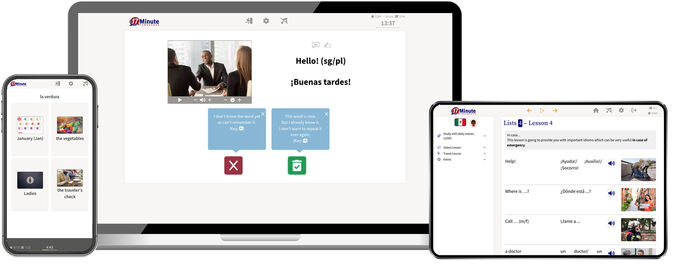
Free Mexican Spanish trial version

You are using an outdated browser. Please upgrade your browser or activate Google Chrome Frame to improve your experience.
Important Spanish Travel Phrases (with Downloadable PDF)
Have you been dreaming about your upcoming vacation to Spain?
Eagerly awaiting your backpacking trek through South America?
Whatever the case, your trip to any Spanish-speaking country will be so much more fun and meaningful if you can communicate with locals .
But what kind of Spanish travel phrases do you even need to know?
Below are the essentials— the most common Spanish phrases for travel to help you upgrade your trip from “goodw” to “great.”
1. Basic Spanish Greetings and Phrases
2. basic spanish phrases for everyday use, 3. asking for directions in spanish, 4. spanish travel phrases for the hotel, 5. spanish travel phrases for the restaurant, 6. spanish phrases for the airport and ticket offices, 7. medical emergencies in spanish, 8. spanish phrases for having a bit of fun, and one more thing….
Download: This blog post is available as a convenient and portable PDF that you can take anywhere. Click here to get a copy. (Download)

Spanish-speaking countries are generally very polite and you must always be courteous and say “hello” and “how are you?”
Don’t worry about making mistakes. Most people will try their utmost to understand you and to make sure you understand them. Try your best and they will be happy to reciprocate!
- Buenos días — Good morning
- Buenas tardes — Good afternoon
- Buenas noches — Good evening
- ¿Cómo te llamas? — What’s your name? (informal)
- ¿Cómo se llama? — What’s your name? (formal)
- Me llamo… — My name is…
- Mucho gusto — Nice to meet you
- ¿Cómo estás? — How are you? (informal)
- ¿Cómo está? — How are you? (formal)
- Bien, gracias — Good, thank you
- Por favor — Please
- Gracias — Thank you
- Perdón — S orry
- ¿Habla inglés? — Do you speak English?
- No hablo español — I don’t speak Spanish
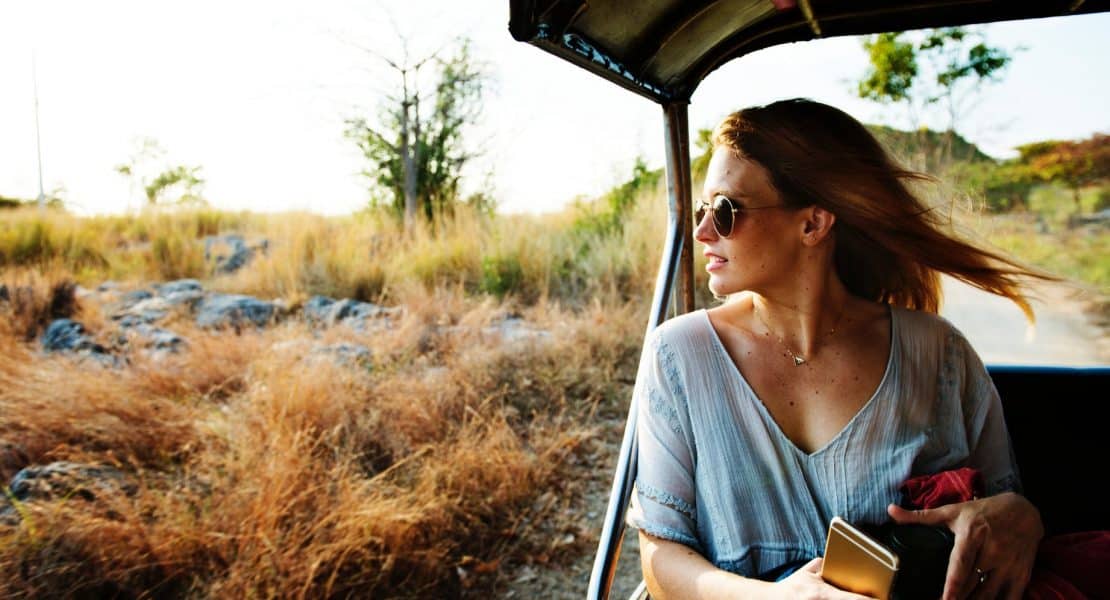
You can go far with some very easy-to-remember travel phrases and words.
You’ll likely use “I want,” “I like” and “Do you have…?” quite often. If you don’t know the noun, you can simply point at the object or show a photo.
You can also say a lot of things with very simple verbs we’re about to introduce. It may not be the sophisticated way you speak in English, but you will be understood.
- Quiero / No quiero — I want / I don’t want
- Me gustaría ; Quisiera — I would like (more polite)
- ¿Dónde está…? — Where is…? Since dónde ends in e and está starts with one, these two words flow into each other, almost like they were a single word.
- ¿Cuánto cuesta? — How much does it cost?
- ¿Qué hora es? — What time is it?
- ¿Tiene…? — Do you have…?
- Tengo / No tengo — I have / I don’t have
- Entiendo / No entiendo — I understand / I don’t understand
- ¿Entiende? — Do you understand?
- Quiero un boleto — I want a ticket
…un hotel — …a hotel
…un taxi — …a taxi
- No funciona — It doesn’t work
That last one is an all-purpose word . You can use this for a million circumstances! Just point at the shower or whatever and say “ ¡No funciona!”
What we’ve seen so far is basic survival Spanish, so even if you can only remember these words and phrases, they’ll still help a great deal.
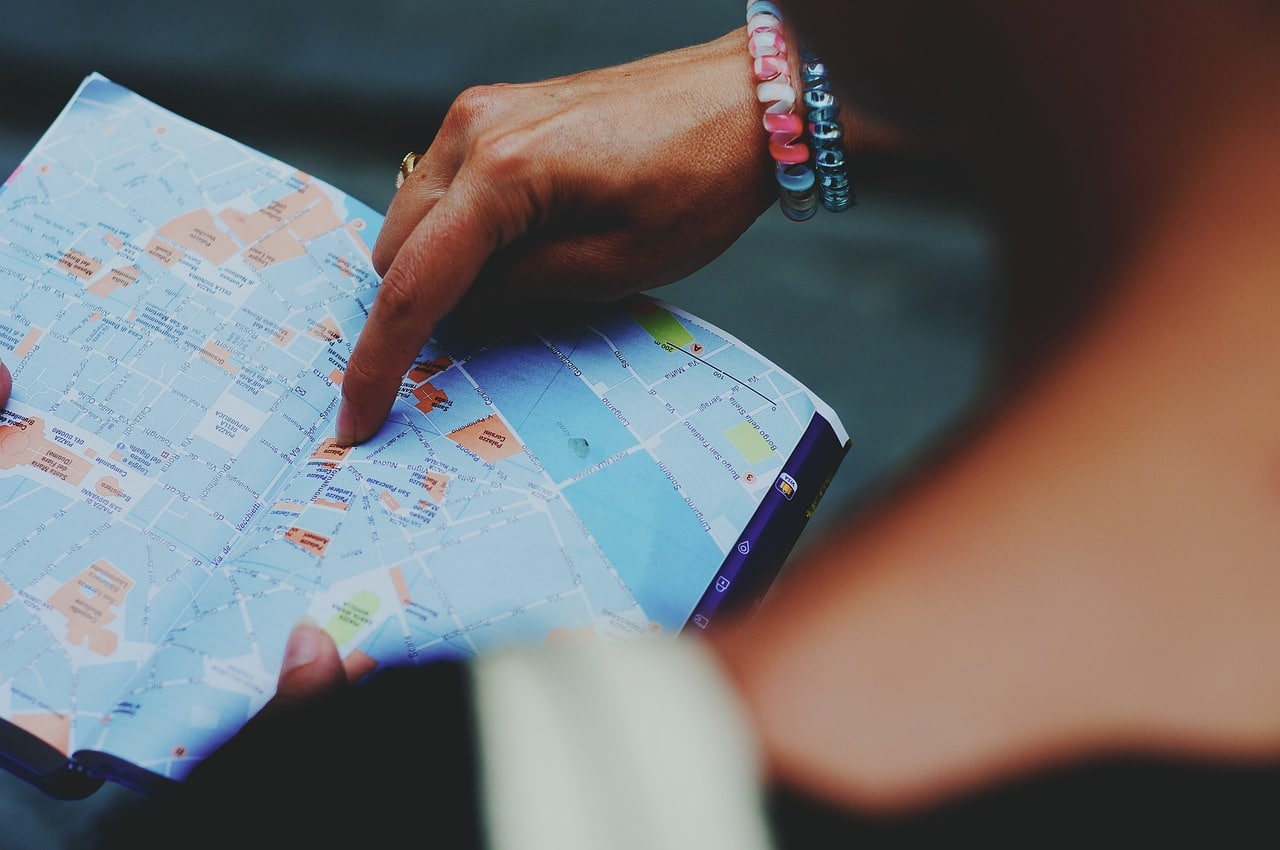
If you get a bit lost or unsure of how to get somewhere, “¿dónde está?” is the simplest way of asking for directions. Here are a few more phrases, locations and other directions in Spanish that will be helpful on your trip:
- ¿Dónde está la estación de ferrocarril? — Where is the railway station?
- ¿Dónde hay un restaurante? — Where is a restaurant?
- Un tren — A train
- La calle… — The street…
- Un banco — A bank
- El baño — The bathroom
- Busco un hotel — I’m looking for a hotel
- Necesito un hotel — I need a hotel
…un cuarto — …a room
…un cuarto con baño — …a room with a bathroom
- ¿Dónde hay una casa de cambio? — Where is the currency exchange?
- ¿Dónde está el banco? — Where is the bank?
- Dinero — Money
Once you have asked a question, someone will answer you in Spanish. Listen for these key words:
- A la derecha — To the right
- A la izquierda — To the left
- Derecho — Straight ahead
- En la esquina — At the corner
- A una cuadra — In one block
…dos cuadras — …two blocks
…tres cuadras — …three blocks
…cuatro cuadras — …four blocks
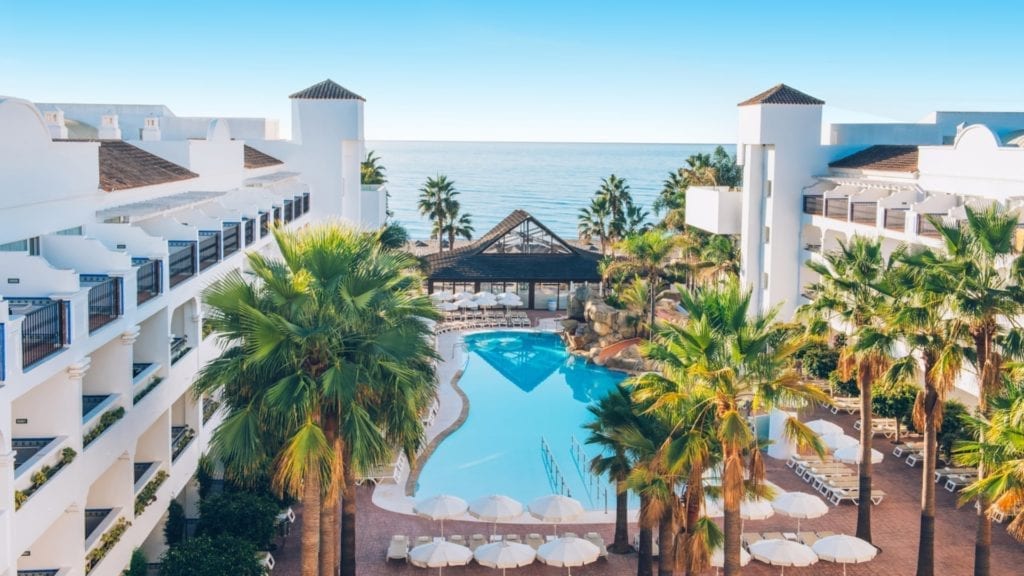
You’ve finally found your hotel and you’re ready to check in!
Staff at international chains will probably be able to communicate in English with you, but these phrases and questions will come in handy for local hotels, hostels, bed and breakfasts, etc.
These will also be helpful when you need to make adjustments to your reservation or are curious about other hotel amenities.
- Tengo una reserva a nombre de… — I have a reservation under the name of…
- Estadía de tres noches — Three-night stay
- Una habitación para dos personas — A room for two people
- Una habitación con una cama de matrimonio — A room with a double bed As you can see, habitación is a synonym of cuarto . You can use either term when booking a room.
- ¿Dónde está la piscina? — Where is the pool?
- ¿A qué hora es el desayuno? — What time is breakfast?
- ¿Puedo solicitar una salida tardía? — Can I request a late check-out?
- ¿Tiene servicio de habitaciones? — Do you have room service?
- ¿ Cuál es la contraseña de WiFi ? — What is the WiFi password?
- Una cama supletoria — An extra bed
- Vista al mar — Ocean view
- Vista a la ciudad — City view
- Un balcón — A balcony
- La terraza — The rooftop / terrace
- El gimnasio — The gym
- La playa — The beach
- El vestíbulo — The lobby

Probably the most useful travel phrases you will need are the ones you would use in a restaurant. Let’s go over some basic restaurant vocabulary in Spanish :
Ask for anything by using quiero or quisiera — “I want” or “I would like.” And remember to say por favor and gracias!
- Una mesa — A table
- Una mesa para dos — A table for two
…tres — …three
…cuatro — …four
- Un menú / Una carta — A menu
- Sopa — Soup
- Ensalada — Salad
- Hamburguesa — Hamburger
- Con salsa de tomate — With ketchup
…mostaza — …mustard
…tomate — …tomato
…lechuga — …lettuce
- Una entrada — An appetizer
- Un postre — Dessert
- Una bebida — A drink
- Agua — Water
- Vino tinto / Vino blanco — Red wine / White wine
- Cerveza — Beer
- Un café — Coffee
- ¡Señor! / ¡Señorita! — Mister / Miss (when calling a waiter or waitress)
- La cuenta — The check
- Una tarjeta de crédito — A credit card
- Una tarjeta de débito — A debit card
- Pagar en efectivo — Pay in cash
Note that many places in smaller towns still don’t take credit cards , so make sure you have enough cash with you.
You can ask if a place takes credit cards by using the noun with a question. For example, you can pull out your credit card and say: ¿Tarjeta de crédito? They will understand.
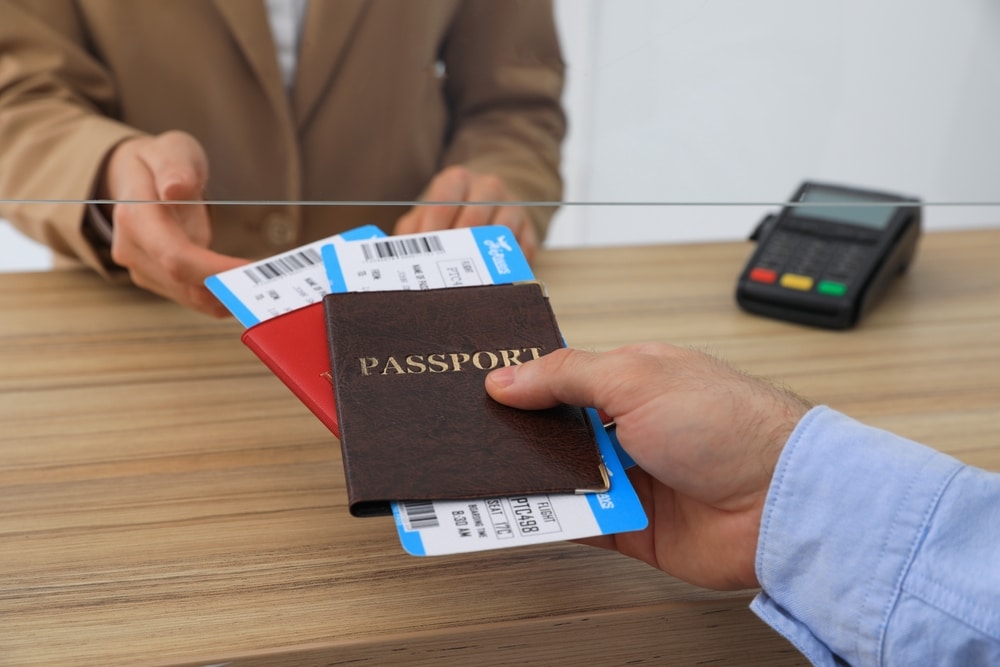
It’s time to soak in some culture ! Whether you want to go see a show, check out an art exhibit, watch a local movie or visit the next town (or country) over, you’ll need to buy some sort of ticket.
We’ll start with some airport-specific vocabulary —bearing in mind that many of these phrases are versatile and can be used in various situations—followed by more general vocabulary.
- Su pasaporte, por favor — Your passport, please
- Quisiera cambiar mi reserva — I would like to change my reservation
- ¿Podría elegir mi asiento? — Could I choose my seat?
- Quisiera cambiar mi asiento — I would like to change my seat
- Este es mi equipaje de mano — This is my carry-on luggage
- ¿Se ha cancelado el vuelo? — Has the flight been canceled?
- ¿Dónde está la terminal internacional? — Where is the international terminal?
- ¿Dónde está la puerta de embarque? — Where is the boarding gate?
- ¿A qué hora es el embarque? — What time is boarding?
Earlier we defined entrada as an “appetizer.” Entrada has multiple meanings related to “start” or “entry,” so you can also use it to say “ticket.”
- ¿Cuánto cuesta una entrada? — How much does a ticket cost?
- Dos boletos de ida y vuelta — Two roundtrip tickets
- ¿ Tiene un pase de un día ? — Do you have a one-day pass?
- ¿A qué hora sale el próximo tren ? — What time does the next train leave?
- ¿De qué plataforma sale? — Which platform does it leave from?
- ¿Qué puerta? — Which gate?
For more specific situations, here are some words and phrases you might need when purchasing tickets:
- El espectáculo — The show / performance
- El teatro — The theater
- La exposición — The exhibit
- El cine — The cinema
- Una película — A movie
- Un vuelo — A flight
- Viaje de ida — One-way trip
- Viaje de ida y vuelta — Return trip / round trip
- El asiento de pasillo — The aisle seat
- El asiento de ventanilla — The window seat
- La primera fila — The first row
La segunda fila — The second row
La tercera fila — The third row
La cuarta fila — The fourth row
Also, as you’ve likely noticed, for anything dealing with money or quantities, you’ll want to be familiar with numbers in Spanish .
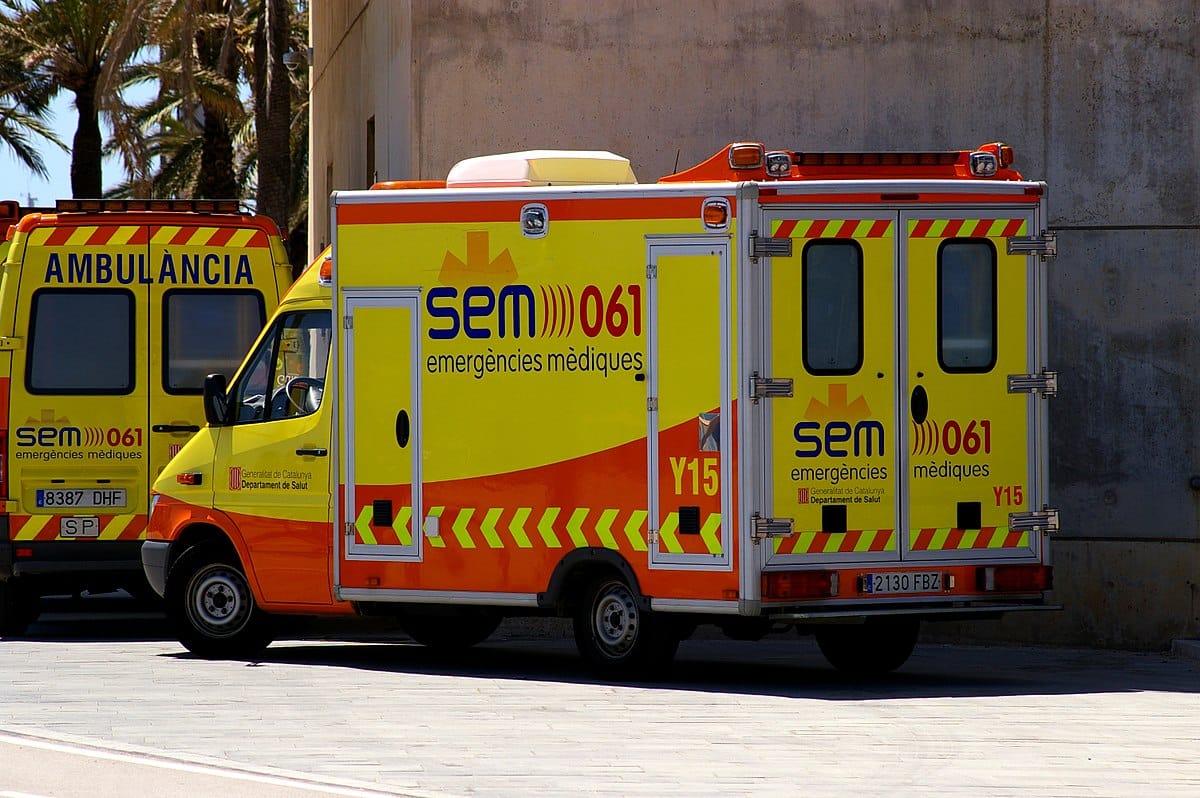
A smart traveler always comes prepared with some emergency over-the-counter meds. After all, you never know what could happen when you’re overseas.
But when those aren’t enough, these are the phrases that will help with your health-related concerns when in a Spanish-speaking country:
- ¿Dónde está la farmacia? — Where is the pharmacy?
- ¿Dónde está el hospital más cercano? — Where is the nearest hospital?
- Seguro de salud internacional — International health insurance
- No me siento bien — I feel sick / I don’t feel well
- ¿El doctor habla inglés? — Does the doctor speak English?
- ¿Necesito una receta? — Do I need a prescription?
- ¿Qué medicina necesito? — What medicine do I need?
- La cita médica — Doctor’s appointment
- La cita de seguimiento — Follow-up appointment
If you need help explaining your symptoms, these terms will help you out. With the exception of the last phrase, start off by saying tengo , followed by any of the below:
- Un resfriado — A cold
- Dolor de garganta — Sore throat
- Tos — Cough
- Fiebre — Fever
- Dolor de cabeza — Headache
- Dolor de estómago — Stomachache
- Dolor de espalda — Backache
- Resaca — Hangover
- Me gotea la nariz — I have a runny nose

Of course, a trip to a Spanish-speaking country wouldn’t be complete without a little ¡fiesta! (carnival; party). If you’re keen to hit the town, here are a few phrases to help you get your groove on.
- ¡Salud! — Cheers!
- ¿Hay algún bar por aquí? — Is there a bar around here?
- ¿Dónde están las discotecas? — Where are the clubs?
- ¿A qué hora abren las discotecas? — What time do the clubs open?
- ¿Me recomienda un lugar para bailar? — Can you recommend me a place to dance?
- ¿Quieres bailar conmigo? — Do you want to dance with me?
- ¡Bailemos! — Let’s dance!
FluentU takes authentic videos—like music videos, movie trailers, news and inspiring talks—and turns them into personalized language learning lessons.
You can try FluentU for free for 2 weeks. Check out the website or download the iOS app or Android app.
P.S. Click here to take advantage of our current sale! (Expires at the end of this month)

Try FluentU for FREE!
Do you feel more prepared for your trip now? Pack these Spanish travel phrases with the rest of your essentials and you’ll be sure to get the most from your vacation!
If you've made it this far that means you probably enjoy learning Spanish with engaging material and will then love FluentU .
Other sites use scripted content. FluentU uses a natural approach that helps you ease into the Spanish language and culture over time. You’ll learn Spanish as it’s actually spoken by real people.
FluentU has a wide variety of videos, as you can see here:

FluentU brings native videos within reach with interactive transcripts. You can tap on any word to look it up instantly. Every definition has examples that have been written to help you understand how the word is used. If you see an interesting word you don’t know, you can add it to a vocab list.

Review a complete interactive transcript under the Dialogue tab, and find words and phrases listed under Vocab .

Learn all the vocabulary in any video with FluentU’s robust learning engine. Swipe left or right to see more examples of the word you’re on.

The best part is that FluentU keeps track of the vocabulary that you’re learning, and gives you extra practice with difficult words. It'll even remind you when it’s time to review what you’ve learned. Every learner has a truly personalized experience, even if they’re learning with the same video.
Start using the FluentU website on your computer or tablet or, better yet, download the FluentU app from the iTunes or Google Play store. Click here to take advantage of our current sale! (Expires at the end of this month.)
Related posts:
Enter your e-mail address to get your free pdf.
We hate SPAM and promise to keep your email address safe

- Skip to primary navigation
- Skip to main content
- Skip to primary sidebar
- Skip to footer
StoryLearning
Learn A Language Through Stories
67 Essential Spanish Travel Phrases Every Traveller Needs To Know
Spain. Mexico. Argentina. Peru. Colombia.
If you're learning Spanish , the mere the mention of these countries can leave you daydreaming about your next trip abroad.
And although there are many incredible things to do and see in Spanish-speaking countries, what really makes these places special are the local people.
So before you pack your bags and jump on a plane, why not learn a little Spanish to help you make the most of your trip?
In this post, you’ll learn 67 Spanish phrases for travel that can help you survive in the language during your trip abroad.
It's the best way to learn Spanish for travel and vacations. And who knows, they might even help you make a few new friends too!
To make it easier for you, I’ve divided the Spanish travel phrases up into different categories:
Table of Contents
Take the time to learn a few of these most common Spanish phrases for travel and you’ll be able to mix with the locals, get by in various situations and have a much more enjoyable and authentic experience during your trip.
By the way, if you want to learn Spanish in time for your trip, my top recommendation for language learners is my Uncovered courses, which teach you through StoryLearning®. Click here to find out more and try out the method for free.
Keep scrolling to discover all 67 Spanish travel words and expressions.
First Things First: Greetings To Use On Arrival
Knowing how to greet people is the most basic thing you can learn in a foreign language. And yet its importance shouldn't be underestimated.
Even if you aren’t fluent enough to hold a long conversation, a simple ¡Hola! ¿Qué tal? (Hello, how are you?) can make all the difference.
You'll be able to use these essential Spanish phrases for travel as soon as you arrive at your destination, whether it's at the airport, the train or bus station, or the hotel.
People appreciate it if you make an effort to speak their language when you visit their country, even if it’s only a few words.
Spanish-speaking countries are especially polite and greeting people correctly will go a long way towards endearing you to the locals, be they friends, people you meet in shops or on the street.
- ( BWAY-nos DEE-as)
- (BWAY-nas TAR-des)
- (BWAY-nas NOH-chays)
- (KOH-moh eh-STAH)
- (KOH-moh eh-STAHS)
- (bee-EN GRA-thee-as [Spain] / GRA-see-as [Latin America])
- (KOH-moh te YA-mas?)
- (May YA-moh… )
- (MOO-choh GOO-stoh)
And of course, let’s not forget common courtesy!
- (por fa-BOR)
- (GRA-thee-as [Spain] / GRA-see-as [Latin America])
If you get stuck in your Spanish conversation, you can always fall back on these next two Spanish travel phrases to get you out of trouble.
- (yo no en-tee-EN-doh)
- (Ab-la in-GLAYS)
Get What You Want On Your Trip With The Verb Querer
Once you’ve finished greeting someone, you’ll need to be able to move on to the crux of your conversation and to do that you’ll need to learn a couple of common verbs.
There are hundreds of Spanish verbs to learn and, to make your life more difficult, these verbs conjugate (change form).
This means learning a verb is never as simple as learning one word; you have to learn multiple different forms.
Having said that, you might be surprised by how far you can get only knowing one simple verb: I want .
It may not make you the most sophisticated Spanish speaker but 9 times out of 10 it will get you what you, well, want .
The verb in question is querer (to want) and in the first person form, it becomes quiero (I want).
Let’s take a look at how you can use it:
- (yo kee-EH-ro oon me-NOO)
- (YO kee-EH-ro oon taxi)
- (yo kee-EH-ro OO-na ser-BAY-za)
If you’d like to be a bit more polite (which is usually a good idea), you can also use:
- (kee-see-EH-ra…)
Asking For & Understanding Directions On Your Trip
Whether you’re looking for the toilet in a restaurant or trying to find a hotel to stay at, you’ll inevitably need to ask for directions at some point during your trip.
The simplest way to ask where something is, is to use ¿Dónde está? followed by the noun you are looking for:
- (DON-day es-TAH el BAH-nyo?)
- (DON-day es-TAH el BAN-koh?)
- (DON-day es-TAH la KA-yay de al-cal-AH?)
When travelling in a foreign country, if you're asking someone on the street for directions, don’t forget your manners! To get someone’s attention, start by saying:
- (Dis-KUL-pay)
- (Con per-MEE-soh / Per-DOH-nah-may)
- (eh- stoy per-DEE-doh)
Asking for directions is one thing but it’s pretty pointless if you don’t know how to understand the directions that are given to you!
Memorise these phrases to help you understand what the friendly locals are trying to tell you when you ask for their help:
- (A la de-RE-cha)
- (A la iz-kee-ER-da)
- (De-RE-cho)
- (En la es-KEE-nah)
- (a OO-na KWAD-rah)
Getting Around Spanish-Speaking Countries
If you’re not keen on walking everywhere, you'll need to be able to find out about local transport options to find your way around wherever you are.
Whether you're travelling to Mexico , Spain or anywhere else in the Hispanic world, here are a few basic Spanish travel phrases you can use to locate a bus, train or taxi and get to wherever you need to go:
- (DON-day PWAY-doh en-kon-TRAR oon taxi?)
- (DON-day eh-STAH la pa-RAH-dah de ow-to-BOOS mas ser-KA-nah?)
- (DON-day eh-STAH la es-tah-see-ON de ferro-carr-EEL mas ser-KA-nah?)
- (KWAN-to KWES-ta oon bee-YET-ay PA-ra …)
- (oon bee-YET-ay PA-ra … por fa-BOR)
At A Restaurant On Your Travels
Each Spanish-speaking country has its own unique flavours and cuisine for you to try when you travel!
Food is definitely one of the big attractions to cities like San Sebastian in Spain and Buenos Aires in Argentina , so you'll need to make sure you have a basic grasp of food vocabulary ahead of your journey!
To start with, you need to be prepared to hear and understand certain questions in restaurants, such as:
- (kee-EH-res AL-go PA-ra koh-MER?)
- (kee-EH-res AL-go PA-ra beh-BER?)
- (KAY kee-EH-res koh-MER?)
When you read the menu, you'll see the available food grouped into different categories, just like in an English menu:
- (oo-na en-TRA-da)
- (oon PLA-toh prin-si-PAL)
- (oon POS-tray)
- (OO-na beh-BEE-da)
When you're ready to order, use either quiero (I want) or quisiera (I would like) with the items on the menu to tell the waiter what you'd like. For example, quiero…
- (OO-na SOH-pah)
- (OO-na en-sa-LA-da)
- (el POY-oh)
- (la CAR-nay)
- (oon AG-wa)
- (oon BEE-noh TIN-toh / BLAN-koh)
- (OO-na ser-BAY-sa)
- (oon ka-FAY)
So, for example, to order that ice-cold beer you're looking forward to at the end of a long day, you'd say quiero una cerveza.
If you're not sure what to try, you can always ask your waiter for a recommendation:
- (kay may re-kom-ee-EN-dah?)
In most restaurants in Spanish-speaking countries, the staff will be more than happy to suggest a particularly tasty local dish for you to try.
If you're a vegetarian or you have dietary complications, these next two Spanish travel phrases are essential:
- (soy be-he-tah-ree-AH-noh/nah)
- (TEN-go al-ER-hee-ah a las noo-EH-ses)
Finally, let's learn a couple of quick phrases you can use to ask about prices and pay the bill.
- (KWAN-to KWES-ta? )
- (la KWEN-ta por fa-BOR)
Key Spanish Question Words For Your Trip
Over the course of your journey, you'll almost certainly find yourself asking lots and lots of questions.
You might not have a huge Spanish vocabulary to draw on, but if you know the basic question words, you'll be able to get by in almost any common situation you might find yourself in.
Here are some key Spanish question words you need to know:
- (KWAN-doh?)
- (A kay AW-ra?)
- (KWAN-toh?)
- (KWAN-tohs)
- (kah-dah KWAN-toh?)
- (por KWAN-toh tee-EM-poh)
Once you’ve got these question words in your memory bank you’ll start noticing the patterns in Spanish grammar which will help you to move away from the basic Spanish phrases every tourist is using.
As you learn new words on your trip, you'll be able to combine them with these question words to start forming your own sentences and questions!
FAQs About Spanish Travel Phrases
What are 10 vacation phrases in Spanish?
The 10 key vacation phrases in Spanish are: 1. ¡Hola! (Hello) 2. Por favor (Please) 3. Gracias (Thank you) 4. Disculpe (Excuse me) 5. ¿Habla inglés? (Do you speak English?) 6. Quiero un menú (I want a menu) 7. ¿Dónde está el cajero automático? (Where is the ATM?) 8. ¿Cuánto cuesta? (How much is it?) 9. ¿Dónde puedo encontrar un taxi? (Where can I get a taxi?) 10. Un billete para Barcelona, por favor. (A ticket to Barcelona, please.)
What is a popular Spanish phrase?
If you’re visiting a Spanish-speaking country, the most popular phrase you’ll use will be the basic greeting Hola , which means “Hello.”
Other possible examples are greetings like Buenos días (Good morning), Buenas tardes , (Good afternoon) and Buenas noches , (Good evening) as well as everyday expressions like Gracias (Thank you) Por favor (Please) and Perdón (Sorry).
What is the vocabulary for travelling in Spanish?
The vocabulary for travelling in Spanish is made up of different kinds of basic words and phrases.
First, familiarise yourself with the belongings and key objects you’re bringing to the aeropuerto (airport) or estación (station):
Equipaje (Luggage) Maleta (Suitcase) Mochila (Backpack) Pasaporte (Passport) Boleto (Ticket)
Then, name some of the attractions you could visit in the next city you visit:
Monumento (Monument) Museo (Museum) Plaza (Square) Parque (Park) Edificio histórico (Historic building) Cine (Cinema) Restaurante (Restaurant) Catedral (Cathedral) Iglesia (Church) Puente (Bridge) Zona comercial (Shopping area)
What are the 7 most common words to survive in a Spanish-speaking country?
1. ¡Hola! (Hello) 2. Por favor (Please) 3. Gracias (Thank you) 4. Disculpe (Excuse me) 5. ¿Dónde? (Where?) 6. ¿Cuánto cuesta? (How much is it?) 7. Quiero… (I want…)
Get Ready For Adventure With These Spanish Travel Phrases!
Taking the time to learn Spanish travel phrases means you'll have everything you need to get the most out of your journey.
With just a few Spanish travel phrases, I'm sure you'll meet lots of amazing people and have plenty of life-changing experiences along the way.
Who knows, perhaps spending some time visiting a Spanish-speaking country will motivate you to strive for fluency?
If this article has inspired you to both travel and to learn Spanish, then I've got something to get you started on your Spanish learning journey.
I'm a big believer in the power of story to enable you to learn a language. That's why I've created an entire beginner course dedicated to learning Spanish by immersing yourself in an engaging story.
It's my Spanish Uncovered course, and it's designed to take you from beginner to B1 Intermediate level.
Click here for more information on the course, test it out for free and to find out how it'll help you.
Language Courses
- Language Blog
- Testimonials
- Meet Our Team
- StoryLearning Reviews
- Media & Press
Which language are you learning?
What is your current level in [language]?
Perfect! You’ve now got access to my most effective [level] [language] tips…
Where shall I send them?
We will protect your data in accordance with our data policy.
Download this article as a FREE PDF ?
What is your current level in Latin?
Perfect! You’ve now got access to my most effective [level] Latin tips…
Where shall I send the tips and your PDF?
What is your current level in Norwegian?
Perfect! You’ve now got access to my most effective [level] Norwegian tips…
Download Your Free StoryLearning® Kit!
Discover the world famous story-based method that 1,023,037 people have used to learn a language quickly…, not interested.
What can we do better ? If I could make something to help you right now, w hat would it be?
Perfect! You’ve now got access to my most effective [level] [language] tips…
What is your current level in Swedish?
Perfect! You’ve now got access to my most effective [level] Swedish tips…
What is your current level in Danish?
Perfect! You’ve now got access to my most effective [level] Danish tips…
What can we do better? If I could make something to help you right now, w hat would it be?
What is your current level in [language] ?
Perfect! You’ve now got access to my most effective [level] [language] tips, PLUS your free StoryLearning Kit…
Download this article as a FREE PDF?
Great! Where shall I send my best online teaching tips and your PDF?
Download this article as a FREE PDF ?
What is your current level in Arabic?
Perfect! You’ve now got access to my most effective [level] Arabic tips…
FREE StoryLearning Kit!
Join my email newsletter and get FREE access to your StoryLearning Kit — discover how to learn languages through the power of story!
Download a FREE Story in Japanese!
Enter your email address below to get a FREE short story in Japanese and start learning Japanese quickly and naturally with my StoryLearning® method!
What is your current level in Japanese?
Perfect! You’ve now got access to the Japanese StoryLearning® Pack …
Where shall I send your download link?
Download Your FREE Natural Japanese Grammar Pack
Enter your email address below to get free access to my Natural Japanese Grammar Pack and learn to internalise Japanese grammar quickly and naturally through stories.
Perfect! You’ve now got access to the Natural Japanese Grammar Pack …
What is your current level in Portuguese?
Perfect! You’ve now got access to the Natural Portuguese Grammar Pack …
What is your current level in German?
Perfect! You’ve now got access to the Natural German Grammar Pack …
Train as an Online Language Teacher and Earn from Home
The next cohort of my Certificate of Online Language Teaching will open soon. Join the waiting list, and we’ll notify you as soon as enrolment is open!
Perfect! You’ve now got access to my most effective [level] Portuguese tips…
What is your current level in Turkish?
Perfect! You’ve now got access to my most effective [level] Turkish tips…
What is your current level in French?
Perfect! You’ve now got access to the French Vocab Power Pack …
What is your current level in Italian?
Perfect! You’ve now got access to the Italian Vocab Power Pack …
Perfect! You’ve now got access to the German Vocab Power Pack …
Perfect! You’ve now got access to the Japanese Vocab Power Pack …
Download Your FREE Japanese Vocab Power Pack
Enter your email address below to get free access to my Japanese Vocab Power Pack and learn essential Japanese words and phrases quickly and naturally. (ALL levels!)
Download Your FREE German Vocab Power Pack

Enter your email address below to get free access to my German Vocab Power Pack and learn essential German words and phrases quickly and naturally. (ALL levels!)
Download Your FREE Italian Vocab Power Pack
Enter your email address below to get free access to my Italian Vocab Power Pack and learn essential Italian words and phrases quickly and naturally. (ALL levels!)
Download Your FREE French Vocab Power Pack
Enter your email address below to get free access to my French Vocab Power Pack and learn essential French words and phrases quickly and naturally. (ALL levels!)
Perfect! You’ve now got access to the Portuguese StoryLearning® Pack …
What is your current level in Russian?
Perfect! You’ve now got access to the Natural Russian Grammar Pack …
Perfect! You’ve now got access to the Russian StoryLearning® Pack …
Perfect! You’ve now got access to the Italian StoryLearning® Pack …
Perfect! You’ve now got access to the Natural Italian Grammar Pack …
Perfect! You’ve now got access to the French StoryLearning® Pack …
Perfect! You’ve now got access to the Natural French Grammar Pack …
What is your current level in Spanish?
Perfect! You’ve now got access to the Spanish Vocab Power Pack …
Perfect! You’ve now got access to the Natural Spanish Grammar Pack …
Perfect! You’ve now got access to the Spanish StoryLearning® Pack …
Where shall I send them?
What is your current level in Korean?
Perfect! You’ve now got access to my most effective [level] Korean tips…
Perfect! You’ve now got access to my most effective [level] Russian tips…
Perfect! You’ve now got access to my most effective [level] Japanese tips…
What is your current level in Chinese?
Perfect! You’ve now got access to my most effective [level] Chinese tips…
Perfect! You’ve now got access to my most effective [level] Spanish tips…
Perfect! You’ve now got access to my most effective [level] Italian tips…
Perfect! You’ve now got access to my most effective [level] French tips…
Perfect! You’ve now got access to my most effective [level] German tips…
Download Your FREE Natural Portuguese Grammar Pack
Enter your email address below to get free access to my Natural Portuguese Grammar Pack and learn to internalise Portuguese grammar quickly and naturally through stories.
Download Your FREE Natural Russian Grammar Pack
Enter your email address below to get free access to my Natural Russian Grammar Pack and learn to internalise Russian grammar quickly and naturally through stories.
Download Your FREE Natural German Grammar Pack
Enter your email address below to get free access to my Natural German Grammar Pack and learn to internalise German grammar quickly and naturally through stories.
Download Your FREE Natural French Grammar Pack
Enter your email address below to get free access to my Natural French Grammar Pack and learn to internalise French grammar quickly and naturally through stories.
Download Your FREE Natural Italian Grammar Pack
Enter your email address below to get free access to my Natural Italian Grammar Pack and learn to internalise Italian grammar quickly and naturally through stories.
Download a FREE Story in Portuguese!

Enter your email address below to get a FREE short story in Brazilian Portuguese and start learning Portuguese quickly and naturally with my StoryLearning® method!
Download a FREE Story in Russian!
Enter your email address below to get a FREE short story in Russian and start learning Russian quickly and naturally with my StoryLearning® method!
Download a FREE Story in German!
Enter your email address below to get a FREE short story in German and start learning German quickly and naturally with my StoryLearning® method!
Perfect! You’ve now got access to the German StoryLearning® Pack …
Download a FREE Story in Italian!
Enter your email address below to get a FREE short story in Italian and start learning Italian quickly and naturally with my StoryLearning® method!
Download a FREE Story in French!

Enter your email address below to get a FREE short story in French and start learning French quickly and naturally with my StoryLearning® method!

Download a FREE Story in Spanish!
Enter your email address below to get a FREE short story in Spanish and start learning Spanish quickly and naturally with my StoryLearning® method!
FREE Download:
The rules of language learning.

Enter your email address below to get free access to my Rules of Language Learning and discover 25 “rules” to learn a new language quickly and naturally through stories.
Download Your FREE Spanish Vocab Power Pack

Enter your email address below to get free access to my Spanish Vocab Power Pack and learn essential Spanish words and phrases quickly and naturally. (ALL levels!)
Download Your FREE Natural Spanish Grammar Pack
Enter your email address below to get free access to my Natural Spanish Grammar Pack and learn to internalise Spanish grammar quickly and naturally through stories.
Free Step-By-Step Guide:
How to generate a full-time income from home with your English… even with ZERO previous teaching experience.
What is your current level in Thai?
Perfect! You’ve now got access to my most effective [level] Thai tips…
What is your current level in Cantonese?
Perfect! You’ve now got access to my most effective [level] Cantonese tips…
Steal My Method?
I’ve written some simple emails explaining the techniques I’ve used to learn 8 languages…
I want to be skipped!
I’m the lead capture, man!
Join 84,574 other language learners getting StoryLearning tips by email…
“After I started to use your ideas, I learn better, for longer, with more passion. Thanks for the life-change!” – Dallas Nesbit
Perfect! You’ve now got access to my most effective [level] [language] tips…
Find The Perfect Language Course For You!
Looking for world-class training material to help you make a breakthrough in your language learning?
Click ‘start now’ and complete this short survey to find the perfect course for you!
Do you like the idea of learning through story?
Do you want…?

95 Spanish Travel Phrases And Expressions You Need to Learn With Pronunciation
If you’re looking to learn some basic Spanish for a trip to a Spanish-speaking country, going the whole “grammar and word list” route is a bit complex and time-consuming.
Good news: learning Spanish travel phrases instead won’t only help you learn Spanish you can use right away in conversations…
Contrary to what many people think, such phrases aren’t even just a quick “hack” but a valid long-term strategy to learn Spanish and other languages (as I outline in my article about Spanish for beginners ).
Anyway, more on that in a bit. First, let’s teach you some Spanish travel phrases!
1. Spanish Travel Phrases to Use Upon Arrival
First things first. If you’re planning to go to a Spanish-speaking country, learning how to greet people and be polite is a must. Otherwise, starting a Spanish conversation can be difficult.
No matter what kind of transportation you use to get to a Spanish-speaking place, you probably will have to deal with different kinds of workers.

The best thing you can do if you want to ask for information, or just catch some worker’s attention, is to be polite and show respect.
Keep in mind that if you want to be formal, you’ll say and conjugate verbs using “ usted ”. If you’re just talking with friends or someone you know, it’s enough to use “ tú ”.
Now, let’s see some chunks that will help you be ready on Arrival at your destination.
Spanish phrases for greetings and check-in
Since you’re trying to improve your Spanish, we would recommend not to use “¿Habla ingles?” as the first alternative. If you do it, natives will try to find someone that could speak with you in English.
Yet, if you find that communicating becomes complicated, it may save your day.
On the other hand, using “ ¿Me puede ayudar? ” is among the best alternatives if you need help when arriving at the airport or any place. People will know immediately that you require assistance to do or get something.
If you use transportation like Taxis or Buses, dealing with luggage isn’t a challenge. But, if you take an airplane, and finding your luggage isn’t that easy, you can take advantage of the last phrase above.
No matter what your needs are, you should always use the following chunks if someone helps you or you ask for help.
Ask for help with these chunks
Saying “ Por favo r” and “ Gracias ” will not only help you to show respect. Also, they will indeed help you to “open” doors as people will always be willing to help you one more time.
For more airport Spanish, watch this video by Paulisima from Spring Spanish (a YouTube channel I co-founded):
2. Spanish Travel Phrases When You Need or Want Something
When traveling, Necesitar and Querer are two Spanish verbs that will help you in several situations.

There are plenty of Spanish chunks you can learn and use with Necesitar and Querer . However, we will stick to the most important.
Travel vocabulary in Spanish: Necesitar and Querer
With these Spanish travel phrases, you’ll get any problem solved. From your basic needs to things on your bucket list like going partying in a Spanish-speaking country.
3. Spanish Travel Phrases for Partying
Latin American people are among the most cheerful people all over the world, and hanging out with them is an unforgettable activity.
You could learn the following Spanish phrases when you’re out having the best time of your life! 😉
Spanish Phrases for When You’re Partying
There are plenty of other Spanish phrases for travel you could learn… and in general, learning as many fixed phrases as possible (or chunks, as we call them) will help you speak Spanish more effortlessly in all kinds of situations.
You can learn them through actual conversation, but also through Spanish podcasts, Spanish YouTube channels , or check out the best Spanish shows on Netflix.
If you’d like to learn more about learning Spanish through chunks, go ahead and request your free Spanish Chunking Starter Pack.
4. Spanish Travel Phrases When Asking for Directions
Although most Spanish speakers are quite friendly because of their culture and way of living, getting along with them on the streets may not be as simple as that. It’s because some people feel that talking to strangers isn’t appropriate or just “not safe”.
When approaching someone you don’t know on the streets, you must keep your distance and use some of the following Spanish phrases.
Approach someone with these chunks
The approach is the most important step. After, it’s time to ask or request what you need. If you’re lost and you need an address or need help, the following chunks will help you get the job done.
Travel tips: Get help with these Spanish chunks
After you get all you need and it’s time to move forward, saying “ Gracias ” to the ones who helped you is essential.
It’s always important to say thanks. It will help you end the conversation and leave an “ open door ” to ask for help again if necessary.
Time to see some of these phrases/chunks in action! Here’s Maria Fernanda, one of the Spring Spanish teachers:
5. Spanish Travel Phrases for the Hotel
If you’re a traveler there’s no doubt that you’ll face some challenges when looking for accommodation. Let’s imagine you need to get a room and you have to talk to the staff of a hotel. Depending on your needs, there are several things you’ll have to ask.

For example, room type, if the price includes breakfast, or other things like if you have access to the pool.
Solve challenges at a hotel with these Spanish phrases
Please note that if you have made a reservation, you’ll need either your name or a reservation number. If you get a reservation number, you would say “ Hice una reserva con número…. ” instead of “ Tengo una reserva a nombre de… ”. Learn all the Spanish numbers .
Getting a room with breakfast included is generally a great option. In that scenario, you could say “ Quiero el servicio de desayuno incluido ” (I want breakfast included). No matter what you ask or need, remember to use formal language and make use of “ usted ”.
Here’s a good video about checking into a hotel, brought to you by Paulisima from Spring Spanish :
6. Spanish Travel Phrases for the Restaurant
After you managed to pack out everything in your hotel, you might want to grab something at the restaurant. Learning the basic travel phrases to order food will definitely help you when you’re hungry!

Useful travel phrases in a restaurant
7. spanish travel phrases for the hospital.
Smart travelers always keep some medical supplies in their bags to face any kind of emergency. However, sometimes taking some pills won’t solve the problem, and learning Spanish travel phrases to deal with these situations is essential.

The following Spanish travel phrases will help you with your health-related concerns.
Spanish travel phrases: Health-related concerns
Although the Spanish chunks above will help you deal with most medical situations, sometimes, it’s necessary to explain any symptoms you might have. You can use “ Yo tengo ” before any of the Spanish words for travel shown below.
They’ll help you explain your symptoms and any Spanish-speaking doctor will have no problem at the moment of giving you the right prescription.
Explain symptoms with Spanish chunks
Tip: To make yourself understood to native speakers, especially in more complex situations like this, this article on Spanish connectors will come in handy. It’s an often-overlooked part of language learning but it can help you a lot.
Another tip: Want to see (and hear) all those phrases in action? Watch this video by Spring Spanish teacher Maura:
8. Spanish Travel Phrases for Everyday Situations
Although we provided you with the most important phrases for every possible situation, there are still some useful phrases left. Check out the following table to learn some of the most used Spanish travel phrases for everyday situations.

Use these phrases in everyday situations
9. spanish travel phrases: your key to effortless conversations in any spanish-speaking country.
No matter what Spanish-speaking country you visit, keeping these Spanish phrases for travel will indeed help you deal with any scenario.
Let’s check out a Spanish conversation with some basic Spanish travel phrases:
Ana : Hola, disculpe… (Hello, excuse me…) Berta : ¡Hola! ¿En qué puedo ayudarte? (Hello! How can I help you?) Ana : ¿Sabe cómo llegar a esta dirección? (Do you know how to get to this address?) Berta : Sí, claro. ¿A qué dirección necesitas ir? (Yes, of course. What address do you need to go to?) Ana : Un hotel en la Calle Principal. (A hotel on Main Street.) Berta : Está cerca. Camina dos cuadras hacia el oeste. (It’s nearby. Walk two blocks west.) Ana : Hice una reserva con número 16. (I made a reservation with the number 16.) Berta : Perfecto. Disfruta tu estadía. (Perfect. Enjoy your stay.) Ana : ¡Gracias! (Thank you!) Berta : De nada. ¡Que tengas un buen día! (You’re welcome. Have a nice day!)
LISTEN TO THE WHOLE CONVERSATION :
Of course, if communicating becomes too complex, don’t hesitate to use the old life-saving phrase “ ¿Habla ingles? ”.
Requesting your free Spanish Chunking Starter Pack from Effortless Conversation is the best you can do if you’re planning to visit a Spanish-speaking destination. You’ll build your confidence and will feel much more comfortable when speaking Spanish.
Lukas is the founder of Effortless Conversations and the creator of the Conversation Based Chunking™ method for learning languages. He's a linguist and wrote a popular book about learning languages through "chunks". He also co-founded the language education company Spring Languages, which creates online language courses and YouTube content.
Similar Posts

Happy Ramadan in Spanish: 10 Best Ramadán Phrases en Español
As we look around the planet, we encounter Spanish-speaking Muslims in countries such as Spain, Argentina, and throughout the Americas. For them, El Ramadán (Ramadan…

Tips For Learning Spanish: 10 Ultimate Spanish Tips To Learn Fast
So you’re learning Spanish? Excellent choice! It’s one of the most useful languages in the world. Now, as you might have noticed already, learning Spanish…

Use The Spanish Conditional Tense Like A Pro: Conjugation + Examples
The Spanish conditional tense is one of the verb tenses that Spanish students prefer. How so? Because it is really, really easy to learn! Check…

Commands in Spanish: Ultimate Guide For Formal And Informal Commands With Examples
Are you ready to start bossing people around in Spanish?! Just kidding! But on a more serious note, commands in Spanish are super handy to…

Family in Spanish: 60+ Phrases to Talk About Your Family Members in Spanish (La familia)
Learning the Spanish words for immediate and extended family members is the foundation for discussing your loved ones. From “madre” (mother) and “padre” (father) to…

60 Spanish Words That Start With R And How To Roll Your Rs With Explanation
Hola, Spanish language lovers! You’re in for a treat if you’re looking to expand your Spanish vocabulary. In this post, we’re giving you 60 Spanish…

91 Top Spanish Travel Phrases & Words for Travelers
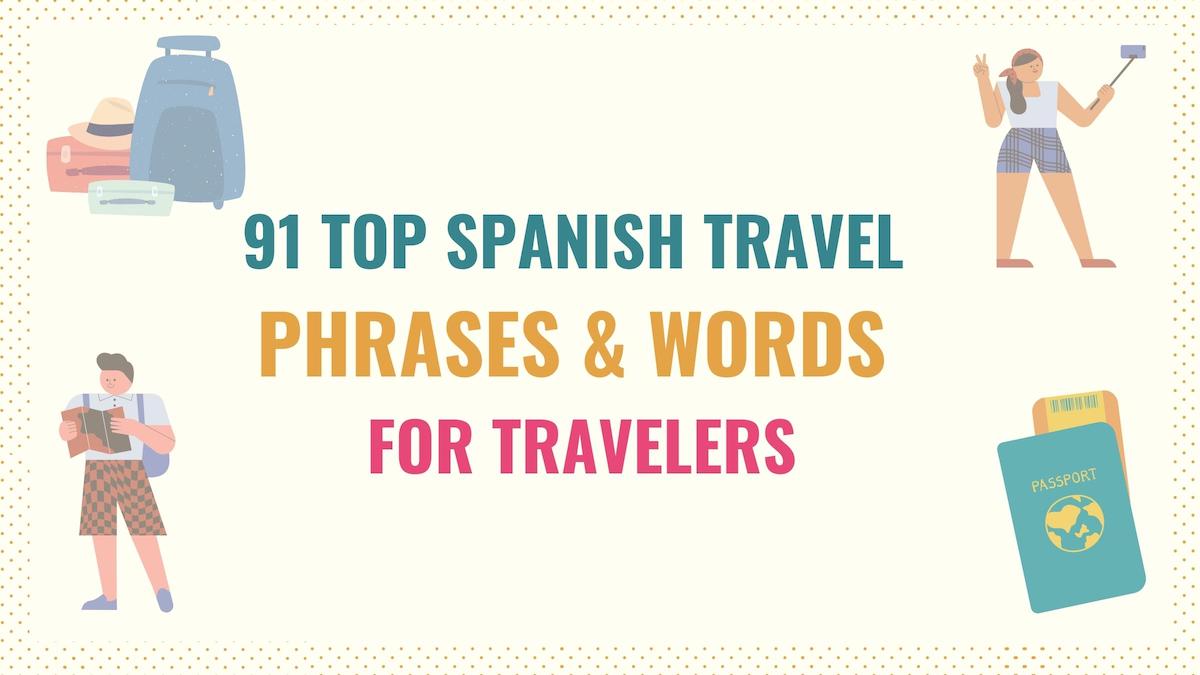
Are you planning a well-deserved vacation? Is your destination a Spanish-speaking country? If so, you may want to take the time to learn some essential Spanish travel phrases that can help you communicate.
There’s no doubt that English is a widely spoken language . But if you travel to a Spanish-speaking country, your chances of randomly finding someone who speaks enough English to help you aren’t that high. Trust me, I have seen enough confused tourists to know.
To avoid any communication issues, I’ve built a list of 91 crucial Spanish travel phrases that will help you get by on your vacation. Are you wondering how on earth you are supposed to pronounce them if you don’t speak Spanish? Fear not! I’ve also included the audio recordings to help you overcome this issue.
Here is a quick overview of the situations we’ll cover and the resources you’ll find in this guide:
- Common verbs for travel
- Phrases & Vocabulary for the Airport
- Phrases to Use in a Restaurant
- Phrases & Words to Ask for Directions
- Phrases to Use at a Hotel
- Downloadable PDF
Basic Spanish Travel Phrases, Questions & Words
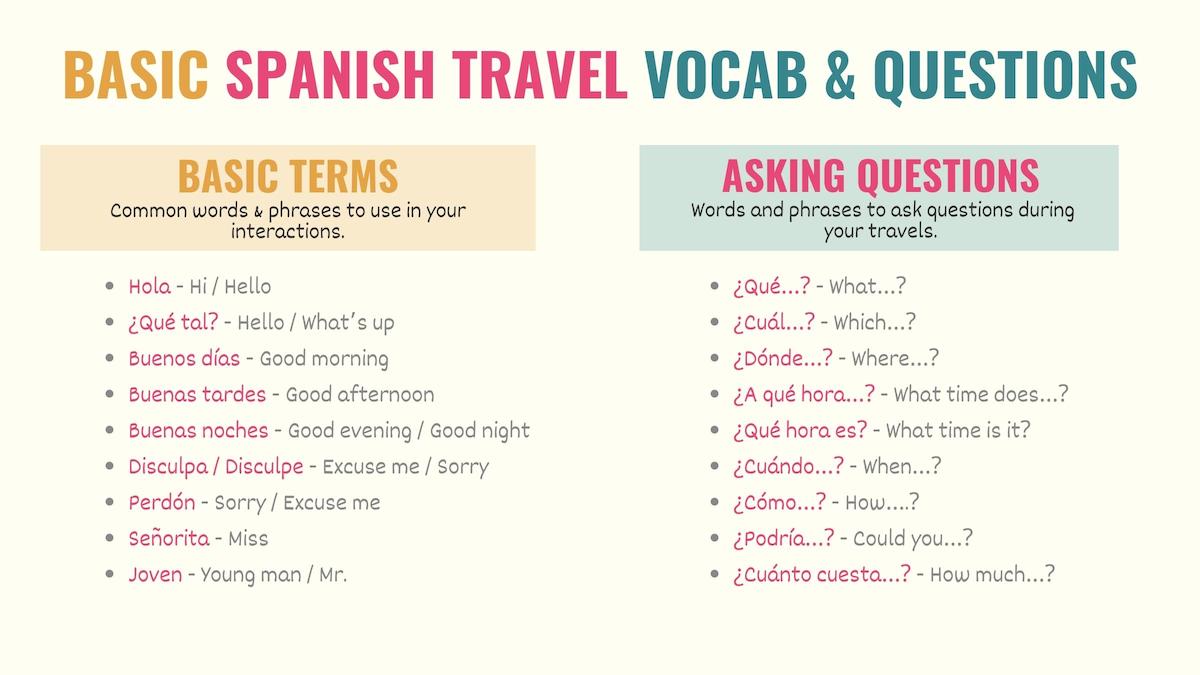
When it comes to Spanish vocabulary for travelers, there are some essential words that you’ll use more frequently or that can help you sound more polite when addressing a native speaker. Let’s start with some greetings and expressions to catch a person’s attention.
As you’ll see in the examples I’ve provided, these words are usually placed at the beginning of the sentence.
- Hola – Hi / Hello
- ¿Qué tal? – Hello / What’s up
- Buenos días – Good morning
- Buenas tardes – Good afternoon
- Buenas noches – Good evening / Good night
- Disculpa / Disculpe – Excuse me / Sorry
- Perdón – Sorry / Excuse me
- Señorita – Miss
- Joven – Young man / Mr.
The following question words and expressions can also be useful when you travel:
- ¿Qué…? – What…?
- ¿ Cuál …? – Which…?
- ¿Dónde…? – Where…?
- ¿ A qué hora …? – What time does…?
- ¿Qué hora es? – What time is it?
- ¿Cuándo…? – When…?
- ¿Cómo…? – How….?
- ¿Podría…? – Could you…?
- ¿Cuánto cuesta…? – How much…?
Hola , ¿ cuánto cuesta el llavero? Hi , how much is the keychain?
Disculpe , ¿ dónde está la catedral? Excuse me , where is the cathedral?
Señorita, ¿ podría darme otro formulario? Miss, could you give me another form?
Buenos días , ¿ a qué hora abre el museo? Good morning, what time does the museum open?
Basic Spanish verbs for traveling
Many simple Spanish travel phrases are built with the verbs querer , gustar and poder , which we use to make requests. These are the most common forms that you’ll need:
- Quiero … – I want…
- Quisiera … – I would like…
- Me gustaría … I would like…
- ¿Puede…? – Can you…?
- Tiene / Tengo … – Has / Have
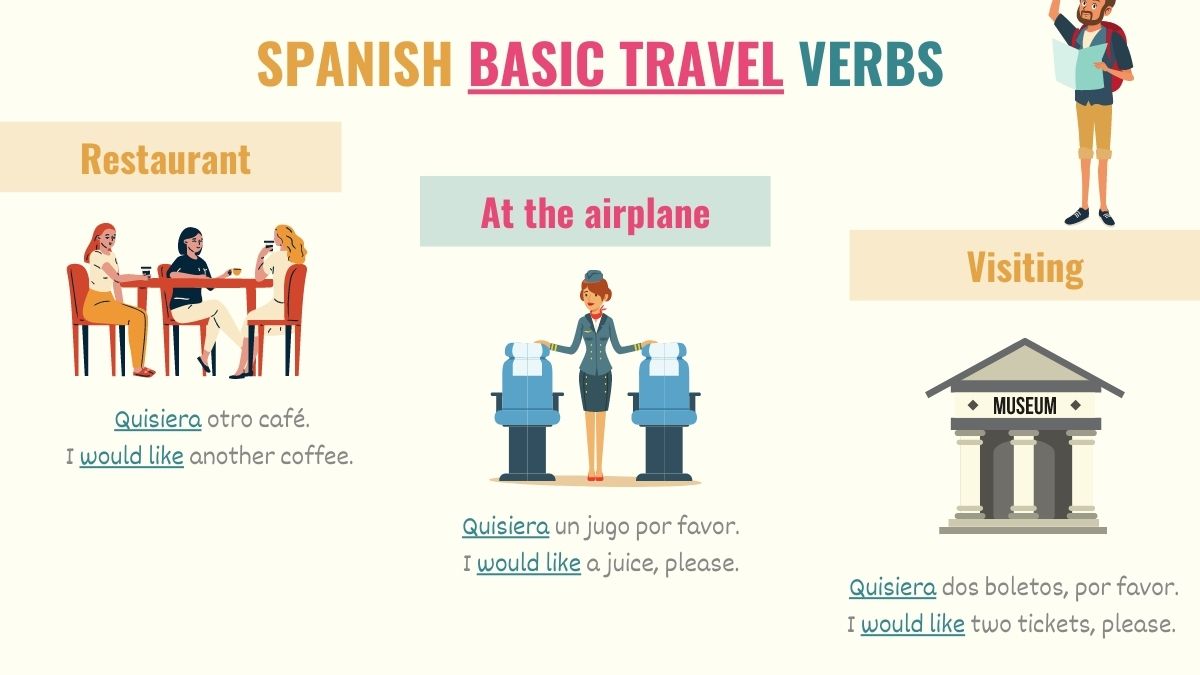
As you can imagine, these expressions are very versatile because they can be combined with different words for tourists:
Quiero dos boletos. I want two tickets.
No tengo cambio. I don’t have change.
Me gustaría una habitación con vistas al mar. I would like a room with an ocean view.
Quisiera visitar el museo de artes. I would like to visit the art museum.
¿ Puede decirme dónde está la parada? Can you tell me where the bus stop is?
Disculpe, ¿ podría ayudarme? Excuse me, could you help me?
Travel Phrases & Spanish Vocabulary for the Airport
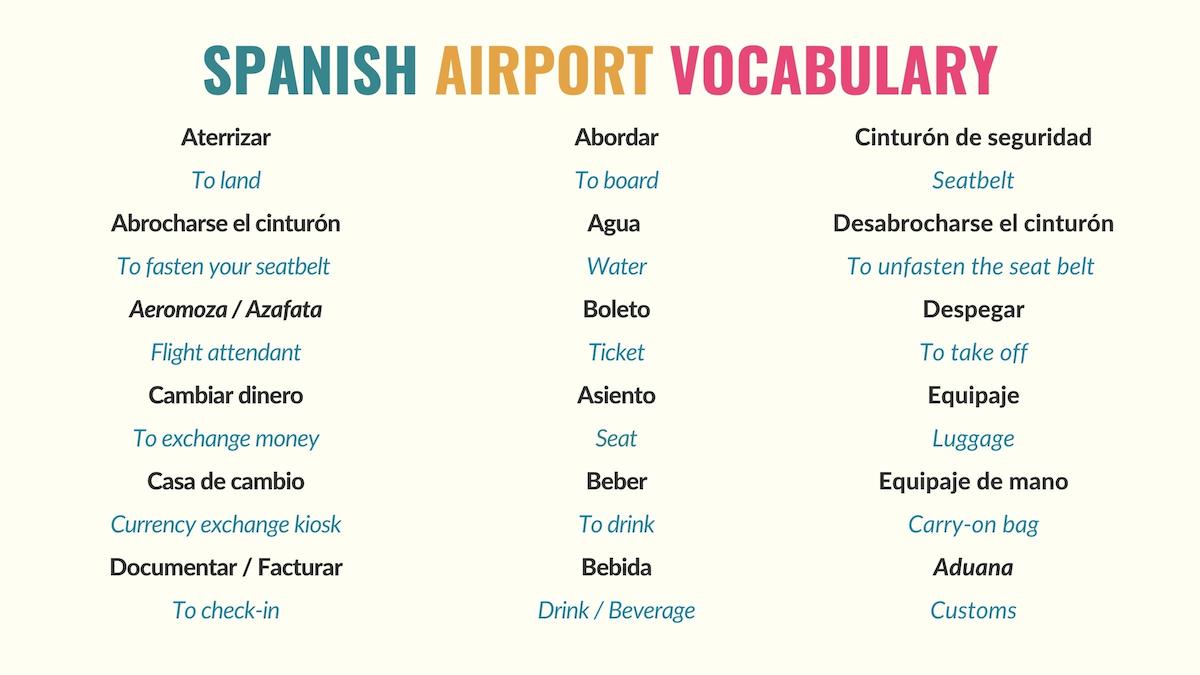
You’re likely to find more than one person who speaks English at the airport. However, this is an excellent opportunity to start practicing your Spanish. Here are some common phrases that you’re probably going to encounter or use while at the airport:
- ¿Va a documentar su maleta? – Are you going to check your bag?
- ¿Me permite su pasaporte? – Can I have your passport?
- Por favor, abroche su cinturón – Please, fasten your seatbelt
- ¿Desea algo de beber? – Would you like something to drink?
- Por favor, regrese a su asiento – Please, go back to your seat
- Llene este formulario, por favor – Please, fill in this form
- ¿Cuál es el motivo de su visita? – What’s the reason for your visit?
- ¿Dónde puedo cambiar dinero? – Where can I exchange money?
- ¿Dónde están los baños? – Where are the restrooms?
In addition to these phrases, here are some words that may be useful in this situation. Remember that you can combine the words below with the expressions and questions you learned in the previous section.
[Basic Spanish expression] + [airport vocabulary]
Quisiera un asiento en el pasillo . I would like an aisle seat .
Disculpe, ¿a qué hora aterrizamos ? Excuse me, what time do we land ?
¿Podría ayudarme? Mi equipaje está perdido . Could you help me? My luggage is missing .
¿Cuántas maletas va a documentar ? How many bags are you going to check ?
Buenos días, ¿tiene café ? Good morning, do you have coffee ?
Spanish Phrases for Tourists in a Restaurant
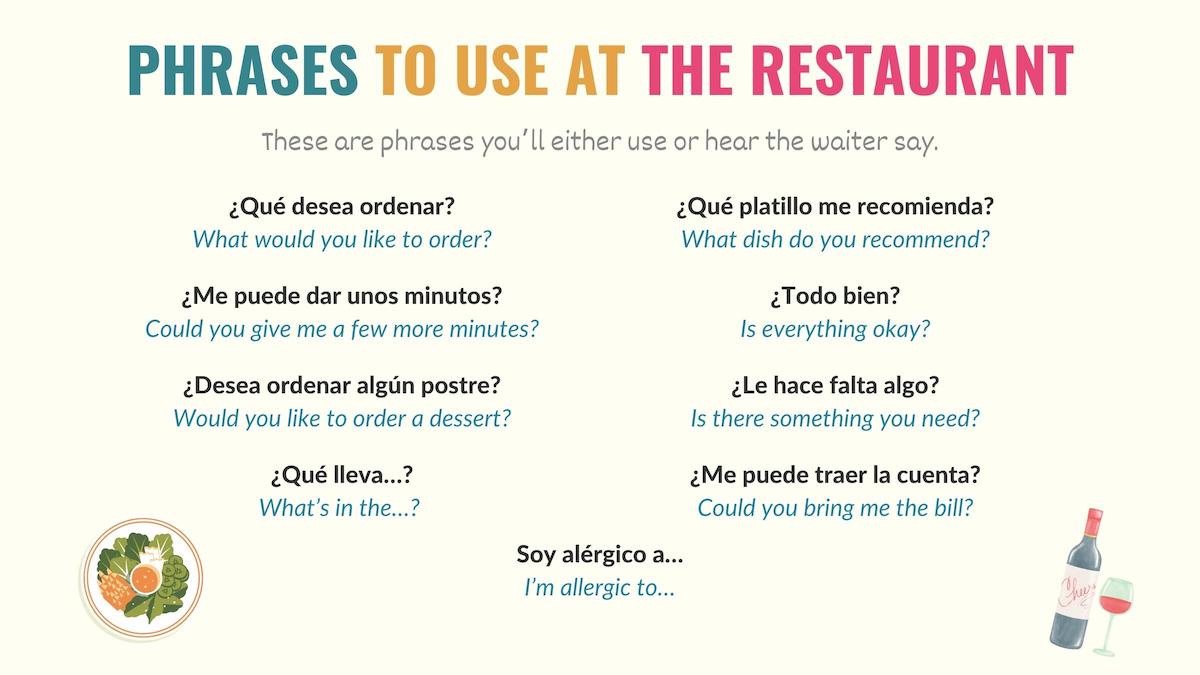
As a tourist, you’re probably going to spend some time trying different foods at restaurants. Here are some common phrases you can use and are likely to hear at a restaurant.
- ¿Qué desea ordenar? – What would you like to order?
- ¿Me puede dar unos minutos? – Could you give me a few more minutes?
- ¿Desea ordenar algún postre? – Would you like to order a dessert?
- ¿Qué lleva…? – What’s in the…?
- ¿Qué platillo me recomienda? – What dish do you recommend?
- ¿Todo bien? – Is everything okay?
- ¿Le hace falta algo? – Is there something you need?
- ¿Me puede traer la cuenta? – Could you bring me the bill?
- Soy alérgico a … – I’m allergic to…
Here are other terms that can be useful in this type of situations:
Joven, ¿cuál es la especialidad de la casa? Young man, what’s the specialty of the house?
Quisiera ordenar dos postres, por favor. I would like to order two desserts, please.
Disculpe, ¿qué platillo me recomienda? Excuse me, what dish would you recommend to me?
¿Me podría traer un cuchillo y un vaso de agua? Could you bring me a knife and a glass of water?
Take Note: If you want to learn more about this topic, I recommend you check this guide on ordering food in Spanish .
Spanish for Visiting the City & Asking for Directions
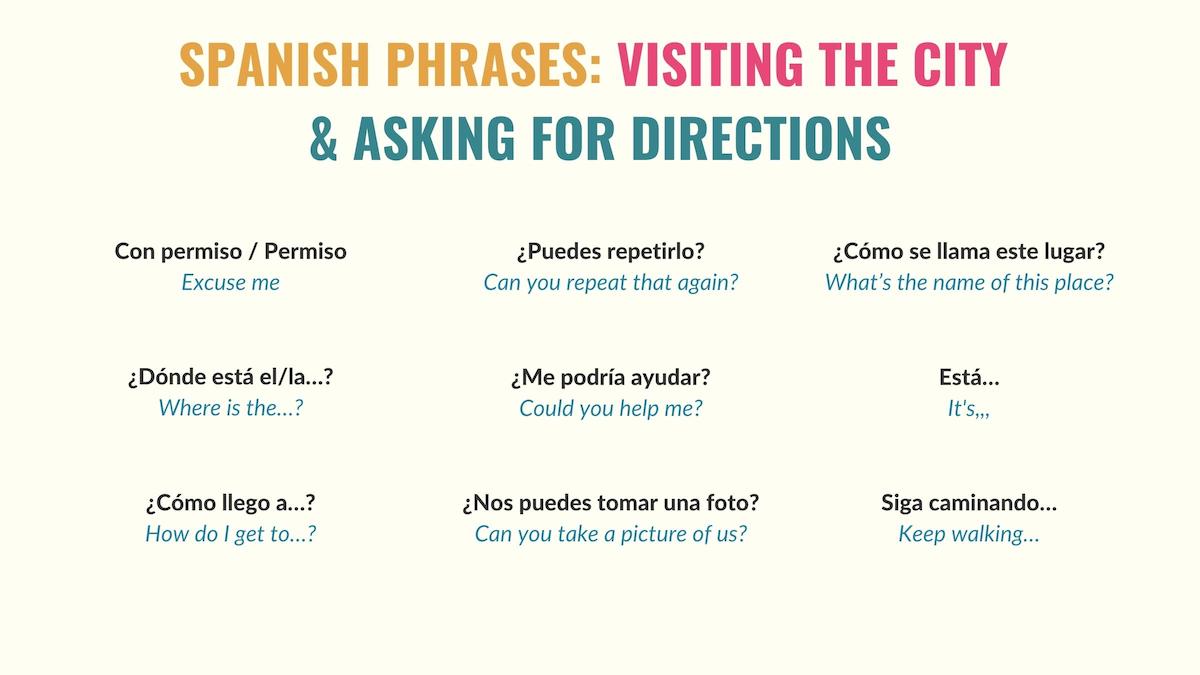
One of the biggest challenges you may face is communicating with native speakers when visiting the city or a tourist attraction. Here are some of the most common Spanish phrases for travel that you may need in this situation:
- Con permiso / Permiso – Excuse me
- ¿Dónde está el/la…? – Where is the…?
- ¿Cómo llego a…? – How do I get to…?
- Estoy buscando… – I’m looking for
- No hablo mucho español – I don’t speak Spanish very well
- ¿Hay algún/alguna… por aquí? – Is there…around here?
- ¿Hablas inglés? – Do you speak English?
- ¿ Puedes repetirlo? – Can you repeat that again?
- ¿Me podría ayudar? – Could you help me?
- ¿ Nos puedes tomar una foto? – Can you take a picture of us?
- ¿ Nos puedes tomar otra ? – Can you take another one of us?
- ¿ Dónde puedo tomar…? – Where can I take…?
- ¿Por aquí pasa el camión…? – Is this place on the bus route? / Does the bus come by here?
- ¿ Cómo se llama este lugar? – What’s the name of this place?
Take Note: Con permiso is a polite way to ask people to let you through. So, we use this phrase in crowded places or when walking on the street.
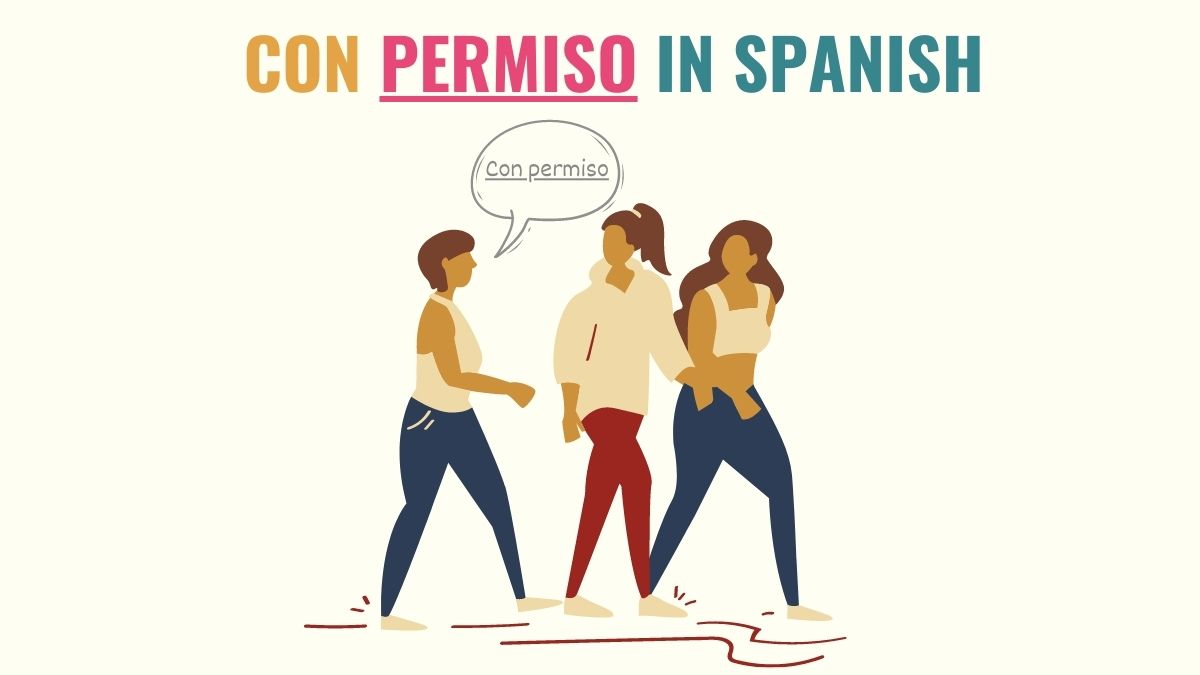
On the other hand, people are likely to give you the following answers:
- Está… – It’s…
- Siga caminando …- Keep walking…
- De vuelta a/en – Turn…
- Siga derecho – Go straight…
- Camine – Walk…
Additionally, here are some basic words that you can use or might hear when visiting the city:
Here are some examples of how to use these Spanish words and expressions:
Disculpe, ¿ dónde está la estación de tren? Excuse me, where is the train station?
Buenas tardes, estoy buscando el museo. Good afternoon, I’m looking for the museum.
Camine dos cuadras y dé vuelta a la izquierda. Walk two blocks and turn left.
Perdón, ¿ hay algún restaurante por aquí? Excuse me, is there a restaurant around here?
Hola, ¿ me podría ayudar ? Quiero ir al museo. Hi, could you help me ? I want to go to the museum.
Spanish Phrases for Hotels & Accommodations
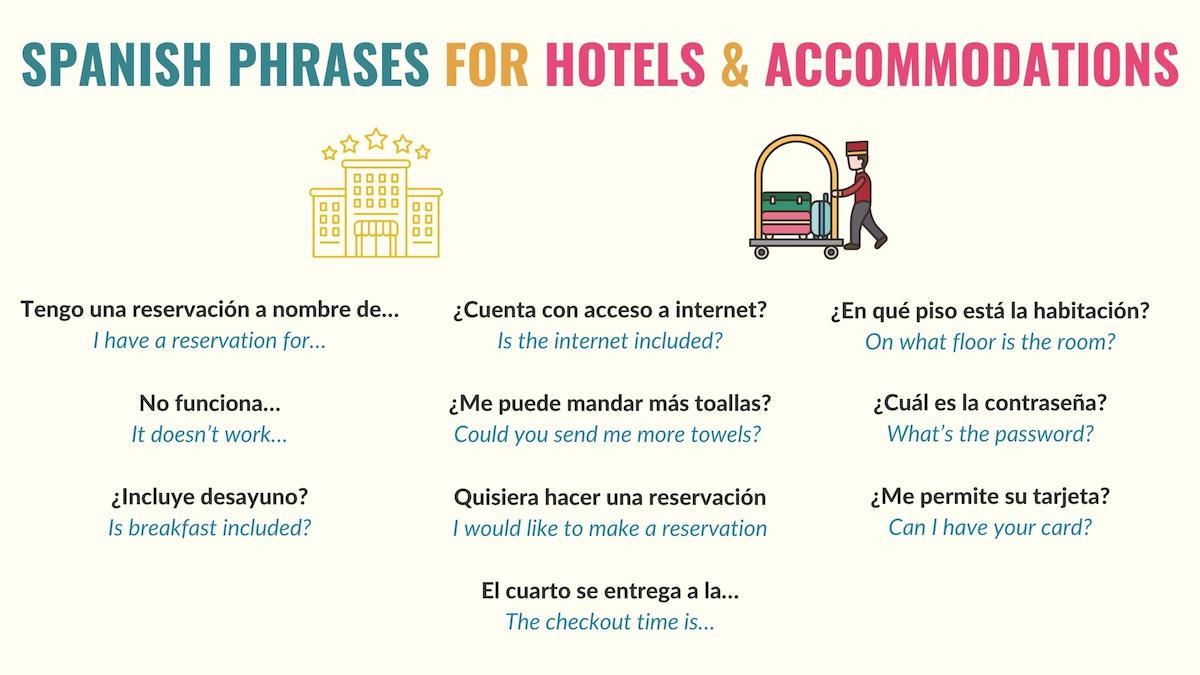
Although nowadays it’s easier to make reservations before your trip, there may be some situations where you need to speak Spanish to communicate with staff and others in your hotel. Here are some essential phrases applicable to this context:
- Tengo una reservación a nombre de … – I have a reservation for…
- Quisiera hacer una reservación – I would like to make a reservation.
- No funciona … – It doesn’t work…
- ¿Me puede mandar más toallas? – Could you send me more towels?
- ¿Incluye desayuno? – Is breakfast included?
- ¿ Cuenta con acceso a internet? – Is the internet included?
- ¿Cuál es la contraseña? – What’s the password?
- ¿En qué piso está la habitación? – On what floor is the room?
- ¿Me permite su tarjeta? – Can I have your card?
- El cuarto se entrega a la … – The checkout time is…
As for vocabulary, these are some of the words that you may want to keep in mind:
Señorita, ¿dónde está el elevador ? Miss, where is the elevator ?
Buenos días, la regadera no funciona . Good morning, the shower doesn’t work .
¿A qué hora termina el servicio a la habitación ? What time does room service end?
Spanish Expressions for Souvenir Shopping
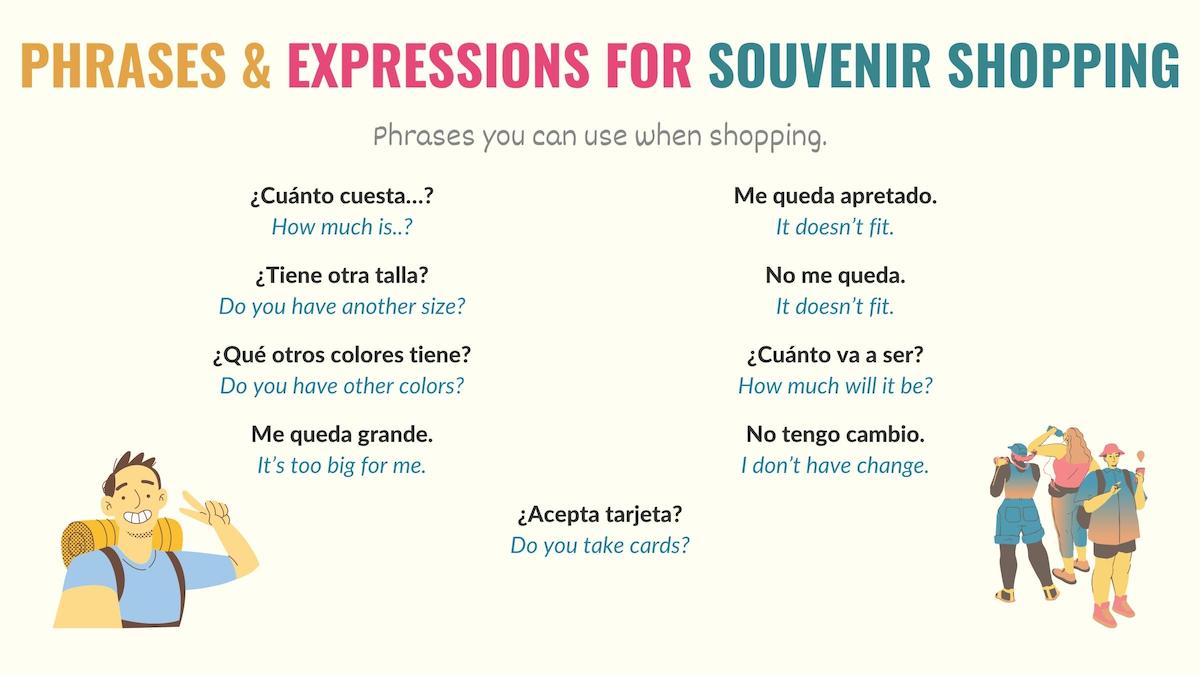
Even if you’re not a big spender, it’s likely that at some point you may want to do some shopping. These are the key expressions that you need in this situation:
- ¿Cuánto cuesta…? – How much is..?
- ¿ Tiene otra talla? – Do you have another size?
- ¿Qué otros colores tiene? – Do you have other colors?
- Me queda grande – It’s too big for me.
- Me queda apretado – It doesn’t fit.
- No me queda – It doesn’t fit.
- ¿Cuánto va a ser? – How much will it be?
- No tengo cambio – I don’t have change.
- ¿Acepta tarjeta? – Do you take cards?
On the other hand, these are some of the expressions that the clerk may use with you:
- ¿En qué le puedo ayudar? – How can I help you?
- Pregunte/Vea sin compromiso – You can ask/see, without any obligation.
- ¿Buscaba algo en especial? – Are you looking for anything in particular?
- ¿En qué talla? – What size?
- ¿Cómo le quedó? – How does it fit?
- ¿Buscaba algún color en especial? – Were you looking for a particular color?
- ¿Quiere que le muestre algo? – Would you like me to show you something?
- Es el último que me queda – It’s the last one.
- ¿Tiene un billete más pequeño? – Do you have a smaller bill?
- ¿Qué tamaño buscaba? – What size were you looking for?
- Aquí tiene – Here you go.
As for vocabulary, here are some common objects that you may find during your trip:

Check the examples below. Notice that you can combine this specific vocabulary with the basic words and questions you learned at the beginning of this article.
¿Tiene dulces típicos ? Do you have traditional candies ?
¿Podría darme tres llaveros ? Can you give me three keychains ?
Final Points: Spanish for Travelers
Many tourists visiting Spanish-speaking countries face communication difficulties. Let’s face it, there might be some people that speak English and will be able to help you. But chances are that, at some point, you’ll need to use some Spanish. When in Rome, do as the Romans do, right?
To help you with this, I’ve prepared this guide for tourists with basic expressions, questions and words that you’ll use in most traveling situations. Just remember that:
- Many of these travel phrases are built with ‘ querer’, ‘gustar’, ‘poder’ and ‘tener’ .
- Questioning words can take you pretty far if you combine them with the appropriate vocabulary.
- You use greetings and words to address people to sound more polite.
Hopefully, this guide will help you keep basic conversations. ¡Buena suerte and (disfruta) enjoy your vacation!
Spanish Resources for Tourists & Travelers
To make your trip as enjoyable as possible and get the most out of speaking Spanish, I recommend checking out the free resources below. Here’s my pro tip: Quickly read them and write down a “script” of the most common Spanish phrases, words and expression you’ll need to use while you travel.
Download the PDF with Spanish Phrases & Vocabulary for Traveling
Learning Spanish can be an incredible experience. But it can also be challenging at times, especially when you’re visiting a new place. I’ve created a free PDF for this guide which you can download with the key Spanish phrases, expressions and words you need to start speaking the language while still enjoying your vacation.
Related Guides & Spanish Vocabulary
If you’re traveling to Mexico or another Latin American, Spanish-speaking country then this guide will show you all the vocabulary and phrases you need to interact and order your food at a restaurant .
One of the best ways to get ready for a day of speaking a foreign language is by achieving an easy win as soon as possible at the start of the day. Here are different expressions that native speakers use to say ‘good morning’ in Spanish , which is easy to incorporate into your conversations as well as common Spanish greetings and farewells .
How to Ask for & Reserve a Hotel Room in Spanish : In this article you’ll find different questions and phrases that you and the hotel staff are likely to use when booking a hotel room.
Daniela Sanchez
¡Hola! Soy Daniela Sanchez, I've been studying Spanish professionally as well as teaching it in Mexico and online for over 10 years. I’ve taught Spanish to a wide array of foreigners from many backgrounds. Over the years, I've made it my mission to work hard on refining many challenging to understand grammar topics to make my students' learning experiences easier, faster and more enjoyable. Read More About Me
Recent Posts
Cuál vs Qué: Key Differences You Need to Know
Cuál vs qué is a topic that often confuses Spanish learners. Qué inquires about definitions, time, explanations, or identifies something. It’s the direct translation of ‘what’. Cuál means...
Salir vs Dejar vs Irse: Key Usage Differences
Salir vs dejar vs irse confuse learners because they all mean ‘to leave’, but aren’t interchangeable. Irse conveys and emphasizes that someone is leaving a place. Dejar expresses that someone...
Pin It on Pinterest

Essential Spanish Phrases for Mexico Travel eBook
Want to learn the essential spanish phrases for mexico travel.
Are you planning a trip to Mexico, but don’t know any Spanish? Or you want to learn the essential Spanish phrases for Mexico but are short on time?
Don’t worry—I’ve got the perfect solution to help you prepare for your trip!
My new eBook, “ Speak Like a Local: Essential Spanish Phrases for Traveling in Mexico ,” is sure to get you speaking like a local in no time.
As a travel blogger that has lived in Mexico for more than 5 years, I’ve compiled all the Spanish phrases you need to know for your Mexican vacation into a handy eBook and quick reference guide .
From basic phrases and greetings to dining, shopping, and navigating transportation, this beautifully-designed eBook has all of the basic Spanish for travel to Mexico !
And it’s super affordable so it will get you ready for trip to Mexico without breaking the bank!
Normal Price: $9.99 Get it today for only $7.99!

Does This Sound Like You?
- You’re planning a trip to Mexico but don’t know a word of Spanish
- You remember some basic high school Spanish, but aren’t confident enough to use it
- You want to learn Spanish for your trip, but have limited time
- You want to learn the local slang and some helpful phrases for your visit
- You’re worried about having trouble communicating during your trip
- You feel embarrassed that you don’t know any Spanish
- You’re feeling overwhelmed about learning Spanish and don’t know where to start
- You’re afraid you might get taken advantage of because you don’t know the language
If any of these statements sound familiar, this eBook is the perfect resource for you!
It covers all the essential Spanish phrases you need to know for traveling Mexico, from basic greetings and introductions to dining at a restaurant and understanding Mexican slang.
Who Can Benefit from the Spanish Phrases for Mexico eBook?
Designed with the traveler in mind, “ Speak Like a Local: Essential Spanish Phrases for Traveling in Mexico ” is your pocket-sized companion whether you’re a first-time explorer or a frequent visitor to Mexico.
It’s perfect for people who are short on time and want to quickly learn all the basics of Spanish for travel to Mexico.
Ideal for beginners, travelers, and those who want to dive deeper into the Mexican culture, this eBook will help you easily understand the local culture and confidently navigate your way around Mexico.
What You’ll Learn from the Spanish Phrases for Mexico eBook
“ Speak Like a Local: Essential Spanish Phrases for Traveling in Mexico ” is packed with practical information, all aimed at making your trip to Mexico as safe and as trouble-free as possible.
The eBook is divided into various sections, each walking you through different situations and conversations you might encounter while traveling.
Here are the key benefits of purchasing the eBook:
❗️Now, to be clear, this eBook isn’t going to make you fluent in Spanish or teach complex grammar rules —but rather equip you with the basic travel Spanish you need to travel and navigate your way around Mexico.
Who Am I? And How Can I Help You?
I’m Allison, a Playa del Carmen -based travel blogger who has been living in Mexico for more than 5 years. My personal Spanish journey includes mastering Spanish throughout high school and college, courses, and real-life experiences.
Gathering all my insights, I’ve crafted this eBook that’s your ultimate insider’s guide to common Spanish phrases for travel to Mexico. It’s a compilation of easy Spanish phrases I use on a daily basis and have picked up during my extensive travels throughout Mexico.

What’s Inside the Spanish Phrases for Travel to Mexico eBook?

This 20+ page eBook covers everything from basic phrases and numbers to sections for checking into a hotel, dining at a restaurant, or asking for help. Here’s exactly what you’ll find inside:
Basic Phrases
Start with the basics and build a strong foundation. This section covers basic Mexican Spanish phrases and introductions like hello, goodbye, please/thank you, and excuse me.
Get comfortable counting in Spanish with basic Mexican words and numbers. From one to 20 (and larger denominations), this is your guide to understanding the Spanish language of numbers.
Meeting People
Learn how to make new friends and start conversations with locals. In this section, you’ll learn social etiquette, and how to introduce yourself and exchange contact information.
Checking into a Hotel
Learn the basics on checking into a hotel in Spanish, including interactions at the Front Desk, as well as asking about amenities and common housekeeping requests.
Basic Food & Drinks
Learn the different food and drinks you’ll see on menus throughout Mexico. From fruits and beverages to main courses and seafood, this section covers Mexican food basics.
Dining at a Restaurant
Learn phrases for arriving at a restaurant, understanding menu items, asking for recommendations, ordering food, communicating allergies and dietary requests, asking for the check, and more.
Money & Banking
Learn common money and banking terminology when it comes to ATM, credit cards, and cash exchanges.
From bargaining techniques for souvenir shopping to talking about sizes and preferences, this section covers all of the essential Spanish phrases for shopping in Mexico.
Taxis & Transportation
Learn the basic Spanish words and phrases for navigating transportation. From asking for directions to understanding public transport and going to the airport, you’ll be able to get where you need to go with ease.
Asking for Help
Learn how to ask for help in Spanish, including common questions, expressions for confusion, and asking for directions.
Emergencies
This section will help you get familiar with common phrases and expressions for medical, police, and other emergencies.
Mexican Slang
The locals will be impressed when you know the best Mexican slang! This section includes phrases for everyday conversations, plus some fun (and inappropriate! 🙊) phrases to help you fit in with the locals.
Mexican Destinations
Make your way around Mexico confidently and learn how to pronounce odd-looking destination names like Oaxaca, Hualtulco, Zihuatanejo, Holbox, and more.
BONUS: Xcaret Park Names
This bonus section includes a pronunciation guide for the Xcaret parks in Riviera Maya, which all start with an “X” and can be tricky to pronounce.
But What About Pronunciation?
Worried about not being able to pronounce these basic Spanish phrases for travel correctly? Don’t be!
Each word or phrase in the eBook includes very easy to follow phonetic pronunciations so you won’t need to be a master linguist to be able to say it right.
Try it for yourself:
🗣 Good morning! – ¡Buenos días! (BWAY-nos DEE-as)
Easy, right!? These Spanish phrases for Mexico with pronunciation guides will have you speaking Spanish like a local in no time!
Mexico Spanish Phrases eBook: FAQs
I want to make sure this Spanish for Mexico eBook is the perfect resource for you–so here’s a quick list of FAQs to help answer any questions you may have:
No. This eBook is designed to be a quick reference guide of all the essential Mexican phrases for tourists, but it won’t cover complex grammar rules.
“ Speak Like a Local: Essential Spanish Phrases for Traveling to Mexico ” is 22 pages long.
This eBook is perfect for beginners who want to learn the basics and get familiar with essential Spanish travel phrases. You don’t need to know any Spanish to benefit from this eBook.
Yes, you can find some of this information online for free. But my eBook is designed to be a a pocket guide so it saves you time by bringing everything together in one place! Plus, you’ll benefit from my expertise as I’ve included the essential phrases and words that you really need to know for travel to Mexico.
No, due to the digital nature of this product, all sales are final and non-refundable.
Once you purchase the Mexican Spanish Phrases PDF eBook, you’ll receive an email with a link to the PDF file that you can download and access on any device.
No, you don’t need an internet connection to access or use the eBook. You just need to download it once and can then access it anytime without an internet connection.
Ready To Speak Like a Local?
Ready to speak Spanish confidently and be able to navigate your way around Mexico with ease?
“ Speak Like a Local: Essential Spanish Phrases for Traveling in Mexico ” is the perfect pocket guide to help you get started!
Don’t miss this easy and affordable chance to learn the basics of Mexican Spanish today. Get your copy now!
Matador Original Series
14 essential sayings travelers to mexico need to know.

M exican Spanish is very different from the versions of the language spoken in other hispanic countries like Spain, Chile, Costa Rica, etc. We have our own slang and funny expressions that you’re unlikely to find anywhere else. So, whether you’re planning an epic trip through Mexico , want to impress your Mexican friends at home, or an expat in Mexico city who wants to blend in a little better with the locals, this quick introduction to 14 common Mexican Spanish sayings should help you achieve your goal in no time at all!
1. ¿Mande?
“Don’t say ‘what’, say ‘mande’” is one of those classic things Mexican moms tell their kids. Even if we’ve never really understood what’s wrong with asking “what” (“qué” in Spanish), this recurring instruction has stuck with us, and we commonly use “mande” as a polite Mexican Spanish version of the aforementioned word.
So remember, when you think your waiter is asking what type of wine you want with your contemporary Mexican dinner, but you didn’t quite catch what he said, don’t say “¿qué?,” say “¿mande?”
2. ¿Bueno?
Bueno is the first word you’ll hear whenever you make a phone call to anyone in Mexico. It isn’t really a salutation, more just a random word (bueno literally means “good”) we use at the beginning of every call. Only the person receiving the call will say it, and only once. If you answer back with another bueno, things will go all weird. Go ahead and try it!
So when you’re calling to book a bed in that cute little hostel in downtown San Miguel de Allende , and you hear a bueno from the receptionist, you’ll know exactly what to make of that.
A time-based Mexican Spanish expression that depends entirely on the context and the speaker, ahorita is supposed to express immediacy, but we tend to use it as a temporal wildcard that could be referring to any amount of time between the next few seconds and the next few…let’s say minutes.
It’s a good one to throw at your travel partner when he impatiently asks when you’ll be ready to go out and hit the bars in Mexico City …and you haven’t even taken a shower yet!
4. ¡Aguas!
Our short, simple, and effective Mexican Spanish way to say “be careful.” We use it in situations where immediate action and quick reflexes are required, like when you’re about to step in dog poop, or when you cross the street thinking those cars are going to stop simply because you’re using a crosswalk.
Don’t get confused if your waiter says “aguas” when handing you a delicious, steaming hot café de olla on a chilly morning in the mountain city of Taxco. They have not brought you the wrong beverage (aguas literally translates to “water”) — she’s just trying to save you from burning your tongue.
5. Órale
This Mexican Spanish saying is a tricky one. It’s normally used to express agreement, but depending on the tone and context it can also mean “hurry up,” “that’s amazing,” “let’s go,” “I wasn’t expecting that,” “it’s alright,” “come on,” “please,” “sounds like a plan,” “watch it,” or simply “yes.” Practice makes perfect, but remember we also abbreviate this expression to ora, which is also an abbreviation of ahora (“now”), and that there’s always ándale…which is mostly the same, but a little different.
Ready to run up the steps of Teotihuacán ‘s Pyramid of the Sun? Órale!
6. Güey
If your Mexican buddies start calling you güey, that’s probably a good sign. It means they consider you a friend, and you can refer to them in the same way. This is another confusing term that most of the time can be interpreted as “dude,” but can also mean “some guy” (un güey), “your boyfriend” (tu güey), or “you’re really stupid” (estás bien güey). Be careful not to confuse “estás bien güey” with “¿estás bien, güey?” (“are you alright, dude?”).
In Northern Mexico, güey is normally replaced with vato (“dude”), primo (“cousin”), or compa (for the sake of simplicity, let’s just say this one means “dude” again).
A short version of con permiso (“excuse me”) that’s used exclusively to make your presence known to the people around you while you maneuver through tight spaces, comper is especially useful at festivals and markets where phrases like comper, ahí va el diablo (“excuse me, the devil’s coming through”) are ubiquitous.
El diablo in this context is not the Lord of Darkness, but the dolly used to transport goods in Mexican markets. And there are a lot of incredible markets in Mexico.
8. Provecho / provechito
Some people translate this common Mexican saying as “Enjoy your meal,” but this doesn’t seem completely accurate. Provecho is a strange greeting we use to acknowledge people who are about to eat, are already eating, or have just finished their meal. It’s not uncommon to say provecho to complete strangers, especially to every complete stranger you make eye contact with on your way out of that restaurant in Oaxaca where you just ate the best mole poblano of your life.
Provechito is just a cute way of saying provecho.
9. ¿Qué onda?
One of our favourite Mexican Spanish greetings, qué onda (literally “what a wave”) is the exact equivalent of “What’s up?” The wave can easily be substituted by a fart (qué pedo), a fraud (qué transa), a mushroom (qué hongo), or a roll (qué rollo) without altering its meaning.
10. Chido / chilo / chingón
These Mexican Spanish phrases are easy ones. They all express that something’s good. Simple as that. Chingón is the best of the three, but it denotes so much awesomeness that some people consider it extremely rude. Chido and chilo are the mild and socially acceptable versions, but still pretty awesome. Chido is used in Central Mexico, while chilo is mostly used in the northern states and is pronounced “shilo.”
11. Bien padre
Padre means “cool” (as well as “father,” obviously). If you want to say that something’s really cool, you can say está bien padre (“this is really father”) or está padrísimo (“this is super father”). Some other expressions used to say that something’s cool include está de pelos (“this is hairy”) and está con madre (“this is with mother”).
12. Cámara
Literally meaning “camera” or “chamber,” this is a common Mexican Spanish term is used to show agreement. More adventurous speakers can substitute it for camarón (“shrimp”). As in: “We should hit the beach at Playa del Carmen after we check out the Maya ruins in Tulum. Camarón!”
13. El mal del puerco
“The evil of pork” is the common state of drowsiness that overtakes your body after a copious meal. The evilness resides in its ability to dominate a person’s will completely, forcing its victims to take a nap, or coyotito (“a little coyote”), despite previous plans.
14. ¡Gracias!
A version of this article was previously published on October 21, 2015, and was updated on February 25, 2022.
More like this
Trending now, 13 la condesa airbnbs to settle into mexico city’s coolest neighborhood, you could be fined for bringing too many electronic devices into this country, 10 countries where you can take a 20-day vacation for cheap, in buzzy playa del carmen, mexico, this resort stands out for wellness, the 30 beaches with the whitest sand in the world, proven by color analysis theory, discover matador, adventure travel, train travel, national parks, beaches and islands, ski and snow.
We use cookies for analytics tracking and advertising from our partners.
For more information read our privacy policy .
- First Time Visiting Isla Mujeres?
- Isla 101 – The Essentials
- How to get to Isla Mujeres
- The Beaches of Isla
- Traveling with Kids?
- Day Trip Guide to Isla Mujeres
- The Seasons of the Island
- History, Legends & Lore
- Get Married in Paradise
- Own a Slice of Paradise
- Foodie Bliss: Restaurant Listings
- Town Eateries
- Island Eateries
- Eat Like a Local
- Sweet Dreams: Accommodation Listings
- Resorts and Hotels
- Vacation Rentals and B&Bs
- What to do ~ An Overview
- Adventures: Activity Listings
- Fun in the Water
- Fun on the Land
- Sites to See
- Spa and Wellness
Off Island Tours & Trips
- Lifelines: Service Listings
- Cancun Airport Guide
- Travel Tips
- Isla Mujeres Web Gems
- At your Service
- The Weather
- Handy & Essential Contacts
- Travel Spanish
29 Isla Mujeres FAQs
- Isla’s Events
- Blogs & Guides
- Best of Isla Mujeres
- Jump Back Home
- The Beaches of Isla Mujeres
- Day Trippers Guide to Isla
- Lifelines: Isla Service Listings
- Convenience at your Service
- Isla’s Events – Celebrate with Us!
- Blogs and Guides
- The Best of Isla Mujeres
Hola, Isla! Your Essential Spanish Guide
No hablas español no problemo.
The majority of islanders you’ll encounter speak at least some English. Hotel reception, tour operators, waiters and bartenders in the touristy places on Isla Mujeres are usually fluent. But once you get off the beaten track, the “English” becomes more “Spanglish” so leaning a few phrases will help, plus it’s a whole lot of fun!
Handy Translation Apps Download Google Translate app for your phone and be sure to download Spanish so you can get translations offline. You can translate signs using the camera, translate bilingual conversations on the fly – a little awkward but it works and of course just by typing or speaking English to get the Spanish translation. Free and easy to use and if you sign into your google account you can save translated words and phrases for future reference.
There are loads of other apps available and for iPhone users Apple has a built-in translator app available on iOS 14 or higher. Supports real-time conversation, text, and speech translation
But since you’re already here – take this opportunity to learn a few basic phrases. And remember, even a ‘hola’ or ‘gracias’ goes a long way. It’s like smile – easy to give, always appreciated and best of all, a bridge to new friendships!
The Local Lingo Snapshot
Greetings & Goodbyes
Basic Words & Phrases
Questions & Statements
Exclamations
A Word About Gender Nouns
Greetings & Goodbyes
Basic words & phrases, questions & statements.
Always ask before you get into a taxi
Exclamations!
Dive into isla magic.

Casa de las Palmas

Ixchel Beach Hotel

IZLA Beachfront Hotel

La Cazuela M&J
A word about gender nouns.
In traditional Spanish, many words have a gender. Words ending in ‘o’ are usually masculine, while those ending in ‘a’ are feminine. While north of the border carefully navigates the world of pronouns, Spanish nouns are confidently flaunting their gender. In Spanish, a friend is not just a friend. Depending on who you’re talking about, it could be ‘amigo’ (masculine) confidently strutting its ‘o’, or ‘amiga’ (feminine), gracefully embracing its ‘a’.
That said, there is a growing awareness and movement towards gender neutrality in the Spanish language. In its simplest form, just replace the ‘o’ or ‘a’ with an ‘e’ or an ‘x’. Sure, most will think you’re just giving the words a new twist, but hey, it’s always good for a chuckle. 🌈🇲🇽

Start your day with delectable and unforgettable flavors—an Isla Mujeres breakfast tradition unlike any other!
Your beachfront escape, where sunsets have a love affair with luxury. Perfect for families, fun, and those unforgettable ‘wish you were here’ moments!
Gorgeous and comfortable rooms with beautiful Playa Norte right outside your door, perfect for relaxing, romance or family fun.
A private slice of paradise where the sun rises on your perfect vacation and sets on fun, comfort and unforgettable memories.
Explore Our Directories

Sweet Dreams
Looking for the perfect place to drop your bags?

Foodie Bliss
Eating your way around the Island

Isla Activities: Sun, Fun, and Unforgettable!

Celebrations
Isla Traditions, Festivals and Cultural Events

Isla's Services: From Welcome to Wow!
Exceptionally Practical

Isla Mujeres Travel Tips

Eat like a Local
Careful when wishing someone Feliz Año Nuevo (Happy New Year). If you mispronounce “Año” (ah-nyo) and say “Ano” (ah-no), you’re actually saying Happy New Anus!
101 Common Spanish Phrases for Travel
It’s time to travel! Are you going to a Spanish speaking country? These 101 common Spanish phrases for Travel will help your trip go smoothly, and your journey will be much more enjoyable. If you can memorize these phrases before your trip, that’ll be ideal.
But let’s face it, you are busy. Most likely, you’ll be even busier as your departure date gets closer. But don’t worry, I have created this common Spanish phrases for travel pdf for you! It contains all the travel phrases and words that appear in this post.
Sign up to get your copy of our common Spanish travel phrases pdf for free!
Get Your Free Copy of the Survival Spanish Phrases for Travel!
Signup to receive our freebies and newsletter!
You have successfully joined our subscriber list. Please check your email.
101 Common Travel Phrases in Spanish PDF
Be sure to download it right now so you’ll have it on your cell phone, tablet, or laptop when you are abroad. It’s always a good idea to have it saved on your device, just in case you don’t have access to the Internet when you need it. You can sign up below to get a link to download the basic common Spanish phrases for the travel pdf file sent to you.
As an Amazon Associate, I earn from qualifying purchases. See our disclosure here .
What are the Common Spanish Phrases for Travel?
Here, we’ll cover 101 common Spanish phrases for travel that you will definitely want to know.
First, let’s start with basic greetings and pleasantries, and move on to some of the very common and super useful Spanish verbs. Then we’ll talk about some Spanish travel phrases for getting around and shopping.
Also, you’ll learn common Spanish phrases and words you will need at restaurants or hotels, and tourist activities.
Lastly, we finish up with the important Spanish phrases for emergencies, just in case. So, let’s begin!
What are the Spanish words for travel?
First, what are the words for travel in Spanish? Below are the words that mean travel or a trip.
To travel – Viajar
To go on a trip – Ir de viaje
A trip – un viaje
Basic Spanish Phrases for Travel: Greetings and Pleasantries
When you are traveling to a Spanish-speaking country, learning some basic Spanish phrases goes a long way. Even if you don’t pronounce them correctly or make mistakes, most people would appreciate the time and effort you put into learning their language. So let’s start with some very basic Spanish phrases for travelers.
Hi – Hola
You can use this any time of the day as it means “Hi” or “Hello”, but people usually say this and then say one of the other greeting phrases below depending on the time of the day. So, for example, you might say, “Hola, Buenos días.”
Good morning
Buenos días
This is normally used in the morning hours before 12 noon.
Good afternoon
Buenas tardes
Then you would switch to “ buenas tardes ” in the afternoon until it gets dark outside.
Buenas noches
People would start saying “buenas noches” when it’s dark outside…maybe around 6pm-ish.
Good Bye – Adiós
A typical goodbye in any Spanish-speaking country in the world.
See you later.
Hasta luego.
Even though you may not be seeing each other for a long time or ever like a store clerk, it is common to say “hasta luego ” especially in Spain.
Excuse me (Can I have your attention?) / (Can I pass by?)
Discúlpe / Con permiso
So “ Discúlpe” is used to get someone’s attention. “ Con permiso ” basically means “with your permission.” You would say this when you walk in front of someone or need to pass by people in a crowded place because they are blocking your way. It’s like saying, “Excuse me, I’m passing by you.”
It’s always polite and good etiquette to say “please” in any country, right?
Don’t forget to show your gratitude and appreciation when someone did something nice for you.
No thank you
If you are not interested, you can politely decline by saying, “no gracias.”
What is your name? – ¿ C ó mo se llama usted?
This is a formal version and an informal version is “ ¿C ómo te llamas?” In Mexico or Latin America, it would be better to use the formal version. In Spain, the informal version is pretty common unless you are speaking to someone who is much older than you or a government official, doctor, police officer, etc., you get the idea. A general rule of thumb is if your conversation partner looks about your age or younger, then it’s safe to use the informal version.
My name is ________. – Me llamo ______.
This means literally, “I call myself _______.” You can also say “Soy + your name.”
Nice to meet you. – Mucho gusto (Mexico), Encantado/a (Spain)
In most Latin American countries, “mucho gusto” is the most common way to say “nice to meet you.” In Spain, if you are female, you would say “encantada” ; and if you are male, you would say “encantado.”
How are you? – ¿ C ó mo est á usted?
This is a formal way to ask how a person is. If you are talking to a friend or someone about your age or younger, you can say, “ ¿C ómo est ás?”
I’m good. – Estoy bien.
Just a simple “bien” would work as well. However, to be more polite, you can add “gracias,” so it’ll be “estoy bien, gracias” or “bien, gracias.”
Do you speak English? – ¿Habla inglés?
If you are asking this question to someone, you probably don’t know this person. So it would be appropriate to use this formal form. If you are asking a child or someone who is about your own age or younger, you can use an informal form and say, “ Hablas inglés? “
I don’t speak Spanish. – No hablo espa ñ ol.
Yes / No – Sí / No
I’m sure you’ve heard of these before. Yes!
Traveling soon? Don’t forget to check out this list of 75 Best Travel Accessories to see if you already have them! Many of them are Anti-Theft Products to help protect you and your belongings!
Can you speak slowly? – ¿ Puede hablar m á s despacio?
Natives seem to speak really fast when you first start learning a new language. So you can ask them to speak slowly.
Can you repeat it? – ¿Puede repetirlo?
You can also ask them to repeat what they have just said by saying this phrase.
I understand – Entiendo.
If you understand what they are saying, you can say “entiendo.” If not, you can say the following…
I don’t understand – No entiendo.
Well, if you don’t understand what they are saying, don’t just agree. Make sure you understand what they are saying by asking them to write it down. Once it’s written down, you can use Google to translate it!
Can you write it down, please? – ¿Puede escribirlo?
Yup, ask them to write it down or at least confirm by repeating what was said. You might want to keep a pen in your purse when traveling.
A little – un poco
You may hear other versions like “un poquito” or “un poquit ín” meaning a little tiny bit.
A lot – mucho
Also, you can use “un montón” meaning “A LOT!”
Nothing – Nada
Well, I have nothing to add…ha ha ha, sorry… (by the way, in Spanish, ha ha ha is written “ja ja ja”)
What time is it? – ¿Qu é hora son? (Mexico), ¿ Qu é hora es? (Spain)
For some reason, in Mexico, hora (hour) is used as a plural form, that’s why “son” is used instead of “es.”
Common Spanish Verbs for Travel: Need, Want, and Have
I need ________.
Necesito ________.
I don’t need _____.
No necesito _______.
I want ________.
Quiero_________.
I don’t want _______.
No quiero ________.
Do you have ______?
Tiene ______?
I have _______.
Tengo ________.
I don’t have _______.
No tengo ______.
Spanish Phrases for Transportation and Getting Around
Where is the bus stop? – ¿D ónde est á la parada de autob ús?
If you are looking for a bus station/terminal where many buses meet, you can use “Central de autobuses”, “Terminal de autobuses”, or “Estaci ón de Autobuses.” The last one is more common in Spain.
Do you go to downtown? – ¿Va al centro?
If you are unsure about which bus to take, you can always ask the bus driver if his/her bus goes to where you intend to go before you get on.
How do I get to the Museum of Natural History? – ¿C ómo llego al museo de histor ia natural?
You can use this phrase to ask for directions to some place.
Is it close? – ¿Est á cerca?
This is a bit tricky one because in most Spanish-speaking countries, people often tell you “it’s close,” but that doesn’t really mean it’s close! It could be, but you just never know how a person feels about a distance.
Is it far? – ¿Est á lejos?
If it’s far, you can also ask “ ¿Cu ánto tiempo se tarda en llegar allí?” – How long does it take to get there? to clarify how far it is.
What time does the train leave? – ¿A qu é hora sale el tren?
Whether it’s your train, bus, or flight, you can use this phrase to ask its departure time. The bus is “el autob ús” and the flight is “el vuelo.”
It leaves at 8:30 in the morning. – Sale a las ocho y media de la mañana.
More about the numbers a little bit further down. If it’s in the morning, “ de la mañana” and in the afternoon and early evening, “de la tarde.” And at night, “de la noche” and in the really early morning would be “de la madrugada.”
What time does it arrive? – ¿A qu é hora llega?
So this is referring to the transportation or a third person (he/she/it). What time do we arrive? Would be “ ¿A qu é hora llegamos?”
It arrives at 3 in the afternoon. – Llega a las tres de la tarde.
If you want to say “We arrive” then use “Llegamos.”
Where can I buy tickets? – ¿ D ó nde puedo comprar boletos? (Mexico), ¿ D ó nde puedo comprar billetes?
In Mexico, tickets are called “boletos” ; but in Spain, they are called “billetes.” “Billetes” also meansbills in both countries. For example, “un billete de d ólar” means a dollar bill.
Round trip/one way – Viaje redondo / viaje sencillo (Mexico), ida y vuelta / S ó lo ida (Spain)
I would like 2 tickets. – Me gustar ía dos boletos. (First class, Economy class – premera clase, clase econ ómica )
Again, tickets are “billetes” in Spain. One ticket would be “un boleto” or “un billete.”
I missed my flight. – Perd í mi vuelo.
Literally, it means “I lost my flight.” So, you can swap the noun and say “Perd í mi maleta” – “I lost my suitcase” as well.
Here’s my passport. – Aqu í est á mi pasaporte.
Another similar phrase is “ Aqu í lo tiene,” basically meaning “here you have it” or “here it is.”
I’m here on vacation/on holiday. – Estoy aqu í de vacaciones.
In Spanish, vacation is usually plural “vacaciones.”
I’m going to stay for one week. – Me voy a quedar una semana (two weeks – dos semanas).
Staying only for a few days? Then you can say, “Me voy a quedar unos d í as.” “ Day” in Spanish is “d ía” (singular) and “d ías” (plural) and month in Spanish is “mes” (singular) and “meses” (Plural).
Where is the baggage claim? – ¿ D ónde está el reclamo de equipaje?
There are several different words for baggage claim: la cinta de maletas, la cinta de equipaje, la cinta de recogida de equipaje , etc. “Equipaje” means luggage.
I can’t find my suitcase. – No encuentro mi maleta.
If you can’t find a person, then you would add “a” in front of the person’s name. For instance, “No encuentro a Maria.”
How much does it cost to take me to________? (Taxi) – Cuanto por lleverme a _______?
Ask a cab driver how much it costs to take you to your destination before getting on the cab to avoid any unpleasant surprises. Researching how much a taxi to your destination should cost beforehand can give you a general idea.
Stop here, please. – Pare aqu í, por favor.
Wait a moment, please. – Espere un momento, por favor.
Is it free? (open/available) – ¿Est á libre?
Common Spanish Travel Phrases and Words for Shopping
I need to exchange dollars for pesos. – Necesito cambiar d ólares por pesos.
Banks in other countries tend to close earlier than the ones in the U.S. So if you think you might need to get some cash out, don’t forget to plan ahead.
Is there______? – ¿Hay _____?
This one is very easy but useful at stores, restaurants, and many other places.
What is that? – ¿Qué es eso?
You can point something and ask “ ¿Qué es eso?” If it’s right by you, then “ ¿Qu é es esto?” (What is this?).
Can I see it? – ¿Puedo verlo?
“ ¿Puedo?” means “Can I?” A very useful phrase. Definitely, it’s helpful to memorize this one.
I’m just looking. – Solo estoy mirando.
When you walk into a store and a store clerk asks you if they can help you find something. You can say , “ Solo estoy mirando. Gracias.” if you don’t intend to buy anything. At most department stores, store clerks work on commission, so they tend to be very eager to help you.
Can I try it on? – ¿Me lo puedo probar?
“El probador” means the fitting room.
Do you have size 40? – ¿Tiene talla cuarenta?
Clothing and shoe sizes are quite a bit different in each country, so be sure to check online before you go and get a general idea.
Numbers: 1, 2, 3, 4, 5, 6, 7, 8, 9, 10, 20, 30, 40, 50, 60, 70, 80, 90, 100
– N ú meros: uno, dos, tres, cuatro, cinco, seis, siete, ocho, nueve, diez, veinte, treinta, cuarenta, cincuenta, sesenta, setenta, ochenta, noventa, cien
This quick study guide is packed with useful information and has a section on numbers as well. It is a perfect reference flip chart for beginners.
You can also learn how to pronounce Numbers in Spanish in this post .
t’s too big/small – Es demasiado grande/chico (or chica).
“Grande” means big or large, and “chico(a)” means small (you can also use “peque ño(a)” ). I wouldn’t worry too much about whether the object you are referring to is a feminine or masculine noun at this point. People will understand you even if you don’t match the genders.
“Demasiado” means “too” something (adjective). So you can use it to say so many other things. For instance, “Es demasiado largo” (it’s too long), “Es demasiado corto” (It’s too short.).
How much is it? – ¿Cu ánto cuesta?
You can just point at something and say, “ ¿Cu ánto cuesta?” And if you are buying multiple ítems and want to know how much the total cost is, you can say, “ ¿Cu ánto cuesta en total?” or ¿Cu ánto es?
It’s too expensive. – Es demasiado caro.
Similar to the phrase above. “Caro(a)” means expensive, and “barato(a)” means cheap.
Can you give me a discount? – ¿ Me puede dar un descuento?
In Mexico and Latin America, if you are shopping at a local market, you can almost always get a discount. So it’s worth asking so you don’t end up paying tourist’s prices.
Do you have anything cheaper? – ¿Tiene algo m ás barato?
This is kind of similar to the one above. “Algo” means something or anything, and “m ás” means “more” and makes an adjective comparative when you put it before the adjective. Less is “menos.”
I’ll take it. – Me lo llevo.
If you like it and you’re going to buy it, then you’ll say “me lo llevo.” If you’re buying multiple items, a plural form of “ lo” which is “los” should be used. So you’ll say “me los llevo.” If you want to be super correct, select one of the followings “lo, la, los, or las” to match the gender of the item(s) you are purchasing…but that’s not crucial at all, so no worries.
Do you accept credit card? – ¿ Aceptan tarjeta de cr é dito?
Cash is “efectivo” and debit card is “tarjeta de d ébito” although most U.S. debit cards are not accepted at stores in foreign countries.
Check out these 75 Cool and Useful Travel Accessories You Can’t Leave without!
What time does it open? – ¿A qu é hora cierran?
In mid-to small-sized cities in Spain, many stores close for lunch for a few hours, then reopen after lunch. Their lunch is from about 2 pm to 4 or 5 pm.
What time does it close? – ¿A qu é hora abren?
Banks tend to close earlier than the ones in the U.S., and they often have different (shorter) business hours for Fridays and Summer months as well.
Useful Spanish at a Restaurant or Hotel
While traveling, these Spanish phrases will definitely come in handy. At a bar or café, you can just pick any available table, but I would recommend making a reservation if you are going to a restaurant.
I have a reservation. – Tengo una reservaci ón.
You can use this phrase at a restaurant or at a hotel when you check in.
Is there free wifi? – ¿Hay wifi grat ís?
“El Usuario” is the user name and “la contraseña” is the password.
I lost the key to my room. (at a hotel) – Perd í la llave de mi habitaci ó n.
It doesn’t work. – No funciona.
If something in your hotel room doesn’t work, you can say, “ No funciona + the thing that’s not working. ”
I would like _______. – Me gustar ía _______.
You can also say, “Quisiera______” “Quisiera” is a more polite form of “quiero” – I want.
I would not like_______. – No me gustar ía _______.
Is this spicy? – ¿Esto pica? or “Es picante?”
Mexican salsas can be super spicy, so I always ask before trying them…although they often say, “no, no pica nada!” – “no, it’s not spicy at all!” Spanish food is generally not spicy, though.
Is it sweet or salty? – ¿Est á dulce o salado?
If you are like me and enjoy trying new foods, you’ll need this phrase.
Gluten free – Sin gluten, Libre de gluten
Gluten-free products are not as common in Spain or Latin American countries as they are in the U.S. Or I should say most products are not labeled “gluten-free” as they are in the U.S.
The bill, please. – La cuenta, por favor.
You will need this phrase at restaurants.
Is tip included? – ¿ Est á incluído la propina?
In Spain, tipping is not customary at Tapas bars although appreciated. However, when dining at a restaurant in both Spain and Mexico, 10-15% of the bill is common if the service fee is not included.
Where is the bathroom? – ¿ D ó nde est á el ba ñ o? or “ ¿ D ó nde est án los ba ñ os? (plural)
Another word for the restroom is “ el servicio )” in Spain.
Occupied/busy – Ocupado
For example, “El ba ño est á ocupado.” – The bathroom is occupied.
“Estoy ocupado(a)” – I’m busy.
Vacant – Libre (bathroom), Vacante (hotel rooms)
“Libre” also means available or free.
Essential Spanish Phrases for Tourist Activities
Is it free? (no cost) – ¿Es grat ís?
Can I enter? (is it allowed to enter?) – ¿Se puede entrar?
If you are not sure if it’s okay to enter, it’s good to ask first, especially at religious places or semi-private tourist spots.
Is it safe? – ¿Es Seguro?
Is it dangerous? – ¿Es peligroso?
No smoking – No fumar.
Smoking is prohibited in enclosed public places in at least Spain and Mexico. So, bars, restaurants, nightclubs, etc. are non-smoking.
Do not touch – No tocar.
You’ll often see a sign with this phrase and an image of a hand crossed out at museums, historical buildings, etc.
I want to go to _______. – Quiero ir ______.
You can use this phrase for a taxi driver, a bus driver, someone when you are asking for a direction, etc.
Important Spanish Phrases for Emergencies
Can you help me? – ¿Me puede ayudar?
If you need help with your luggage or you are lost, this phrase will come in handy.
My wallet was stolen. – Me robaron mi caretera.
“Me robaron” + whatever the item that was robbed. Be extra careful of pickpockets, especially in big cities or in crowded places.
I don’t feel well. – No me siento bien.
When you feel better, you can say, “me siento mejor.” “Mejor” means better, and “peor” means worse.
My stomach hurts – Me duele el est ómago.
The basic structure of this sentence is “Me duele” + the part of your body that is hurting. You can also find more phrases and vocabulary about your physical conditions on this post.
I need to go to hospital. – Necesito ir al hospital.
Remember the “H” is silent. So, you would pronounce “hospital” as though it’s “ospital” with an accent on the “a”.
Help! – ¡Socorro!
Hopefully, you won’t need to use this one or any of these phrases in this emergency section while traveling, but it’s better to be prepared. So, don’t forget to memorize this word just in case.
Are You Ready to Use These Spanish Phrases for Travel?
I’m so excited for you that you are going to Spanish-speaking countries soon or planning a trip in the future. Hope you have a super fun adventure wherever and whenever you go! I hope these Spanish travel phrases help your trip be trouble-free and filled with wonderful, lasting memories.
Oh, did you download our free basic Spanish phrases pdf ? You can print it out and tuck it in your backpack pocket or save it on your digital devices. Here’s where you can download it.
Oh, one last thing…
How to say be safe in Spanish?
In Spanish, “Be safe!” can be translated as either one of these four phrases.
¡Que vuelvas sano y salvo! (Hope you return safe and sound)
¡Que regreses sano y salvo! (Hope you return safe and sound)
¡Que te vaya bien en tu viaje! (Hope everything goes well with your trip)
¡Que te salga bien en tu viaje! (Hope everything turns out well for your trip).
As you have noticed that their literal translations are a bit different, but these are the closest phrases in Spanish that there are to “be safe” in English.
Don’t forget to check out this post: How to say Airport in Spanish: Spanish words and phrases you need at the airport.
Have an amazing trip and Happy Spanish-ing!
Interested in Learning Conversational Spanish?
Try these posts and unlock your Spanish superpower!
- 30 Spanish Conversation Starters Every Spanish Learner Should know
- 15 Fun and Easy Spanish Learning Hacks I Used to Become F luent Fast
- Spain vs Mexico: What Are the Differences between Spain Spanish and Mexican Spanish?
- 20 Popular Songs in Spanish: Latin Music for Learning Spanish Fast!
- 101 Survival Spanish Phrases for Travel Every Traveler Needs to Know
- How to Introduce Yourself in Spanish
- Easy Spanish Greetings: How to Greet in Spanish
Pin it for Later!
Click here to see “75 Super Useful Travel Essentials Every Traveler Needs!”
Nice job! You got the basic Spanish phrases for greetings down. Now a little bit longer phrases, but don’t worry, they are not too complicated. Trust me, it’s worth learning these Spanish phrases.
© 2020 Spanish Unlocked
- Conversations
- Food & Drinks
- Privacy Policy

Speaking Spanish in Mexico: Basic Spanish Phrases and Mexican Slang

Are you planning a trip to Mexico but don’t speak much Spanish? Don’t worry, you’re in the right place. The first time I visited a Spanish speaking country I thought I was going to do pretty well. I had been minoring in Spanish at my university for three years, and although I didn’t study it in high school, I thought I was set. I was wrong. To be fair, I was visiting Chile and my Spanish teacher was from Argentina, so I got kind of mixed up. You see, Chilean, Argentinian, and Mexican Spanish are all quite different. Just like we have different accents and slang in Canada than in the UK, it can be an adjustment. So, to here’s what you need to know about speaking Spanish in Mexico. If you can’t find what you’re looking for on this article you can always check out these translation apps as well.
This post contains affiliate links. Should you decide to purchase something from one of my affiliates I will receive a small commission at no extra cost to you. Check out my Disclaimer for more info.
Table of Contents
Don’t Be Afraid to Make Mistakes when You’re Learning Spanish

If you really want to learn a language, you need to be able to laugh at yourself when you make ridiculous mistakes. To help, let me share with you two of the worst Spanish mistakes I’ve ever made while learning.
The first time I made a really embarrassing mistake in Spanish is when I was living in Chile and my host family asked me what I had done that day. I had been riding horses through the Andes with some friends. So, when they asked, I said, ”Yo monté caballeros hoy.” … They all burst out laughing and I had no idea why. Turns out, I had said, ”I rode gentlemen today.” The word for horses is actually ‘caballos’, not ‘caballeros’.

The second embarrassing mistake was when I was having my first dance, as husband and wife, with my husband, Arturo, who is from Mexico. He speaks English fluently and I’m almost fluent in Spanish as well so we often switch languages when we talk to each other. He was super nervous during our first dance and kept talking super quickly. To calm him down I gently said, ‘Cállate’ to him. He basically glared at me and it turned out instead of telling him to calm down, I told him to shut up. I quickly apologized and we both laughed it off.
Basic Spanish Phrases to Know for Traveling

These Spanish phrases can really be used in any Spanish speaking country. The slang which I will include below, is more specific to Mexico. Here are some basic phrases that will help you ask where the bathroom is, order beer, ask to know someone’s name and more.
Basic Spanish Greetings

Hello. ‘Hola.’
Hello? (when answering the phone). ‘¿Bueno?’
Goodbye. ‘ Adios.’
See you later. ‘Nos vemos.’
See you soon. ‘Nos vemos pronto.’
Good morning. ‘Buenos dias.’
Good afternoon/evening. ‘Buenos tardes.’
Good night. ‘Buenos noches.’
Nice to meet you. ‘Mucho gusto.’
Basic Spanish Phrases for Getting to Know Someone

Hello, what is your name? ‘Hola, como te llamas?’ or ‘Hola, cuál es tu nombre.’
My name is… ‘Mi nombre es…’
How are you? ‘¿Cómo estás?’
I’m fine, how are you? ‘Estoy bien, ¿cómo estás?’
How old are you? ‘¿Cuantos años tienes?’
I am twenty five years old. ‘Tengo veinticinco años.’
Where do you work? ‘¿Dónde trabajas?’
I work at the bank. ‘Yo trabajo en el banco.’
Where are you from? ‘¿De dónde eres?’
I am from Canada. ‘Yo soy de Canada.’
Basic Phrases for Asking for Directions

Whether you can’t find the bathroom or you have no idea where you are, you may need to ask for directions. The main thing you should remember is ‘¿Dónde esta…?’ which means ‘Where is…?’. If the place you’re trying to find isn’t suggested in this article, then use Google Translate to figure out what the place is called in Spanish. For example, if I’m looking for the airport and I don’t know how to say airport in Spanish, I would just use Google Translate to find what airport is, and then put it together with ‘¿Dónde esta…?’ By the way, to say ‘where is the airport?’, just say ‘¿Dónde esta el aeropuerto?’
Where is the bathroom? ‘¿Dónde está el bano?’
Where is the beach? ‘¿Dónde está la playa?’
Where is the pool? ‘¿Dónde está la piscina?’
Where is the airport? ‘¿Dónde está el aeropuerto?’
Where is the bank? ‘¿Dónde está el banco?’
Where is the restaurant? ‘Dónde está el restaurante?’
Left. ‘Izquierda.’
Right. ‘Derecha.’
Straight. ‘Derecho.’
I’m lost. ‘Estoy perdido.’
Basic Spanish Phrases for Ordering Food at Restaurants

Mexican food is so amazing and you will absolutely love it. Below are some basic phrases for ordering food at restuarants but I want to give you an extra tip. When you go to a restaurant use Google Translate on your phone (with wifi) and click on the small camera button. There you will be able to hover your Google Translate camera over top of your menu and it will translate the menu items for you.
Can I have more beer please? ‘¿Puedo tener más cerveza por favor?’
Can I have more water please? ‘¿Puedo tener más agua por favor?’
Can I have more wine please? ‘¿Puedo tener más vino por favor?’
Can I order a beer please? ‘¿Puedo pedir una cerveza por favor?’
Can I order a water please? ‘¿Puedo pedir un agua por favor?’
I want the tacos please. ‘Quiero los tacos por favor.’
I want the salad please. ‘Quiero la ensalada por favor.’
Can we get the bill please? ‘¿Podemos tener la cuenta por favor?’ or ‘La cuenta por favor.’
Phrases about Time

To understand these time phrases or to ask someone for the time, you will likely need to have some knowledge on how to say numbers in Spanish. Here’s an article you can use to brush up on your knowledge of numbers in Spanish.
What time is check out? ‘¿A que hora es la salida?’
What time is the flight? ‘¿A que hora es el vuelo?’
What time is it? ‘¿Que hora es?’
It is 2 in the afternoon. ‘Es dos en la tarde.’
It is 8 in the morning. ‘Es ocho en la mañana.’
It is 10:30 in the evening. ‘Es dies y media en la noche.’
Speaking Spanish in Mexico: Mexican Slang

This is where speaking Spanish in Mexico gets extra fun! Slang is so different no matter where you go in the world but Mexican slang is some of the most interesting. In Chile, to say something is ‘cool’ you say ‘ que bacán ‘ . In Mexico, you say ‘que padre’ , which literally means ‘what father’. Mexican slang, for this reason, is fun, funny, and sometimes bizarre. Below are my absolute favorite slang terms in Mexico.
Cool! ‘Que padre!’ (Literally means ‘what father!’) or ‘Que chido!’
What’s up? ‘¿Que onda?’ (Literally means: ‘What wave?) ‘¿Que pedo?’ (Literally means: ‘What fart?’)
Snob/Stuck up/Rich person/Ditzy. ‘Fresa.’ (Literally means ‘Strawberry’)
Mate/Friend. ‘Güey.’ (Pronounced ‘wey’.)
Darn it. ‘Chin.’ (Basically just a nicer and more polite way of saying ‘fuck’.)
Someone from Mexico City. ‘Chilango.’
Bro. ‘Compa/compadre.’
Hungover/Hangover. ‘Crudo/cruda.’ (Literally means ‘raw’, as in ‘raw meat’.)
Hopefully, these basic phrases and Mexican slang have helped you prepare for your next trip. If you are familiar with other Mexican slang or think I missed something, please leave a comment below! For other tips on traveling to Mexico, be sure to visit the Mexico section here on the blog . It’s full of other useful tips and travel advice for your next trip.
Other Posts You Might Like:
- Learn a Foreign Language: The Best Programs & Classes Online
- Visiting Las Grutas de la Estrella: An Amazing Day Trip from Mexico City
- Why You Should Visit the Frida Kahlo Museum in Coyoacán, Mexico City
- Visit Chiapas: How to Spend 3 Days in Chiapas Mexico
Did You Like this Post? Pin it for later!

1 thought on “Speaking Spanish in Mexico: Basic Spanish Phrases and Mexican Slang”
At my school where i teach we have just had on the 1st of march 10 Mexicans come as exchange students and there 2 teachers and us year 5s and 6s have been trying to learn Spanish! This was a BRILLIANT help!!!
Leave a Reply Cancel reply
Your email address will not be published. Required fields are marked *
This site uses Akismet to reduce spam. Learn how your comment data is processed .
Privacy Policy // Cookie Policy // Terms of Use // Disclaimer // Work with Me // Contact
- Kale by LyraThemes.com .
- Isla Holbox
- Isla Mujeres
- Playa Del Carmen
- Puerto Aventuras
- Puerto Morelos
- Riviera Maya
BASIC SPANISH FOR TRAVELING TO MEXICO
We have found the most important Spanish to know when you travel to Mexico is numbers. Whenever you make a transaction or wish to discuss money you can get by with gestures and broken Spengish but when it comes time to exchange money you want to make sure the numbers are correct.
There are also countless other times numbers get worked into the equation. This is not to say that you absolutely need to know how to count in Spanish and in fact you can get by writing everything down. Many shopkeepers have large calculators for displaying numbers to gringos.
SPANISH EXPRESSIONS
Useful spanish phrases.
¿Puede recomendarme un hotel barato? Can you recommend a cheap hotel?
¿Cuánto cobra por noche? What’s the cost per nite?
¿Hay algo más barato? Is there anything cheaper?
¿Tiene cuartos libres? Do you have any vacancies?
Quisiera un cuarto sencillo. I’d like a single room.
¿Me permite ver el cuarto? May I see the room?
No me gusta esta habitación. I don’t like this room.
¿Cuánto cuesta por semana? What’s the weekly rate?
¿Están las comidas incluidas ? Are meals included?
Estoy enfermoa. I’m sick.
¿Podría llamar a un médico, por favor? Could you please call a doctor?
¿Puede visitarme el médico? Can the doctor come here?
Tengo náuseas. I feel nauseous.
Tengo alergia. I have an allergy.
Tengo diarrea. I have diarrhea
Tengo migraña. I have a migraine.
¿Dónde puedo reclamar mi equipaje? Where can I claim my luggage?
¿Dónde está la aduana? Where is customs?
| 20 – 40 | 40 – 60 | 60 – 80 | 80 – 100 |
OTHER DESTINATIONS
- Chichen Itza
- Costa Maya – Chetumal
- Private Rentals
- Private Transfers
- Private Tours
- Global Hotel Reservations
AREA HIGHLIGHTS
- Mayan Ruins
- Whale Sharks
- Yucatan Peninsula
IMPORTANT LINKS
- Travel Resources
- Travel Advisories |
- Contact Us |
- MyTravelGov |
Find U.S. Embassies & Consulates
Travel.state.gov, congressional liaison, special issuance agency, u.s. passports, international travel, intercountry adoption, international parental child abduction, records and authentications, popular links, travel advisories, mytravelgov, stay connected, legal resources, legal information, info for u.s. law enforcement, replace or certify documents.
Share this page:
Mexico Travel Advisory
Travel advisory september 6, 2024, mexico - see state summaries.
Reissued after periodic review with updates for Chiapas, and Durango.
Country Summary: Violent crime – such as homicide, kidnapping, carjacking, and robbery – is widespread and common in Mexico. The U.S. government has limited ability to provide emergency services to U.S. citizens in many areas of Mexico, as travel by U.S. government employees to certain areas is prohibited or restricted. In many states, local emergency services are limited outside the state capital or major cities.
U.S. citizens are advised to adhere to restrictions on U.S. government employee travel. State-specific restrictions are included in the individual state advisories below. U.S. government employees may not travel between cities after dark, may not hail taxis on the street, and must rely on dispatched vehicles, including app-based services like Uber, and regulated taxi stands. U.S. government employees should avoid traveling alone, especially in remote areas. U.S. government employees may not drive from the U.S.-Mexico border to or from the interior of Mexico, except daytime travel within Baja California and between Nogales and Hermosillo on Mexican Federal Highway 15D, between Nuevo Laredo and Monterrey on Highway 85D and between Ciudad Juarez and interior cities as noted in the Chihuahua section. Read the country information page for additional information on travel to Mexico.
Do Not Travel To:
- Colima state due to crime and kidnapping .
- Guerrero state due to crime .
- Michoacan state due to crime .
- Sinaloa state due to crime .
- Tamaulipas state due to crime and kidnapping.
- Zacatecas state due to crime and kidnapping .
Reconsider Travel To:
- Baja California state due to crime and kidnapping .
- Chiapas state due to crime .
- Chihuahua state due to crime and kidnapping .
- Guanajuato state due to crime .
- Jalisco state due to crime and kidnapping .
- Morelos state due to crime and kidnapping .
- Sonora state due to crime and kidnapping .
Exercise Increased Caution When Traveling To:
- Aguascalientes state due to crime .
- Baja California Sur state due to crime .
- Coahuila state due to crime .
- Durango state due to crime .
- Hidalgo state due to crime .
- Mexico City due to crime .
- Mexico State due to crime and kidnapping .
- Nayarit state due to crime .
- Nuevo Leon state due to crime .
- Oaxaca state due to crime .
- Puebla state due to crime and kidnapping .
- Queretaro state due to crime .
- Quintana Roo state due to crime .
- San Luis Potosi state due to crime and kidnapping .
- Tabasco state due to crime .
- Tlaxcala state due to crime .
- Veracruz state due to crime .
Exercise Normal Precautions When Traveling To:
- Campeche state
- Yucatan state
Visit our website for Travel to High-Risk Areas .
If you decide to travel to Mexico:
- Keep traveling companions and family back home informed of your travel plans. If separating from your travel group, send a friend your GPS location. If taking a taxi alone, take a photo of the taxi number and/or license plate and text it to a friend.
- Use toll roads when possible and avoid driving alone or at night. In many states, police presence and emergency services are extremely limited outside the state capital or major cities.
- Exercise increased caution when visiting local bars, nightclubs, and casinos.
- Do not display signs of wealth, such as wearing expensive watches or jewelry.
- Be extra vigilant when visiting banks or ATMs.
- Enroll in the Smart Traveler Enrollment Program (STEP) to receive Alerts and make it easier to locate you in an emergency.
- Follow the Department of State on Facebook and X/Twitter .
- Follow the U.S. Embassy on Facebook and X/Twitter .
- Review the Country Security Report for Mexico.
- Mariners planning travel to Mexico should check for U.S. maritime advisories and alerts , which include instructions on reporting suspicious activities and attacks to Mexican naval authorities.
- Prepare a contingency plan for emergency situations. Review the Traveler’s Checklist .
- Visit the CDC page for the latest travel health information related to your travel.
Aguascalientes state – Exercise Increased Caution
Exercise increased caution due to crime.
Criminal activity and violence may occur throughout the state.
There are no restrictions on travel for U.S. government employees in Aguascalientes state.
Baja California state – Reconsider Travel
Reconsider travel due to crime and kidnapping.
Transnational criminal organizations compete in the border area to establish narco-trafficking and human smuggling routes. Violent crime and gang activity are common. Travelers should remain on main highways and avoid remote locations. Of particular concern is the high number of homicides in the non-tourist areas of Tijuana. Most homicides appeared to be targeted; however, criminal organization assassinations and territorial disputes can result in bystanders being injured or killed. U.S. citizens and LPRs have been victims of kidnapping.
U.S. government employees must adhere to the noted restrictions:
- Mexicali Valley: U.S. government employees should avoid the Mexicali Valley due to the heightened possibility of violence between rival cartel factions. The boundaries of the restricted area are: to the east, the Baja California/Arizona and Baja California/Sonora borders; to the south, from La Ventana (on Highway 5) due east to the Colorado River; to the west, Highway 5; and to the north, Boulevard Lazaro Cardenas/Highway 92/Highway 1 to Carretera Aeropuerto, from the intersection of Highway 1 and Carretera Aeropuerto due north to the Baja California/California border, and from that point eastward along the Baja California/California border.
- Travelers may use Highways 2 and 2D to transit between Mexicali, Los Algodones, and San Luis Rio Colorado during daylight hours. Travelers may also use Highways 1 and 8 to transit to and from the Mexicali Airport during daylight hours. Travel on Highway 5 is permissible during daylight hours.
To view a map of the restricted areas, visit https://mx.usembassy.gov/maps-of-restricted-areas There are no other travel restrictions for U.S. government employees in Baja California state. These include high-traffic tourism areas of border and coastal communities, such as Tijuana , Ensenada , and Rosarito .
Baja California Sur state – Exercise Increased Caution
There are no restrictions on travel for U.S. government employees in Baja California Sur state.
Campeche state – Exercise Normal Precautions
Exercise normal precautions.
There are no restrictions on travel for U.S. government employees in Campeche state.
Chiapas state – Reconsider Travel
Reconsider travel due to crime.
U.S. government employees may not travel to the municipality of Ocozocoautla and to the following restricted areas in the southeastern region. All areas within the boundaries, including highway and roads unless specifically exempted, are restricted. East-Northeast Boundary: the eastern boundary follows the Mexican-Guatemalan border from the southern point on the Pacific coast, along the border, to the northern end point east of Netzahualcóyotl. Northern Boundary: from Netzahualcóyotl in a straight line southwest towards the northern limit of Ocosingo. Western Boundary: from Ocosingo in a straight-line south to El Ocote, from El Ocote in a straight-line west to San Francisco Pujiltic, from San Franciso Pujiltic southwest to just north of Mapastepec. South-Southwest Boundary: Highway 200 from Mapastepec to Tapachula. All towns along this highway are not restricted. The area to the north of highway 200 defines the southern boundary of the restricted area. From Tapachula, the restricted area boundary is north and east of the city limits and then extends southeast to the Pacific coast at Tres Hermanos San Isidro.
U.S. government employees may travel to Tapachula within the city limits and on Highway 225, from Port Chiapas to Tapachula, including the Tapachula Airport.
To view a map of the restricted areas, visit https://mx.usembassy.gov/maps-of-restricted-areas
Chihuahua state – Reconsider Travel
Violent crime and gang activity are common. Most homicides are targeted assassinations against members of criminal organizations. Battles for territory between criminal groups have resulted in violent crime in areas frequented by U.S. citizens and U.S. government employees, including restaurants and malls during daylight hours. Bystanders have been injured or killed in shooting incidents. U.S. citizens and LPRs have been victims of kidnapping.
U.S. government employee travel is limited to the following areas with the noted restrictions:
- Ciudad Juarez: U.S. government employees may travel to the area of Ciudad Juarez bounded to the east by Bulevar Independencia; to the south by De los Montes Urales/Avenida Manuel J Clouthier/Carretera de Juárez; to the west by Via Juan Gabriel/Avenida de los Insurgentes/Calle Miguel Ahumada/Francisco Javier Mina/Melchor Ocampo; and to the north by the U.S.-Mexico border. Direct travel to the Ciudad Juarez airport (officially called the Abraham González International Airport) and the factories located along Bulevar Independencia and Las Torres is permitted. Travel to San Jerónimo is permitted only through the United States via the Santa Teresa U.S. Port of Entry; travel via Anapra is prohibited.
U.S. government employees may only travel from Ciudad Juarez to the city of Chihuahua during daylight hours via Federal Highway 45, with stops permitted only at the Guardia Nacional División Caminos station, the Umbral del Milenio overlook area, the border inspection station at KM 35, and the shops and restaurants on Federal Highway 45 in the city of Ahumada.
- U.S. government employees may travel between Ciudad Juarez and Ascension via Highway 2.
- Nuevo Casas Grandes Area (including Nuevo Casas Grandes, Casas Grandes, Mata Ortiz, Colonia Juárez, Colonia LeBaron, Paquimé and San Buenaventura): U.S. government employees may travel to the Nuevo Casas Grandes area during daylight hours via Mexico Federal Highway 2, and subsequently Federal Highway 10, to Nuevo Casas Grandes. Employees are permitted to stay overnight in the cities of Nuevo Casas Grandes and Casas Grandes only.
- City of Chihuahua: U.S. government employees may travel at any time to the area of the city of Chihuahua bounded to the north by Avenida Transformación; to the east by Avenida Tecnológico/Manuel Gómez Morín/Highway 16/Blvd.José Fuentes Mares; to the west by the city boundary; and to the south by Periférico Francisco R. Almada.
- U.S. government employees may travel on Highways 45, 16, and 45D through the city of Chihuahua and to the Chihuahua airport (officially called the General Roberto Fierro Villalobos International Airport).
- U.S. government employees may travel to Santa Eulalia to the east of the city of Chihuahua, as well as to Juan Aldama via Highway 16 to the northeast.
- U.S. government employees may travel south of the city of Chihuahua on Highway 45 to the southern boundary of Parral, including each town directly connected to Highway 45, including Lázaro Cárdenas, Pedro Meoqui, Santa Cruz de Rosales, Delicias, Camargo, Ciudad Jiménez, and Parral itself.
- U.S. government employees may only travel on official business from the city of Chihuahua on Highway 16 to Ciudad Cuauhtémoc bounded by Highway 21 to the north and east, Highway 5 to the west, and Bulevar Jorge Castillo Cabrera to the south.
- Ojinaga: U.S. government employees must travel to Ojinaga via U.S. Highway 67 and enter through the U.S. Port of Entry in Presidio, Texas.
- Palomas: U.S. government employees may travel to Palomas via U.S. highways through the U.S. Port of Entry in Columbus, New Mexico, or via Highway 2 in Mexico.
To view a map of the restricted areas, visit https://mx.usembassy.gov/maps-of-restricted-areas U.S. government employees may not travel to other areas of Chihuahua, including Copper Canyon .
Coahuila state – Exercise Increased Caution
Violent crime and gang activity occur in parts of Coahuila state.
U.S. government employees must adhere to the following travel restrictions:
- Zaragoza, Morelos, Allende, Nava, Jimenez, Villa Union, Guerrero, and Hidalgo municipalities : U.S. government employees may not travel to these municipalities.
- Piedras Negras and Ciudad Acuña: U.S. government employees must travel directly from the United States and observe a curfew from midnight to 6:00 a.m. in both cities.
To view a map of the restricted areas, visit https://mx.usembassy.gov/maps-of-restricted-areas There are no other restrictions on travel for U.S. government employees in Coahuila state.
Colima state – Do Not Travel
Do not travel due to crime and kidnapping.
Violent crime and gang activity are widespread. Most homicides are targeted assassinations against members of criminal organizations. Shooting incidents between criminal groups have injured or killed bystanders. U.S. citizens and LPRs have been victims of kidnapping.
Travel for U.S. government employees is limited to the following areas with noted restrictions:
- Manzanillo: U.S. government employee travel is limited to the tourist and port areas of Manzanillo.
- Employees traveling to Manzanillo from Guadalajara must use Federal Toll Road 54D during daylight hours.
To view a map of the restricted areas, visit https://mx.usembassy.gov/maps-of-restricted-areas U.S. government employees may not travel to other areas of Colima state.
Durango state – Exercise Increased Caution
Violent crime and gang activity are common in parts of Durango state.
- West and south of Federal Highway 45: U.S. government employees may not travel to this region of Durango state.
To view a map of the restricted areas, visit https://mx.usembassy.gov/maps-of-restricted-areas There are no other restrictions on travel for U.S. government employees in Durango state.
Guanajuato state – Reconsider Travel
Gang violence, often associated with the theft of petroleum and natural gas from the state oil company and other suppliers, occurs in Guanajuato, primarily in the south and central areas of the state. Of particular concern is the high number of murders in the southern region of the state associated with cartel-related violence. U.S. citizens and LPRs have been victims of kidnapping.
- Areas south of Federal Highway 45D: U.S. government employees may not travel to the area south of and including Federal Highway 45D, Celaya, Salamanca, and Irapuato.
To view a map of the restricted areas, visit https://mx.usembassy.gov/maps-of-restricted-areas There are no other restrictions on travel for U.S. government employees in Guanajuato state, which includes tourist areas in: San Miguel de Allende , Guanajuato City , and surrounding areas.
Guerrero state – Do Not Travel
Do not travel due to crime.
Crime and violence are widespread. Armed groups operate independently of the government in many areas of Guerrero. Members of these groups frequently maintain roadblocks and may use violence towards travelers. U.S. citizens and LPRs have been victims of kidnapping in previous years.
U.S. government employees may not travel to any area in the state of Guerrero, including to tourist areas in Acapulco , Zihuatanejo , Taxco , and Ixtapa .
Hidalgo state – Exercise Increased Caution
There are no restrictions on travel for U.S. government employees in Hidalgo state.
Jalisco state – Reconsider Travel
Violent crime and gang activity are common in parts of Jalisco state. In Guadalajara, territorial battles between criminal groups take place in tourist areas. Shooting incidents between criminal groups have injured or killed innocent bystanders. U.S. citizens and LPRs have been victims of kidnapping.
- Jalisco-Michoacan border and Federal Highway 110: U.S. government employees may not travel to the area between Federal Highway 110 and the Jalisco-Michoacan border, nor travel on Federal Highway 110 between Tuxpan, Jalisco, and the Michoacan border.
- Federal Highway 80: U.S. government employees may not travel on Federal Highway 80 south of Cocula.
To view a map of the restricted areas, visit https://mx.usembassy.gov/maps-of-restricted-areas There are no other restrictions on travel for U.S government employees in Jalisco state which includes tourist areas in: Guadalajara Metropolitan Area , Puerto Vallarta (including neighboring Riviera Nayarit) , Chapala , and Ajijic .
Mexico City (Ciudad de Mexico) – Exercise Increased Caution
Both violent and non-violent crime occur throughout Mexico City. Use additional caution, particularly at night, outside of the frequented tourist areas where police and security patrol more routinely. Petty crime occurs frequently in both tourist and non-tourist areas.
There are no restrictions on travel for U.S. government employees in Mexico City.
Mexico State (Estado de Mexico) – Exercise Increased Caution
Exercise increased caution due to crime and kidnapping.
Both violent and non-violent crime occur throughout Mexico State. Use additional caution in areas outside of the frequented tourist areas, although petty crime occurs frequently in tourist areas as well. U.S. citizens and LPRs have been victims of kidnapping. There are no restrictions on travel for U.S. government employees in Mexico State.
Michoacan state – Do Not Travel
Do not travel due to crime and kidnapping.
Crime and violence are widespread in Michoacan state. Travel for U.S. government employees is limited to the following areas with the noted restrictions:
- Federal Highway 15D: U.S. government employees may travel on Federal Highway 15D to transit the state between Mexico City and Guadalajara.
- Morelia: U.S. government employees may travel by air and by land using Federal Highways 43 or 48D from Federal Highway 15D.
- Lazaro Cardenas: U.S. government employees must travel by air only and limit activities to the city center or port areas.
To view a map of the restricted areas, visit https://mx.usembassy.gov/maps-of-restricted-areas U.S. government employees may not travel to other areas of the state of Michoacan, including the portions of the Monarch Butterfly Reserve located in Michoacan.
Morelos state – Reconsider Travel
Reconsider travel due to crime and kidnapping.
Violent crime and gang activity are common in parts of Morelos state. U.S. citizens and LPRs have been victims of kidnapping.
There are no restrictions on travel for U.S. government employees in Morelos state.
Nayarit state – Exercise Increased Caution
Criminal activity and violence may occur throughout Nayarit state.
There are no restrictions on travel for U.S government employees in Nayarit state.
Nuevo Leon state – Exercise Increased Caution
Criminal activity and violence may occur throughout the state. There are no restrictions on travel for U.S. government employees in Nuevo Leon state.
Oaxaca state – Exercise Increased Caution
Criminal activity and violence occur throughout the state.
U.S. travelers are reminded that U.S. government employees must adhere to the following travel restrictions:
- Isthmus region: U.S. government employees may not travel to the area of Oaxaca bounded by Federal Highway 185D to the west, Federal Highway 190 to the north, and the Oaxaca-Chiapas border to the east. This includes the cities of Juchitan de Zaragoza, Salina Cruz, and San Blas Atempa.
- Federal Highway 200 northwest of Pinotepa: U.S. government employees may not use Federal Highway 200 between Pinotepa and the Oaxaca-Guerrero border.
To view a map of the restricted areas, visit https://mx.usembassy.gov/maps-of-restricted-areas There are no restrictions on travel for U.S. government employees to other parts of Oaxaca state, which include tourist areas in: Oaxaca City , Monte Alban , Puerto Escondido, and Huatulco .
Puebla state – Exercise Increased Caution
Exercise increased caution due to crime and kidnapping.
Criminal activity and violence may occur throughout the state. U.S. citizens and LPRs have been victims of kidnapping.
There are no restrictions on travel for U.S. government employees in Puebla state.
Queretaro state – Exercise Increased Caution
There are no restrictions on travel for U.S. government employees in Queretaro state.
Quintana Roo state – Exercise Increased Caution
Criminal activity and violence may occur in any location, at any time, including in popular tourist destinations. While not directed at tourists, shootings between rival gangs have injured and killed innocent bystanders, including U.S. citizens. Violent crime, including homicides and assaults, has increased in Tulum.
There are no restrictions on travel for U.S. government employees in Quintana Roo state. Exercise increased caution after dark in Cancun, Playa del Carmen, and Tulum and remain in well-lit pedestrian streets and tourist zones.
San Luis Potosi state – Exercise Increased Caution
There are no restrictions on travel for U.S. government employees in San Luis Potosi state.
Sinaloa state – Do Not Travel
Violent crime is widespread. Criminal organizations are based in and operating in Sinaloa.
Travel for U.S. government employees is limited to the following areas with the noted restrictions:
- Mazatlan: U.S. government employees may travel to Mazatlan by air or sea only, are limited to the Zona Dorada and historic town center, and must travel via direct routes between these destinations and the airport and sea terminal.
- Los Mochis and Topolobampo: U.S. government employees may travel to Los Mochis and Topolobampo by air or sea only, are restricted to the city and the port, and must travel via direct routes between these destinations and the airport.
To view a map of the restricted areas, visit https://mx.usembassy.gov/maps-of-restricted-areas U.S. government employees may not travel to other areas of Sinaloa state.
Sonora state – Reconsider Travel
Sonora is a key location used by the international drug trade and human trafficking networks. Violent crime is widespread. U.S. citizens and LPRs have been victims of kidnapping. Travelers should maintain a heightened level of awareness of their surroundings in all their travels in Sonora. Security incidents may occur in any area of Sonora.
- Travel between Hermosillo and Nogales: U.S. government employees may travel between the U.S. Ports of Entry in Nogales and Hermosillo during daylight hours via Federal Highway 15 only. U.S. government employees may not use ANY taxi services, public buses, nor ride-share applications due to a lack of secure vetting and/or dispatching procedures. Travelers should exercise caution and avoid unnecessary stops as security incidents, including sporadic, armed carjackings, and shootings have been reported along this highway during daylight hours. Travelers should have a full tank of gas and inform friends or family members of their planned travel.
- Nogales: U.S. government employees may not travel in the triangular area north of Avenida Tecnologico, west of Bulevar Luis Donaldo Colosio (Periferico), nor east of Federal Highway 15D (Corredor Fiscal). U.S. government employees also may not travel in the residential and business areas to east of the railroad tracks along Plutarco Elias Calle (HWY 15) and Calle Ruiz Cortino, including the business area around the Morley pedestrian gate port-of-entry. U.S. government employees may not use ANY taxi services, public buses, nor ride-share applications in Nogales due to a lack of secure vetting and/or dispatching procedures and the danger of kidnapping and other violent crimes.
- Puerto Peñasco: U.S. government employees may travel between Puerto Peñasco and the Lukeville-Sonoyta U.S. Port of Entry during daylight hours via Federal Highway 8 only. They may not travel on any other route to Puerto Peñasco. U.S. government employees may not use ANY taxi services, public buses, nor ride-share applications in Puerto Peñasco. due to a lack of secure vetting and/or dispatching procedures and the danger of kidnapping and other violent crimes.
- Triangular region near Mariposa U.S. Port of Entry: U.S. government employees may not travel into or through the triangular region west of the Mariposa U.S. Port of Entry, east of Sonoyta, and north of Altar municipality.
- San Luis Rio Colorado, Cananea, and Agua Prieta : U.S. government employees may travel directly from the nearest U.S. Port of Entry to San Luis Rio Colorado, Cananea (via Douglas Port of Entry), and Agua Prieta, but may not go beyond the city limits. Travel is limited to daylight hours only. Travel between Nogales and Cananea via Imuris is not permitted. U.S. government employees may not use ANY taxi services, public buses, nor ride-share applications in these cities due to a lack of secure vetting and/or dispatching procedures and the danger of kidnapping and other violent crimes.
- Eastern and southern Sonora (including San Carlos Nuevo Guaymas and Alamos): U.S. government employees may not travel to areas of Sonora east of Federal Highway 17, the road between Moctezuma and Sahuaripa, and State Highway 20 between Sahuaripa and the intersection with Federal Highway 16. U.S. government employees may travel to San Carlos Nuevo Guaymas and Alamos; travel to Alamos is only permitted by air and within city limits. U.S. government employees may not travel to areas of Sonora south of Federal Highway 16 and east of Federal Highway 15 (south of Hermosillo), as well as all points south of Guaymas, including Empalme, Guaymas, Obregon, and Navojoa. U.S. government employees may not use ANY taxi services, public buses, nor ride-share applications in these areas due to a lack of secure vetting and/or dispatching procedures and the danger of kidnapping and other violent crimes.
To view a map of the restricted areas, visit https://mx.usembassy.gov/maps-of-restricted-areas U.S. government employees may travel to other parts of Sonora state in compliance with the above restrictions, including tourist areas in: Hermosillo , Bahia de Kino , and Puerto Penasco .
Tabasco state – Exercise Increased Caution
There are no restrictions on travel for U.S. government employees in Tabasco state.
Tamaulipas state – Do Not Travel
Organized crime activity – including gun battles, murder, armed robbery, carjacking, kidnapping, forced disappearances, extortion, and sexual assault – is common along the northern border and in Ciudad Victoria. Criminal groups target public and private passenger buses, as well as private automobiles traveling through Tamaulipas, often taking passengers and demanding ransom payments.
Heavily armed members of criminal groups often patrol areas of the state and operate with impunity particularly along the border region from Reynosa to Nuevo Laredo. In these areas, local law enforcement has limited capacity to respond to incidents of crime. Law enforcement capacity is greater in the tri-city area of Tampico, Ciudad Madero, and Altamira, which has a lower rate of violent criminal activity compared to the rest of the state. U.S. citizens and LPRs have been victims of kidnapping. U.S. citizens and LPRs have been victims of kidnapping.
- Matamoros and Nuevo Laredo: U.S. government employees may only travel within a limited radius around and between the U.S. Consulates in Nuevo Laredo and Matamoros, their homes, the respective U.S. Ports of Entry, and limited downtown sites, subject to an overnight curfew.
- Overland travel in Tamaulipas: U.S. government employees may not travel between cities in Tamaulipas using interior Mexican highways. Travel between Nuevo Laredo and Monterrey is limited to Federal Highway 85D during daylight hours with prior authorization.
To view a map of the restricted areas, visit https://mx.usembassy.gov/maps-of-restricted-areas U.S. government employees may not travel to other parts of Tamaulipas state.
Tlaxcala state – Exercise Increased Caution
There are no restrictions on travel for U.S. government employees in Tlaxcala state.
Veracruz state – Exercise Increased Caution
Violent crime and gang activity occur with increasing frequency in Veracruz, particularly in the center and south near Cordoba and Coatzacoalcos. While most gang-related violence is targeted, violence perpetrated by criminal organizations can affect bystanders. Impromptu roadblocks requiring payment to pass are common. There are no restrictions on travel for U.S. government employees in Veracruz state.
Yucatan state – Exercise Normal Precautions
There are no restrictions on travel for U.S. government employees in Yucatan state, which include tourist areas in: Chichen Itza , Merida , Uxmal , and Valladolid .
Zacatecas state – Do Not Travel
Violent crime, extortion, and gang activity are widespread in Zacatecas state. U.S. citizens and LPRs have been victims of kidnapping.
- Zacatecas City : U.S. government employee travel is limited to Zacatecas City proper, and employees may not travel overland to Zacatecas City.
- U.S. government employees may not travel to other areas of Zacatecas state.
Travel Advisory Levels
Assistance for u.s. citizens, search for travel advisories, external link.
You are about to leave travel.state.gov for an external website that is not maintained by the U.S. Department of State.
Links to external websites are provided as a convenience and should not be construed as an endorsement by the U.S. Department of State of the views or products contained therein. If you wish to remain on travel.state.gov, click the "cancel" message.
You are about to visit:
This magical Amtrak ride to New Mexico belongs on your winter bucket list (but book soon)

- Copy Link URL Copied!
It was early morning in mid-December when I awoke to the sounds of steady rumbling while lying in the top bunk in my 9-by-5-foot family room in Amtrak’s Southwest Chief train . I climbed down a ladder to find my husband and 5-year-old daughter still snoozing in the lower bunk. Grabbing a seat on the gray banquette by the window, I pulled aside a blue curtain and was astounded by the view of peachy-pink clouds as we rolled across the rugged desert. We were passing through Holbrook, Ariz., and the sunrise was beautiful enough to be in a watercolor painting. At that moment, I felt like I was in a Wes Anderson movie .

Travel & Experiences
7 epic day trips you can take by train from Union Station
We’ll take the ease of ticket purchasing, relaxed atmosphere in the stations and breathtaking scenery of train travel over the angst of driving any day.
April 29, 2024
There’s a child-like wonderment that comes from taking a train through the expansive Southwest to New Mexico in the winter that you just won’t get from plane travel. We opted for a 16-hour overnight trip instead of a two-hour flight to Albuquerque because we longed for a different way of traveling, one we hoped would slow time in our busy lives. Although we were asleep for half the ride, we spent the remaining hours taking in the beautiful scenery, which looks especially magnificent through the floor-to-ceiling windows of the Sightseer Lounge, and enjoying a three-course steak dinner before arriving in Albuquerque around 11 a.m.
If you’ve never planned a nearly 800-mile train trip before, you’ll find some considerations different from traveling by plane or car. Depending on which accommodations you book, Amtrak’s Southwest Chief, which goes all the way to Chicago, can be more expensive than flying. But whether you’re traveling with kids, by yourself or with a friend or partner, there are lots of ways to make it work within your budget.
Read on for tips on the Amtrak experience, along with what to do and eat, and where to stay in New Mexico. If you’re lucky, you might even get to enjoy a dreamy snowfall in the Land of Enchantment.
Booking your train tickets
The early bird gets the best accommodations. Reserve your tickets — Union Station to Albuquerque — as soon as possible since the most desirable rooms (especially family rooms, which can fit up to two adults and two children) are the first to get snatched up. While coach seats are economical, getting to actually lie down for shut-eye in the private rooms can make a world of difference. The roomette and bedroom options can each fit up to two adults (although the former can be a tight squeeze), and the bedroom suite combines two adjoining rooms. Some come with personal bathrooms and showers, while others are shared, so book accordingly. A perk of having a room is that it’s considered first class, so a dedicated attendant will be available to help with turndown service and luggage, and dining car meals are complimentary.
Arriving at Union Station
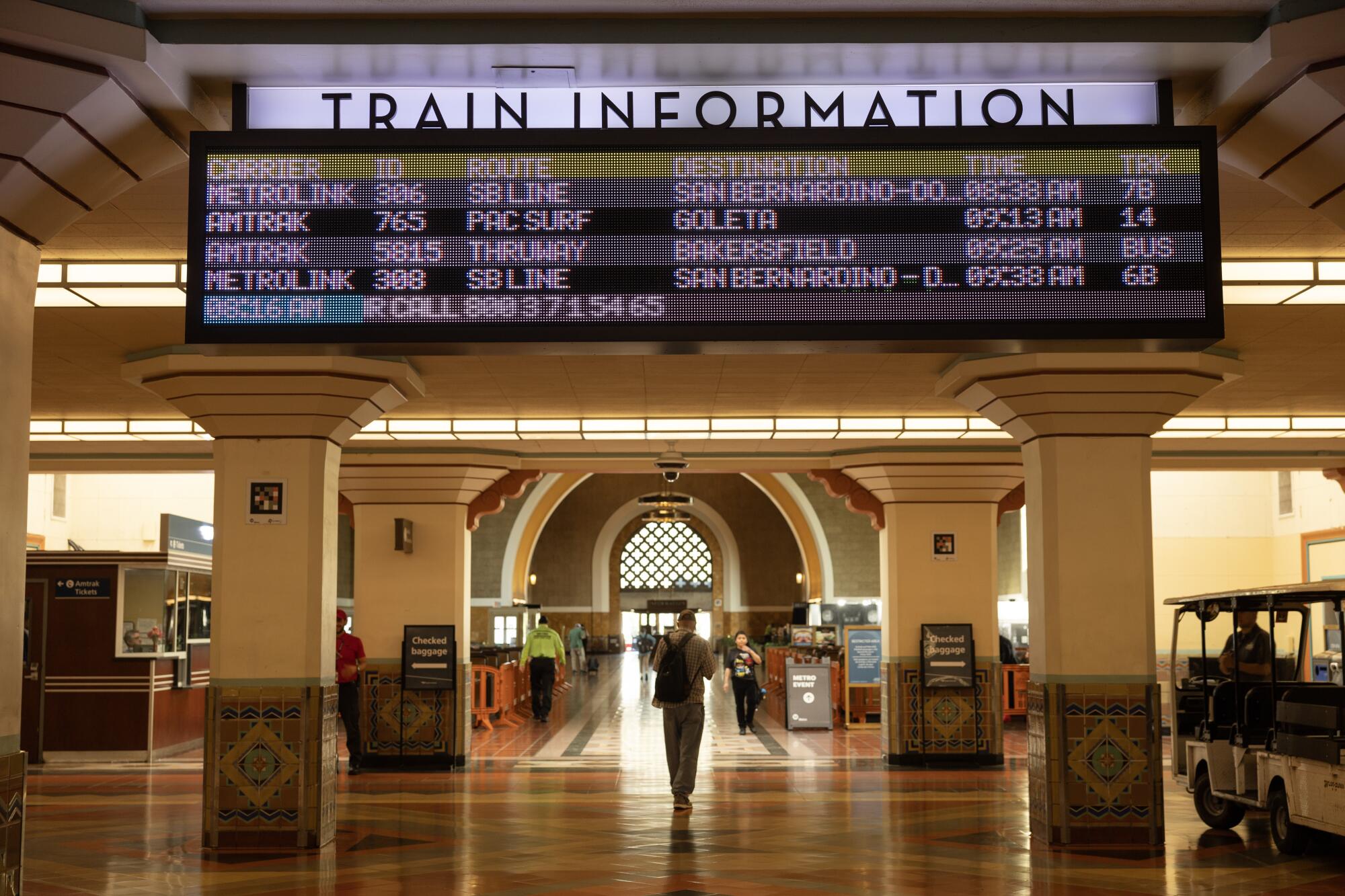
If you’re looking to avoid a hectic LAX experience during the holidays, think of Union Station as its laid-back sibling. Overnight parking is almost always available in the Union Station East garage for $8 per day. (If you plan on parking there for three or more nights, download and fill out a parking request form from the Union Station website and drop it off in the parking office located at Union Station East.)
Plan to arrive at least an hour before your train’s departure if you have to check luggage, are traveling with family or if you’ve made a specific request for assistance at the station. Otherwise, 30 minutes should suffice. If you have a first class ticket, head over to the Amtrak Station Lounge to enjoy complimentary drinks and snacks while you await your departure.
What to bring
If you are checking luggage, make sure to bring a small overnight backpack that will fit in your room or in the overhead compartment near your coach seat. (Smaller rooms may not fit carry-on luggage and you may need to store it outside of your room, so you’ll want the overnight bag for easy access.) If you need to charge multiple devices, bring a small multi-plug splitter as there is usually just one electrical outlet. Earplugs can dampen the chugging train sounds at night. And carry cash to tip the first-class attendants and waiters.
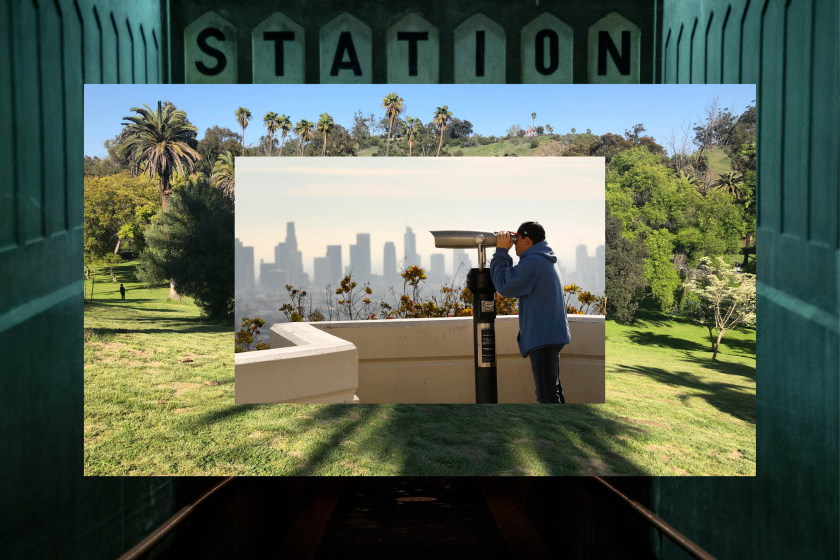
8 L.A. hikes you can get to from Union Station
From Echo Mountain to Griffith Park, these beautiful hiking and walking trails can be reached by public transit.
Jan. 19, 2023
Transportation in Albuquerque and getting to Santa Fe
The Amtrak train will arrive at the Downtown Albuquerque Rail Runner station. From there, you can book a Turo rental in which a vehicle gets dropped off at your location, or visit Enterprise about a mile away (and call the rental office in advance to schedule a free pick-up service). Or take Uber or a free city bus to the rental car center at Albuquerque International Sunport airport, where more options are available.
To get to Santa Fe, you can drive there in an hour or extend your train travel with a ticketed 1.5-hour ride on the New Mexico Rail Runner Express to the Santa Fe Depot Rail Runner station, which is half a mile from downtown Santa Fe.
What to do in Albuquerque
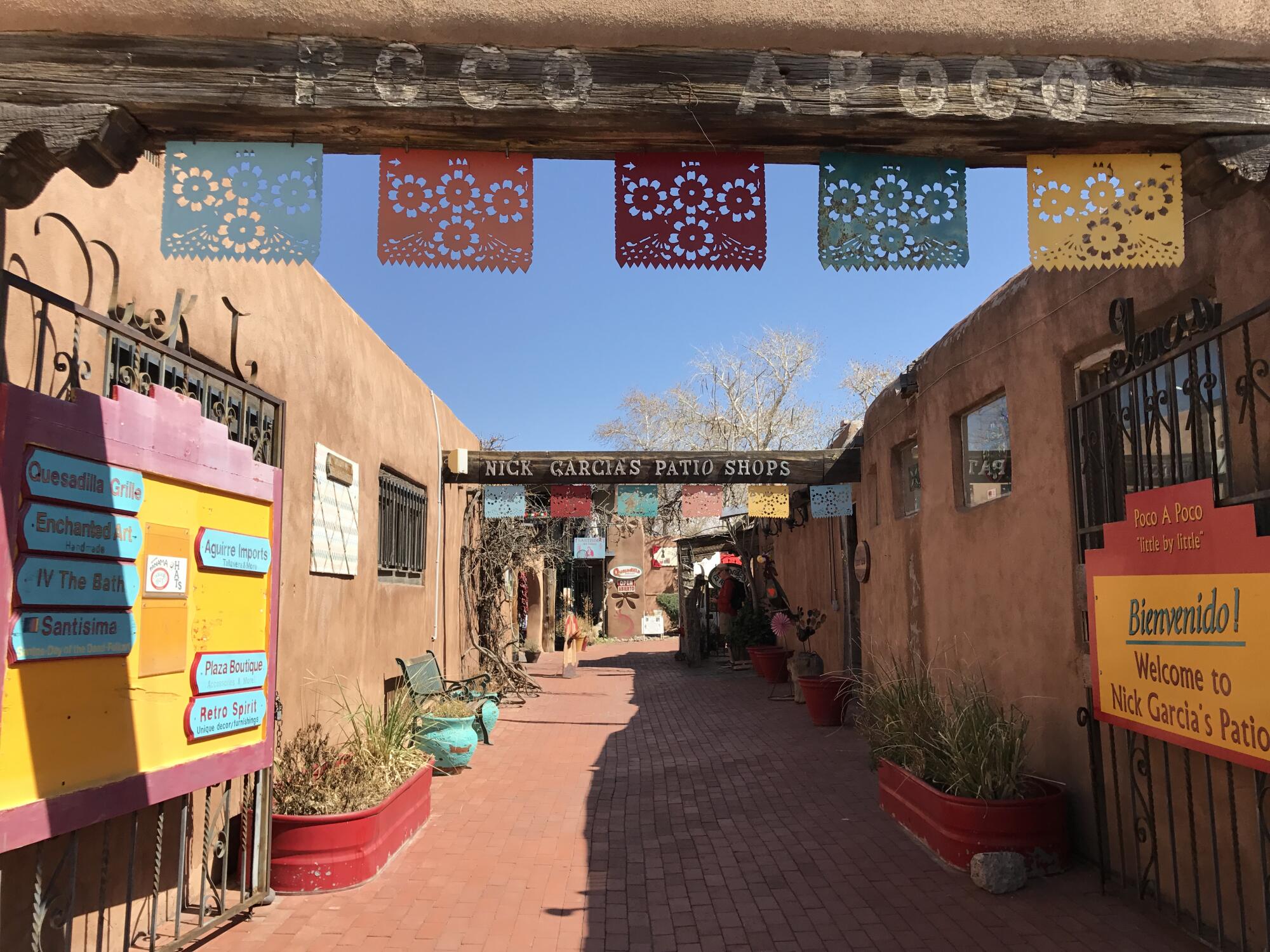
Stay: The historic Hotel Andaluz is a five-minute walk from the Albuquerque station, making it a perfect home base for adventuring. There are plenty of cozy spaces to hide away at this Moorish-style hotel, with stunning casbah-inspired alcoves in the lobby, a library with a fireplace, and Spanish tapas and more at the wine bar Más .
Eat: Grab a New Mexico-style breakfast at the Central Grill and Coffee House , where red or green chile (Can’t decide? Have it “Christmas style,” a combination of both) reigns supreme on such comfort dishes as burritos and chilaquiles. For more modern fare (and more diverse options), hit up the lively Sawmill Market or 505 Central Food Hall for everything from Detroit-style pizza to ramen and tacos.
Do: Old Town Albuquerque is a year-round attraction with Pueblo-Spanish-style architecture, galleries, shops and restaurants, but it’s extra special during the holidays, when its plaza twinkles at night with farolitos, or luminarias, as they’re also known (a Southwest Christmas tradition of brown paper bag lanterns). On Christmas Eve, you can get tickets for a 45-minute Luminaria Tour bus ride that traverses decorated streets. The ABQ BioPark Botanic Garden will host its annual River of Lights holiday attraction from Nov. 30-Dec. 30 with more than 700 illuminated displays on a 1.5-mile walking path. For winter sports, check out Sandia Peak Ski Area, 35 miles northeast of Albuquerque. And for the kids, keep them entertained at the sprawling Explora interactive museum.
What to do in Santa Fe

Stay: During the holidays, the lobby of the downtown Inn of the Governors is transformed into a cozy den complete with Christmas decorations, a roaring fireplace and a daily welcome hour with sherry and biscochitos (the cinnamon and anise-laced New Mexico state cookie). Full service breakfast is included for guests at its Del Charro restaurant and bar, which is open late until midnight on most days.
Eat: Cafe Pasqual’s is packed all day for good reasons: It has solid New Mexico dishes made with local and organic ingredients, it’s in a vibrant space decorated with colorful papeles picados, and it even has a communal table for lone travelers to make new friends. (Make sure to visit its adjacent art gallery while you’re there.) The 71-year-old Shed , also a Santa Fe institution, is a hot spot for margaritas, posole and red chile enchiladas.
Do: The Canyon Road Farolito Walk on Christmas Eve is a longtime Santa Fe tradition, where thousands stroll the artsy thoroughfare to check out the lights. There’s also La Luz de las Noches at the Santa Fe Botanical Garden, evenings from Dec. 19 to 31 (closed on Dec. 24 and 25), featuring farolitos, musical performances, food and drinks. For snow activities, travel 35 miles northeast from downtown to Ski Santa Fe , which will be debuting a new high speed lift this winter. Also, not to be missed is the massive immersive art experience of Meow Wolf , and film screenings at “Game of Thrones” creator George R.R. Martin’s Jean Cocteau Cinema .
More to Read

A swankier way to get to Vegas? See the ‘party car’ on the high-speed rail coming to SoCal
Sept. 17, 2024

First-of-its-kind zero-emissions train rolls into San Bernardino
Aug. 17, 2024
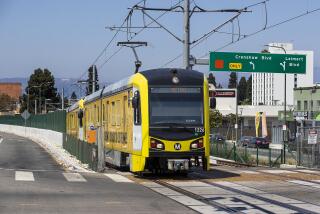
A train from LAX to the Hollywood Bowl? Metro to approve K Line extension routes this fall
Aug. 9, 2024
Sign up for The Wild
We’ll help you find the best places to hike, bike and run, as well as the perfect silent spots for meditation and yoga.
You may occasionally receive promotional content from the Los Angeles Times.

Jean Trinh is a James Beard Award-nominated food and culture writer. Her work has appeared in Los Angeles Times, New York Times and the Washington Post.
More From the Los Angeles Times

Universal rolls out its first all-female monster maze. Here’s why it matters for horror
Sept. 23, 2024

Entertainment & Arts
As arts groups struggle, San Diego Symphony debuts a $125-million makeover

Recess for grown-ups: Join these L.A. groups for double Dutch, dodgeball and more
Sept. 20, 2024

How to have the best Sunday in L.A., according to Tony Hawk
Watch CBS News
Suspect claimed "assassination attempt on Donald Trump," also searched how to travel to Mexico, FBI says
By Melissa Quinn
Updated on: September 23, 2024 / 8:01 PM EDT / CBS News
Washington — The FBI revealed Monday that the man arrested in connection with the apparent assassination attempt on former President Donald Trump earlier this month had in his vehicle a list of dates and venues where the former president had appeared or was expected to appear, and a cellphone found in his vehicle showed searches of how to get from West Palm Beach to Mexico.
The FBI said in the filing that Ryan Wesley Routh, who was identified as the suspect in the incident, had left a handwritten letter with a man months before, addressed "Dear World," that said: "This was an assassination attempt on Donald Trump but I failed you. I tried my best and gave it all the gumption I could muster."

The details were revealed in a court filing from federal prosecutors calling for Routh to remain detained through a trial. Routh appeared before a federal magistrate judge for a pretrial detention hearing Monday, during which he was denied bond and ordered to remain behind bars. Federal prosecutors revealed during the proceeding that they plan to ask a grand jury to return a new indictment charging Routh with attempted assassination of a political figure, which carries a maximum potential sentence of life in prison.
Routh has already been charged with two federal firearms offenses after the apparent assassination attempt on Trump. The Secret Service said Trump was not harmed after an agent spotted a man's face in the brush, later identified as Routh, and a rifle along the fence line outside of Trump International Golf Club in West Palm Beach on Sept. 15.
Federal authorities said no shots were fired at Trump while he was on the golf course, but the agent fired at the suspect, who fled.
CBS News has reached out to Routh's attorney for comment.
Prosecutors said in their latest filing that the suspect was in line with the 6th-hole green, and Trump was playing the 5th hole when the Secret Service agent opened fire. Trump was swiftly removed from the area once the shots were fired, according to the filing.
The FBI found in the fence line an AK-47 style rifle with a scope attached and extended magazine. The gun was loaded with 11 rounds, according to court filings, and the serial number on the rifle was obliterated and unreadable. Secret Service agents also found a digital camera, backpack and reusable shopping bag hanging from the fence, prosecutors said.

The backpack and shopping bag contained plates that "were capable of stopping small arms fire," according to the filing.
Routh was arrested about 50 miles away, after a witness at the golf course shared a description of the vehicle and license plate, prosecutors said. During a search of the SUV, a Nissan Xterra, the FBI found additional license plates, six cellphones, 12 pairs of gloves, a Hawaii driver's license in Routh's name, and documents, according to the court filing. The FBI said the license plate on the SUV was not registered to that vehicle.
One of the phones contained a Google search of how to travel from Palm Beach County, Florida, where Trump's golf course is located, to Mexico, prosecutors said. Among the documents was a handwritten list of dates in August, September and October and venues where Trump had appeared or was expected to go, according to the court records.
Cell site records obtained by the FBI for two of the phones found in the vehicle showed that the suspect traveled from Greensboro, North Carolina, to West Palm Beach on Aug. 14, prosecutors said. The records also showed that on multiple days and times from Aug. 18 to Sept. 15, the day of the incident, Routh's cellphone accessed towers near Trump International Golf Course and Mar-a-Lago, the former president's South Florida residence, according to the court filing.
The FBI also found a fingerprint matching Routh's on a piece of tape attached to the rifle recovered from the fence line at Trump's golf course, prosecutors said.
Law enforcement revealed in the filing that it received information on Sept. 18, three days after the apparent assassination attempt, from a man who said Routh dropped off a box at his house several months earlier. After learning of the Sept. 15 incident, the man said he opened the box, which contained ammunition, a metal pipe, building materials, tools, four phones and several letters, according to prosecutors.
Prosecutors noted in their request that Routh was convicted in December 2002 of possession of a weapon of mass destruction, a felony. He was also convicted in March 2010 of multiple felony counts of possession of stolen goods.
The incident outside of Trump's South Florida golf course has intensified scrutiny on the former president's protection and came just weeks after he was injured in an assassination attempt at a rally in Butler, Pennsylvania.
The gunman, Thomas Matthew Crooks , opened fire from the roof of a building near where Trump was speaking. The former president was shot in the ear and two others were wounded. Another rally attendee was killed.
The attack sparked immense criticism of the Secret Service and raised questions as to how Crooks was able to gain access to the roof so close to where Trump was speaking.
An internal review of the shooting by the Secret Service found there were multiple communications issues with law enforcement at the site and a "lack of due diligence" by the Secret Service.
Acting Secret Service Director Ronald Rowe said Friday that Trump has the "highest levels" of protection," and he praised agents for their work in thwarting another attack on the former president.
"No shots were fired at the former president. The former president wasn't exposed to where he was on the golf course," he said of the incident earlier this month. "The procedures work, the redundancies work, so that high level of protection is working."
- Donald Trump
Melissa Quinn is a politics reporter for CBSNews.com. She has written for outlets including the Washington Examiner, Daily Signal and Alexandria Times. Melissa covers U.S. politics, with a focus on the Supreme Court and federal courts.
More from CBS News

Teamsters in Minnesota, other Midwest states endorse Harris-Walz

Woman arrested in stabbing that injured 4

Man gets lesser sentence for murder conviction in ex's shooting death

Inside the West Virginia facility that helps Minnesota agencies trace gun crimes

An official website of the United States government
Here’s how you know
Official websites use .gov A .gov website belongs to an official government organization in the United States.
Secure .gov websites use HTTPS A lock ( Lock A locked padlock ) or https:// means you’ve safely connected to the .gov website. Share sensitive information only on official, secure websites.
U.S. Department of the Treasury
Media advisory: acting director for the office of foreign assets control lisa palluconi to travel to colombia and mexico.
WASHINGTON – From September 23 to September 27, Acting Director for Treasury’s Office of Foreign Assets Control (OFAC) Lisa Palluconi will travel to Colombia and Mexico to strengthen Treasury’s ties with the sanctions compliance communities. The Biden-Harris Administration’s sanctions authorities, such as Executive Order 14059 signed in December 2021, strengthen Treasury’s ability to combat the global drug trade by targeting drug traffickers, money launderers, and facilitators. Since December 2021, Treasury has designated major drug trafficking organizations based in Colombia, such as Clan del Golfo, and Mexico, including the Cartel Jalisco Nueva Generacion (CJNG) and the Sinaloa Cartel. Last year, Secretary Yellen launched the Counter-Fentanyl Strike Force, which brings together Treasury’s expertise and resources in fighting financial crime, led by the Office of Terrorism and Financial Intelligence and IRS Criminal Investigation.
In Bogota, Colombia, Acting Director Palluconi will provide the keynote remarks at the second United States-Colombia Joint Summit on Sanctions and Anti-Money Laundering Compliance. The summit, funded by the U.S. Department of State’s Bureau of International Narcotics and Law Enforcement Affairs, brings together Colombian government officials and members of Colombia’s banking community in efforts to deepen knowledge of OFAC’s programs and processes while encouraging a bilateral discussion on shared priorities, such as environmental crime and anti-money laundering compliance.
In Mexico City, the Association of Banks in Mexico (ABM) will host Acting Director Palluconi at their OFAC Compliance Workshop. The ABM has long been a close partner for OFAC and the U.S. Embassy in Mexico City. The event will demonstrate the important collaboration between OFAC and ABM in working together to safeguard the integrity of the U.S. and Mexican financial systems, promote shared security and economic prosperity, and ensure Treasury's sanctions programs are understood and effectively implemented.
Treasury’s partnership with the private sector has yielded over the years an enormous success in promoting sanctions compliance and safeguarding the financial system from illicit capital flows.
Florida Gulf Coast bracing for major hurricane hit from Helene: Live updates
(This story was updated to add new information.)
Hurricane and storm surge watches covered much of the Gulf Coast of Florida on Tuesday morning as a system churning in the Caribbean Sea was expected to strengthen rapidly into a powerful hurricane.
The National Hurricane Center predicted the storm – soon to be named Helene – will reach winds of 115 mph before landfall, making it a major Category 3 storm. Forecasters warned the storm could bring life-threatening storm surge, hazardous winds and heavy rain.
The system is expected to intensify into a hurricane by Wednesday and make landfall on Thursday, according to the hurricane center. On its current track, the system is projected to unleash a barrage of threatening conditions across Florida and the Gulf Coast before brining torrential rain as north as Georgia and the southern Appalachians.
“Everyone along the Florida Panhandle and Big Bend region needs to be prepared for hurricane impacts,” said AccuWeather Lead Hurricane Expert Alex DaSilva, adding that the setup has the potential to become the strongest hurricane landfall in the U.S. this season.
Developments :
∎ Florida Gov. Ron DeSantis on Monday declared a state of emergency for 41 counties along and near Florida's Gulf Coast because of threats from the storm. The declaration said there's a significant risk of storm surge and flooding, particularly in areas still recovering from the elevated water levels left behind by Hurricane Debby .
∎ If the storm makes landfall as a hurricane, it would be the fourth landfalling hurricane in the mainland U.S. this year, joining Beryl, Debby, and Francine.
Flooding rains and storm surge forecast across Gulf Coast, Southeast
As Florida braces for the arrival of a potential major hurricane, forecasters are warning the storm will produce widespread impacts stretching hundreds of miles inland from where the storm makes landfall.
Forecasters say the storm system could drop around 10 inches of rain across parts of northern Florida and throughout portions of the Tennessee Valley. Rainfall amounts from 4-8 inches are predicted for much of the Southeast, from southwest Florida to parts of Alabama, Georgia, the Carolinas, Tennessee and Virginia.
“This is expected to be a large hurricane with a major storm surge threat and impacts that will reach hundreds of miles inland from where this storm makes landfall,” AccuWeather Chief Meteorologist Jon Porter said. “We expect significant flooding problems that could reach as far inland as Atlanta and potentially a secondary area of significant flooding in the southern Appalachians.”
Life-threatening storm surge along the Gulf Coast of Florida is also a central concern. Forecasters say water levels could reach up to 10-15 feet above ground level throughout much of the Big Bend region of Florida, which is still recovering from Hurricane Debby, which lashed the area last month , and 2023's Hurricane Idalia .
Along the shore of Tampa Bay, storm surge could reach 5-8 feet above ground level, according to the hurricane center. "The potential for life-threatening storm surge and damaging hurricane-force winds along the coast of the Florida Panhandle and the Florida west Gulf Coast is increasing," the hurricane center said in an update Tuesday morning .
Where is the storm that will soon be named Helene?
The soon-to-be-named storm was located in the Caribbean Sea early Tuesday, where it's forecast to bring dangerous conditions such as flooding and storm surge across the Cayman Islands, the Yucatan Peninsula and Cuba through the midweek.
The storm was located 150 miles west of Grand Cayman and 205 miles south-southeast of the western tip of Cuba, according to the National Hurricane Center's 8 a.m. update. With maximum sustained winds of 35 mph, the system was moving northwest at 9 mph.
On its current track, the center of the system is expected to push across the northwestern Caribbean Sea on Tuesday night before emerging over the eastern Gulf of Mexico on Wednesday.
The system could dump 4 to 8 inches over western Cuba and the Cayman Islands with isolated totals around 12 inches, the hurricane center said, warning of "considerable flooding." Over the eastern Yucatan Peninsula, 2 to 4 inches of rain was expected with isolated totals over 6 inches. Other threats include storm surge and heavy wind gusts.
"Hurricane conditions are possible within the watch areas in Cuba and Mexico by early Wednesday," the weather service said. "Hurricane conditions are possible within the U.S. watch areas late Wednesday and early Thursday."
Hurricane watches issued across Gulf Coast of Florida
In a morning update from the National Hurricane Center, meteorologists issued a hurricane watch for the majority of the Gulf Coast of Florida, running from Englewood, just south of Sarasota, to Indian Pass, in the Big Bend region. Cities including St. Petersburg and Tampa Bay are under hurricane watches.
"A hurricane watch means that hurricane conditions are possible within the watch area," according to the hurricane center. "A watch is typically issued 48 hours before the anticipated first occurrence of tropical-storm-force winds, conditions that make outside preparations difficult or dangerous."
Some areas of the state are under tropical storm watch while a storm surge watch was issued across most of the Gulf Coast, indicating that "there is a possibility of life- threatening inundation, from rising water moving inland from the coastline," during the next 48 hours, according to the weather service.
Concerns mount over rapid intensification
The tropical system in the western Caribbean may not look like much yet, but don’t be fooled. History has shown the Gulf of Mexico can be a pressure cooker, turning systems like this one from wimpy windstorms to devastating monster storms almost overnight under the right conditions.
The storm is forecast to strengthen with potential explosive force in the Gulf. It’s called rapid intensification and it’s happened before . In fact, most of the worst hurricanes in history have experienced rapid intensification , Ken Graham, the National Weather Service director, has said in interviews with USA TODAY.
Read more: Will Hurricane Helene emerge like a monster from the Gulf?
Up to 10 inches of rain expected in some parts of Florida
All of Florida’s Big Bend and parts of southwestern Georgia have at least a moderate risk of excessive rainfall over the next five days, according to the Weather Prediction Center. Elevated stream levels still lingering after Hurricane Debby in August are expected to contribute to the flood risk.
The official forecast calls for rainfall of 4 to 6 inches along Florida’s west coast as well as in the Panhandle, and amounts of up to 10 inches are possible in isolated locations.

COMMENTS
6. Por favor (please) Por favor is undoubtedly one of the most important basic Spanish phrases for travel that you should know. Say this when getting seated at a restaurant, ordering food, asking for things, or making reservations at a hotel. Kids eating a meal in San Miguel de Allende (photo by Clint Bush) 7.
Meeting New People. One of the best parts of visiting other countries is making new friends with cultures and worldviews that are different from yours. Knowing how to introduce yourself in Spanish will make meeting people in Mexico way easier. Here are some phrases to learn: Me llamo ______ [Leonardo]. — My name is ______ [Leonardo]. ¡Mucho ...
If you don't speak any Spanish at all, it's a good idea to at least learn a few phrases before you travel to Mexico. Many tourism industry workers in Mexico speak English, especially in popular vacation destinations, however, if you venture off the main tourist trail, it's really helpful to speak some Spanish.If you don't speak any at all, buy a good phrase book (or an app for your phone) and ...
Greetings & Basic Spanish Phrases. Let's start with the basics. Here are some essential Spanish phrases for greeting people and making polite conversation: Hola (oh-lah) - Hello. Buenos días (bway-nos dee-as) - Good morning. Buenas tardes (bway-nas tar-days) - Good afternoon/evening. Buenas noches (bway-nas no-chays) - Good night.
These Essential Spanish Phrases for Mexico are fundamental to making a good impression and setting a friendly tone in conversations. 1. ¡Qué onda! / Buenos días (What's up! / Good morning) "¡Qué onda!" is a very common greeting in Mexico, especially among friends and young people. It's used to say "Hello" informally and conveys ...
If you travel to Mexico you might be wondering whether you need to learn Spanish. Here's 20 common Spanish phrases you should know before you go.
When traveling to Mexico for work or leisure you can benefit hugely from learning some basic Spanish phrases. Spanish is used by more than a hundred million Mexicans at homes, schools, businesses, healthcare institutes, restaurants, tourist attractions, and all kinds of organizations across all type of industries.
Other essential Spanish travel vocabulary includes ordering food and drinks at restaurants or coffeshops. "La cuenta, por favor" means "The bill, please" and is a polite way to ask for your check at a restaurant. "Una cerveza, por favor" means "A beer, please" and is a simple way to order a drink. With a few basic phrases under ...
Here you can find the translation of the 50 most important words and expressions into Mexican Spanish. If you are about to travel to Mexico, this is exactly what you are looking for! We will teach you: How to say Hello! and Goodbye in Mexican Spanish! To say please and thank you in Mexican Spanish! How to say yes and no in Mexican Spanish!
El vestíbulo — The lobby. 5. Spanish Travel Phrases for the Restaurant. Probably the most useful travel phrases you will need are the ones you would use in a restaurant. Let's go over some basic restaurant vocabulary in Spanish: Ask for anything by using quiero or quisiera — "I want" or "I would like.".
Spanish-speaking countries are especially polite and greeting people correctly will go a long way towards endearing you to the locals, be they friends, people you meet in shops or on the street. #1 ¡Hola! - Hello. (O-la) #2 ¡Buenos días! - Good morning! (BWAY-nos DEE-as) #3 ¡Buenas tardes!
1. Spanish Travel Phrases to Use Upon Arrival. Spanish phrases for greetings and check-in. Ask for help with these chunks. 2. Spanish Travel Phrases When You Need or Want Something. Travel vocabulary in Spanish: Necesitar and Querer. 3. Spanish Travel Phrases for Partying.
Spanish for Visiting the City & Asking for Directions. One of the biggest challenges you may face is communicating with native speakers when visiting the city or a tourist attraction. Here are some of the most common Spanish phrases for travel that you may need in this situation: Con permiso / Permiso - Excuse me.
4. Spanish Dict - although Google Translate is an excellent tool, we suggest this app for traveling through Spanish-speaking countries. 5. El Tenedor (The Fork) - the app has information about over 30,000 restaurants in Spain. You can discover what is around your location, choose the preferred cuisine and book a table.
From basic phrases and greetings to dining, shopping, and navigating transportation, this beautifully-designed eBook has all of the basic Spanish for travel to Mexico! And it's super affordable so it will get you ready for trip to Mexico without breaking the bank! Normal Price: $9.99. Get it today for only $7.99!
Learn the top beginner phrases in Spanish you must know before traveling to any Spanish-speaking country. In this video, I'll teach you some of the most basi...
30 Spanish Phrases for Travel that you MUST KNOW. Travel vocabulary Spanish, great airport Spanish vocabulary, Spanish phrases for traveling to Mexico. Ling...
M exican Spanish is very different from the versions of the language spoken in other hispanic countries like Spain, Chile, Costa Rica, etc. We have our own slang and funny expressions that you're unlikely to find anywhere else. So, whether you're planning an epic trip through Mexico, want to impress your Mexican friends at home, or an expat in Mexico city who wants to blend in a little ...
The majority of islanders you'll encounter speak at least some English. Hotel reception, tour operators, waiters and bartenders in the touristy places on Isla Mujeres are usually fluent. But once you get off the beaten track, the "English" becomes more "Spanglish" so leaning a few phrases will help, plus it's a whole lot of fun!
Hi - Hola. You can use this any time of the day as it means "Hi" or "Hello", but people usually say this and then say one of the other greeting phrases below depending on the time of the day. So, for example, you might say, "Hola, Buenos días.". Good morning. Buenos días. This is normally used in the morning hours before 12 noon.
Speaking Spanish in Mexico: Mexican Slang. San Angel, Mexico City. This is where speaking Spanish in Mexico gets extra fun! Slang is so different no matter where you go in the world but Mexican slang is some of the most interesting. In Chile, to say something is 'cool' you say ' que bacán '. In Mexico, you say 'que padre', which ...
MUST KNOW Spanish words that will help you to get around. Let's be real, I'm not trying to learn the language, I just need ENOUGH basic Spanish for traveling...
Spanish. Hello. Hola the H is silent ó-la. Good morning. Buenos días bwé-nos dí-as. Good afternoon. Buenas tardes. bwé-nas tár-des. Good evening before 7pm.
Reissued after periodic review with updates for Chiapas, and Durango. Country Summary: Violent crime - such as homicide, kidnapping, carjacking, and robbery - is widespread and common in Mexico.The U.S. government has limited ability to provide emergency services to U.S. citizens in many areas of Mexico, as travel by U.S. government employees to certain areas is prohibited or restricted.
To get to Santa Fe, you can drive there in an hour or extend your train travel with a ticketed 1.5-hour ride on the New Mexico Rail Runner Express to the Santa Fe Depot Rail Runner station, which ...
One of the phones contained a Google search of how to travel from Palm Beach County, Florida, where Trump's golf course is located, to Mexico, prosecutors said.
WASHINGTON - From September 23 to September 27, Acting Director for Treasury's Office of Foreign Assets Control (OFAC) Lisa Palluconi will travel to Colombia and Mexico to strengthen Treasury's ties with the sanctions compliance communities. The Biden-Harris Administration's sanctions authorities, such as Executive Order 14059 signed in December 2021, strengthen Treasury's ability to ...
"Hurricane conditions are possible within the watch areas in Cuba and Mexico by early Wednesday," the weather service said. "Hurricane conditions are possible within the U.S. watch areas late ...